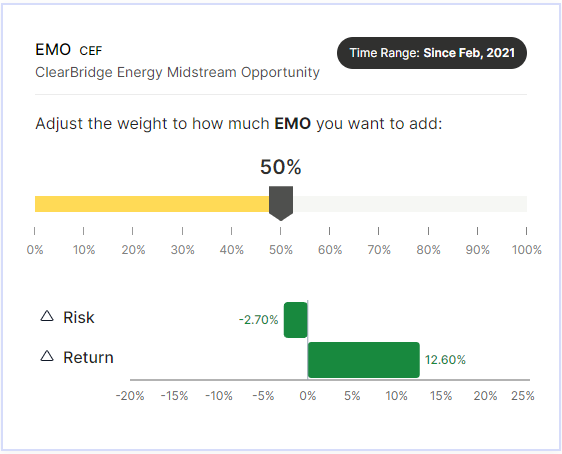
Below you’ll find the current monthly issue and back issues, conveniently all on one page. The beginning of each month’s issue is noted by the publication date.
May 31, 2024 - 3:30 pm
June 2024 Issue
The last month has been fairly eventful for the interest rate markets. We have seen a Federal Reserve meeting, Fed minutes, and countless Fed officials out speaking in public without handlers. If we distill it all down to its essence, the message is simple: we would love to start cutting rates, but it’s not justified by the data. Therefore, rates will remain higher for longer.
As I write this, the U.S. Treasury is struggling with bond auctions that are not going particularly well. The five- and seven-year auctions did not go well, with yields coming in at the top of the expected range. In addition, the Conference Board released its latest consumer confidence numbers, which showed one of the biggest bounces in some time. Despite facing challenges such as high interest rates, inflation, and economic uncertainty, American consumers have demonstrated remarkable resilience, contributing significantly to economic growth in the previous year.
Thanks in large part to waves of government spending related to various programs and policy agendas, the job markets have been fairly robust. Low layoff rates and a tight job market have contributed to income growth and consumer confidence. It has, of course, helped that the consumer market is in much better shape than most of the clickbait hunters and doom-and-gloom crowd want you to believe. Supported by a healthy labor market and rising wages, personal income continues to grow at a pace consistent with previous economic expansions.
Unlike what the headline writers may want you to believe, there is no consumer debt bomb. Since the great financial crisis, consumers have strengthened their balance sheets and resisted the urge to be stupid. Debt levels have gone up over the past year, but incomes and net worth have gone up even faster.
We have seen some signs of developing economic weakness, but it is not enough for the Fed to act. The central bank’s bigger issues are that inflation is sticky, and no one wants to buy our bonds. We have trillions of dollars left to refinance this year, and potential buyers are staying away in droves, due to concerns of political instability and a contentious election. China is out, and Japan has greatly reduced its buying of treasuries. Foreigners looking to buy U.S. credit instruments are increasingly looking to corporate bonds for higher yields and do not feel like they are giving up much in safety when comparing corporate issuers against a dysfunctional government.
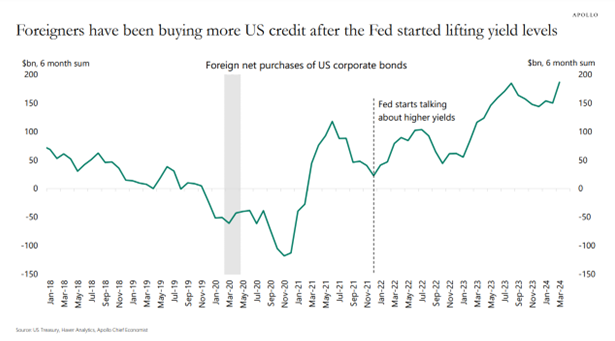
Individual and investment fund demand is also lower than hoped so far this year. The almost constant headlines about the size and growth of the United States budget deficit and debt load are also keeping investors on the sidelines. It probably does not help that the inverted yield curve means notoriously short-sighted, instant gratification-addicted investors can get higher yields in money markets than they can in longer-term bonds.
When something is not selling, you have to lower the price. That is basic economics. In the case of treasuries, you have to lower the price until the yield attracts buyers. Rate hikes and tighter credit have not had the expected impact on inflation and the economy for one simple reason: the government, at almost every level, is spending like drunken sailors with wallets full of back pay, out on a bender. This is an election year, so there is little chance we see a slowdown in spending. Eventually, all of this leads to higher taxes to cure the deficit, but that is a subject for another day. Of course, it is also a great reason to buy the tax-free funds on our buy list.
What does higher-for-longer mean for us as income-seeking investors? First, there is no better place to find the income we are seeking than deeply discounted closed-end funds, which allow us to invest in the attractive corners of the fixed-income markets at a discount from the current market prices. There are so many closed-end funds today that we can pick and choose which sectors we own. Right now, real estate-related debt is clearly one of the most attractive segments of the corporate bond market.
Over the course of my career, I have learned that following the moves of successful private equity funds when they make a big move into a sector is a recipe for success. Blackstone has been on a very aggressive buying spree of real estate-related debt in recent months. As a recent article on KKR’s website pointed out: “Across the market, we are finding that it is possible to lend at a significant discount to replacement cost and often at 50% of peak valuations while earning low-to-mid-teens gross returns on mezzanine-like exposure at loan-to-value ratios near 65%. In other words, it is possible to earn equity-like returns at a favorable position in the capital structure, and the scarcity of debt capital in the market means that these conditions should persist, in our view.”
Last month, the real estate team at Ares Management suggested that a real estate reset was getting underway, with improved property values and real estate-related debt markets beginning to thaw. The alternative credit leader has been raising billions of dollars in recent months to invest in real estate equity and debt opportunities. We have several funds that invest in real estate and CRE debt that are bargain opportunities.
While the activist at the Principal Real Estate Income Fund failed to gain a board seat at the recent annual meeting, we still think the fund is very attractive at current levels. The activists still own a large position and are unlikely to go away anytime soon.
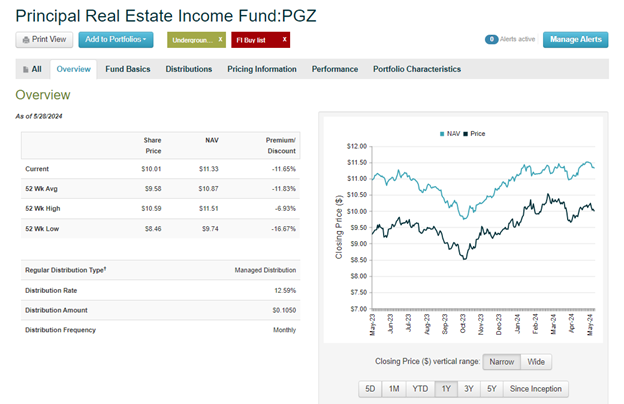
CEFCONNECT.COM
The shares currently trade at a discount of 11.6% with a yield of 12.5%. The fund is invested in real estate-related debt and mortgage-backed securities as well as a handful of REIT equities. You can buy shares of the fund below $ 10.50.
Shares of Nuveen Real Asset Income and Growth Fund (JRI) have recently fallen below the $ 11.55 buy limit.
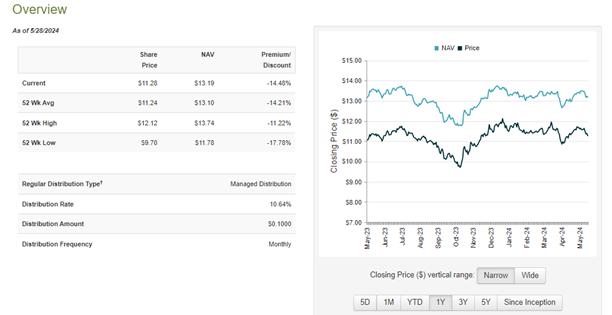
This fund is trading at a 14.5% discount to NAV and yields 10.6%. The fund has equity positions in companies that own real assets like real estate and energy infrastructure, as well as high-yield debt issued by companies that own real assets. Several activists, including Saba Capital, hold large positions in the shares.
Shares of Brookfield Real Asset Fund are also trading below the buy limit price of $ 13.25.
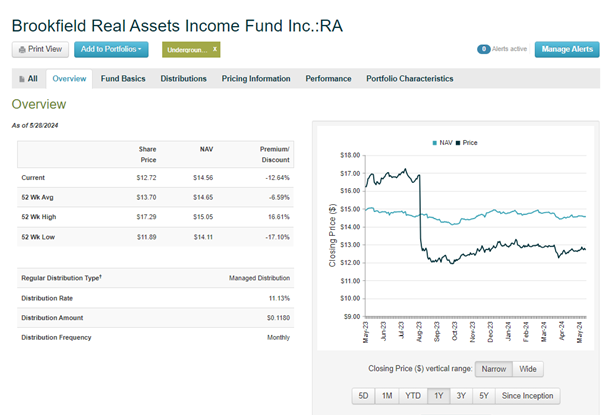
The fund is trading at a 12.6% discount with an 11.1% yield right now. The fund is invested in real estate and energy-related debt as well as mortgage-backed securities. As is always the case, there are several activist shareholders with sizable positions in the fund.
Higher-for-longer means fixed-income assets are more attractive than ever. Our approach favors buying out-of-favor asset classes with a higher potential for a reversal. That is why we own heavily discounted closed-end funds that own real estate assets. All four conditions are met, and we should see a strong upside from the eventual recovery in the real estate markets.
Remember to tender your shares of ClearBridge MLP and Midstream Fund (CEM). Tender all your shares with the expectation that you will receive 50% redeemed at net asset value. The Fund commenced the offer on May 21, 2024, with an expiration time of 5:00 p.m., New York City time, on June 20, 2024.
May 13, 2024 - 11:41 am
Sell Alert – FT Energy Income Partners Enhanced Income ETF (EIPI)
Sell your shares of FT Energy Income Partners Enhanced Income ETF (EIPI) that you received in the recent merger of First Trust New Opportunities MLP & Energy Fund (FPL). The ETF has traded higher since the opening of trade, and it’s time to extend with a healthy total return of over 30% over the 8-month holding period.
April 29, 2024 - 11:42 am
Buy Alert – Invesco Municipal Trust (VKQ)
Buy shares of Invesco Municipal Trust (VKQ). The fund is at least at a 14% discount. The yield is 5% tax-free and we’re seeing buying by activists in the last week.
Use a limit order near the current price and do not pay over $ 9.45 for shares.
April 26, 2024 - 12:52 pm
May 2024 Issue
The secret to getting rich in the markets is not to focus on always making huge returns.
First, huge returns are damn near impossible.
Second, it is impossible to get big returns for long periods of time without being exposed to the potential for huge losses or drawdowns.
Warren Buffett once said that you have no business owning stocks if you are not prepared for occasional 50% declines.
That will happen to you several times over an investing career just investing in stocks.
Adding options, futures, leverage, trading systems, and other risk-elevating devices in the hopes of accelerating returns and big declines will be far more common.
Most people start wetting themselves when they own a stock that goes down by 10% or more.
I can tell you the topic of conversation that will dominate my inbox by the performance of the stock I have recommended.
If we have one stock that is up 20% and one that is down 30%, we will be talking about the down stock.
I have been doing this a long time, and I know that most people are going to puke and put the money into a money market fund, bills, or a tin can buried under the Rottweiler’s doghouse.
As a species, we are risk and loss-averse.
We will do damn near anything to avoid a large loss and be perfectly happy collecting small gains.
One of the most popular marketing tactics for financial products is to trumpet a high winning percentage.
Even if the winning percentage is not constructed using an enormous amount of smoke, mirrors, and deposits from the southbound end of a northbound moose, it usually does not make sense to invest for a high probability of a small loss.
Most of these advertised winning streaks come from selling options, which gives someone else the right, but not the obligation, to buy or sell a stock at a certain price by a certain time. You collect a premium upfront for taking on this risk but you could be forced to buy or sell at a disadvantage if the market moves against you.
If you have sold options on the market since 2007, you have an amazing winning percentage. Your annual return, according to the CBOE data, is about 7%.
Buying the index and reinvesting the dividends would have delivered about 9% returns. Energy infrastructure would have gotten you over 10% a year.
Or you could have bought tax-free closed-end funds at a large discount to net asset value (NAV) that outperformed the more active put-selling strategy.
Some suggest selling put spreads on markets and stocks. But this is picking up pennies in front of a steamroller. You may have a massive winning streak, but when it goes bad, it goes really bad.
In a bear market, selling put spreads will rack up an impressive streak of losses that will test the tolerance of investors who thought they had a low-risk, high-probability path to profits.
Don’t get me wrong. Selling puts is an incredibly effective part of a value-based total returns strategy if properly used. But that strategy must start with the valuation, business fundamentals, and credit condition of the underlying company.
Very few people approach options selling as a total return tool that is secondary to the stock selection process.
Then we have the get-rich-quick approach.
Somehow, folks who know better actually fall for the pitches that suggest there is some surefire way to trade your way to riches.
If I hyped it right, I could have thousands of people sign up for a system that promised 50% gains when you win and only 30% losses when you lose. But you would go broke trading that system.
Every simulation we ran showed that a system with similar levels of volatility would fail in less than ten years.
Consider this strategy. You would have a year of 60% gains followed by a year of 30% losses. That sounds like it should make money, as the gains are twice the losses. At the end of a decade, turns into .76, for an average annual return of slightly less than 6%.
That barely covers the antacid bill.
We ran Monte Carlo simulations that used thousands of simulations of riskier strategies going back to 1986. More than 50% of the time, employing these methodologies went broke.
None of them beat the market, although the top 10% did match the return of the S&P 500.
When we ran simulations with a slight edge over the market and lower volatility, everyone made money, and 75% of them matched or exceeded the S&P 500.
For everyone, the maximum drawdowns were in the mildly aggravating but still sleep-well range across thousands of simulations covering 1986 through last week.
Low volatility returns from a strategy that has an edge over the market is exactly what we are working to achieve with the discount arbitrage strategy we use at Underground Income.
By focusing on the four factors of
- Asset Class Reversion Potential
- Discount to Net Asset Value
- Closed-end fund activist and specialist shareholders
- High Income
We limit our exposure to potentially large drawdowns.
Using concepts that made Richard Rainwater a billionaire, we are not buying funds and worrying about what will blow up. We are buying things that have already declined and have a high probability of reversing course.
We compound the opportunity by only investing in these assets when we can buy them for less than the current quoted price in the secondary markets.
Academic research has shown that closed-end fund discounts often function as a sentiment index, and like all sentiment measures, when they reach extreme points in either direction, prices of the underlying assets or sectors are likely to reverse course.
Popular funds trading at a premium are probably going to move lower over time, and the popularity of the assets they own fades.
Unpopular funds trading at a discount will see the discount narrow as the sell-off stabilizes and bargain hunters and activists begin buying the shares.
There are over 35 years of academic research to prove what I have known for over thirty years: Retail investors will dump closed-end funds when prices fall and the sector falls out of favor.
There are no natural buyers of closed-end funds, so the shares will trade at a discount until bargain hedge funds (like us) begin to buy them.
Over time, the discount will reverse back towards historical norms.
Being impatient patient investors, we want to accelerate the reversion prices, so once the first two conditions are met, we prefer buying funds that have an activist who will work on our behalf to push management to take the steps that will help narrow the discount sooner rather than later.
We also want to collect as much of our return in the form of cash on a monthly or quarterly basis as possible.
We have talked in the past about Hetty Green, known as “The Witch of Wall Street,” a notorious American investor in the late 19th and early 20th centuries. She was known for her frugality, eccentric behavior, and astute investing strategies, which made her one of the wealthiest women of her time.
During the best of times, she invested in income-producing assets, including bonds, such as municipal and railroad bonds. Green was also known for her conservative approach to mortgage lending. She would only lend money to borrowers with excellent credit and substantial collateral, minimizing the risk of default.
When the markets hit a wall, Green would wade in, buying shares of railroads and other critical infrastructure. She would hold them until the markets were hot again and then sell them for massive profits.
If any of her borrowers got into difficulty and missed payments, Green was quick to foreclose during economic downturns.
Despite her eccentricities and sometimes controversial personal life, Hetty Green’s investing approach was ahead of her time. Green often went against popular market sentiment, buying when others were selling and selling when others were buying. This contrarian approach allowed her to find opportunities others missed and avoid overvalued assets.
Take Hetty Green’s income-centric approach that buys what others hate, add a little of the market psychological soup that causes funds to trade at discounts to NAV and a healthy dose of arbitrage, and you have Underground Income.
Flashy returns usually lead to flashy losses. Steady returns with low volatility win the race almost all the time when it comes to investing.
Income, as the heart of the strategy, creates a return stream that cannot be evaporated by market movements.
There will be a time to jump into heavily discounted stock funds. When the time is here, we will act swiftly and aggressively.
Until then, owning discounted energy infrastructure assets, bonds, mortgages and loans that produce huge cash flows offers high returns with low stress.
April 1, 2024 - 3:56 pm
April 2024 Issue
I know many of my competitors are discussing the upcoming elections at length and pointing out how they think candidates may help or hurt the markets.
That sounds awful. We hear enough election and political garbage everywhere else.
In addition, 1600 Pennsylvania Avenue residents have little to do with the stock market’s performance.
The traditional belief that a Republican president is better than a Democrat for the market does not hold water.
Since World War II, the top-performing president, in terms of stock market performance, is Bill Clinton. The second-best performer is Barack Obama.
Following that are Dwight Eisenhower and Ronald Reagan, both Republicans.
Historically, the markets have done better when Democrats are in office than when a member of the GOP sits in the Oval Office.
The best returns result when Democrats have the White House and Congress is either split or controlled by the other side.
Congress, the Federal Reserve, innovation, credit conditions, and geopolitics all have more to do with stock market performance than the president.
Not only is talking about the presidential election and markets awful, but it is also not productive.
We could instead talk about the Fed policy and recent decisions.

Of course, we have done that on most weekly calls and monthly meetings so that would be mildly redundant.
Barring some spectacular event that creates an inflation spike, the next move in the Fed funds rate is down. The only question at this point is when that happens.
We could discuss OPEC’s recent decision to extend production cuts, but I told you months ago that would happen.
We could discuss the need to refill the Strategic Petroleum Reserve, but that will not accomplish much. We are at levels that strike me as nonstrategic, but no one seems to care.
It must be filled at some point, which could create some buying pressure in oil. But we already knew that and talked about it months ago.
I am pretty sure I have hammered home all the reasons for being long energy and fixed income.
I have discussed at great length why I am not yet rushing to buy stock and real estate-related closed-end funds.
Nothing has happened in the last month that changes the reason for our positions or creates an attractive opportunity to add new funds to the portfolio.
On day one, I promised you this would be a rules-based approach to investing, using closed-end fund discount arbitrage and an activist strategy.
I also promised not to break the rules or force trades to serve the marketing department’s interests.
Here are the four criteria that must be met for a fund to be included in the portfolio, just in case you forgot or have not heard them yet:
- The asset class the fund invests in must have underperformed and been undervalued based on economic and market historical measures. Strong evidence backed by fate and statistical analysis must indicate that the asset class is near a point of inflection where the trend reverses. English, the stuff the fund invests in has been going down and is about to reverse course and go higher.
- The fund must regularly pay an above-average distribution. We prefer monthly distributions but can deal with quarterly when necessary. To abbreviate Henry Hill in the movie Goodfellas, with some editing for a mannerly publication like ours: pay me.
- The fund must have a large discount for net asset value. We want to buy the fund’s stocks, bonds, and cash for less than the market value.
- There must be an activist shareholder willing to act on our behalf and force management to narrow that discount.
This creates a portfolio where every position has three ways to make us money:
- The asset class goes higher, lifting the securities owned by the fund higher in price.
- The discount to net asset value is reduced or eliminated.
- We collect lots of dividends.
This month, I want to discuss requirement number four more. Closed-end fund activists’ presence and activity levels have an enormous influence on the funds we select and the performance that results from our ownership of these funds.
Closed-end funds have become an increasingly popular target for activist investors in recent years.
The frequent disconnect between market price and asset value has attracted activist investors who look to unlock value by pushing for changes at the fund level. Some common closed-end activist tactics include seeking board member representation, advocating for fund conversion into an open-end structure, pushing for tender offers or share repurchases, and even a complete liquidation of assets.
Closed-end fund activism has its roots in the 1980s and early investor battles over discounts to net asset value. However, it remained relatively quiet for several decades after that until gaining significant momentum in the 2010s.
One of the earliest high-profile activist situations involved the Japan Equity Fund in the late 1980s. An investor group led by former SEC Commissioner Phillip Lochner Jr. waged a proxy fight over the fund’s substantial discount to its asset value.
The group won the fight, and the fund was turned into an open-end fund, eliminating the discount.
Throughout the 1990s and 2000s, occasional activists like Bulldog Investors and Western Investment LLC targeted certain closed-end funds, but activity remained relatively low. Given closed-end fund boards’ inherent advantages in defending against activists, this was an uphill battle.
The big firms like Franklin and Nuveen had the resources and legal departments to fight off most activists easily.
The watershed moment occurred in 2009-2010 when activist Carl Icahn took a significant stake in several closed-end funds managed by large mutual fund groups. Icahn railed against the funds’ discounts and ultimately got them to commit to tender offers and open-endings.
Icahn’s highly public battle brought new attention to the asset class and its pricing inefficiencies. It paved the way for more investors to allocate capital toward closed-end fund activism as a strategy.
Through the 2010s, players like Bulldog, Saba Capital, FrontFour Capital, and others increasingly targeted closed-end funds. Law firms also began to specialize in representing activist investors in these situations.
The pace accelerated further in the late 2010s as capital poured into the strategy. By 2022, there were an estimated 75 activist situations ongoing around closed-end funds according to industry observers.
Discounted closed-end funds tend to revert to the mean. Numerous studies have shown that they trade at a steep discount when the asset class is out of favor, or investors dislike a particular fund.
In December, two court cases involving Saba Capital further tipped the scales in our favor in a big way.
In the first case, the Second Circuit Court of Appeals found that Nuveen violated the Investment Company Act (ICA) by adding change-of-control rules to its bylaws.
In the second case, The Southern District of New York found that Blackrock also violated the ICA by adding change-of-control provisions to 11 of its funds.
Now, no firm is too big for the activists.
When the fund IPO is done, there is no marketing, so the shares have no natural buyers and will rise and fall with market sentiment.
Sentiment ebbs and flows, so discounts widen and narrow over time.
Here at Underground Income, we like to accelerate this process by favoring discounted funds with activists helping to move it along.
All our funds have activist shareholders. Many of them are currently involved in an active campaign to make changes that would narrow the discount or proxy fight for board seats.
Saba Capital is currently waging proxy fights for Board seats at several Nuveen funds we own. These funds are:
- Nuveen Real Asset Inc and Growth (JRI)
- Nuveen Core Plus Impact Fund (NPCT)
- Nuveen Multi-Asset Income (NMAI)
Be sure to vote for the Saba nominees over Nuveen’s candidates.
Saba has also been buying more BlackRock ESG Capital Allocation Term (ECAT) shares and now owns about 27% of the fund.
The firm has also been adding to MainStay CBRE Global Infrastructure Megatrends Term Fund (MEGI) shares, now owning over 10%.
Bulldog Investors has been buying more Principal Real Estate Income Fund (PGZ) shares and is approaching the 5% level.
Saba already owns over 8% of the fund.
Activist ownership is a must-have in every fund we add to Underground Income. While I am confident that a fund’s NAV will narrow with time, I would instead accelerate the process and force the gains to happen quicker than the usual reversion period.
April 1, 2024 - 11:29 am
Buy Alert – Brookfield Real Assets Fund Inc. (RA)
Buy shares of Brookfield Real Assets Fund Inc. (RA) using a limit order near the current stock price. Do not pay over $ 13.25.
The fund is trading at a 12.76% discount to NAV and yields almost 11% at the current price. The fund holds fixed-income and equity securities issued by companies that own real assets, including real estate, infrastructure, and energy-related assets.
All of these asset classes, including the fixed-income sector itself, are at or near a major inflection point after long downtrends.
After trading at a premium for an extended period of time, we can now own the fund with an attractive discount, and activists have been buying shares.
All the boxes are checked.
March 6, 2024 - 4:34 pm
March 2024 Issue
Your taxes are going up. Everyone will say that’s not the case.
The two nursing home escapees masquerading as presidential contenders will both state that thought-out economic plans will make tax hikes unnecessary. Every lawyer, trust fund baby, grifter, and charlatan running for Congress and Senate will tell you that hikes will not be necessary.
Some of them will express their intention as a desire to raise the taxes on some mysterious group of wealthy people who are not paying their fair share.
Let’s make a few things clear.
First, most of the federal government’s income comes from taxes on the earnings of its citizens.
Second, rich folks are already paying most of the taxes.
The top 50% of earners pay 97% of the taxes collected.
That is not a dream or myth or estimated tax bracket math magic. That is the percentage of dollars collected by the Internal Revenue Service.
This pesky 1% that runs the world and oppresses everyone everywhere all the time? They pay 45% of the taxes collected by the government’s elite and extraordinary combined collection agency and police force.
That amount has been going higher, not lower.
“Soak the rich, tax the rich, eat the rich” has been a constant slogan and practice amongst politicians of all stripes (it’s also the title of a great book by the late PJ O’Rourke that points out that stifling the rich may not actually be a great idea).
The problem is that if you have accumulated any amount of wealth in your life and have the silly idea that you want to use it, the government wants a cut.
If you decide that now that you are older, it is time to take the trips you denied yourself and acquire the luxuries you went without while trying to build a decent nest egg, the government wants a cut.
Like the Sicilian Mafia dons of old (and not so old), they politely insist they be allowed to “Wet their Beaks.”
Of course, should the decreed percentage of the fruits of your labor not be surrendered on a timely basis, the fine people of the government’s gentle revenue collection agency will become far less polite in their request.
According to government watchdogs OpenTheBooks, the IRS has been spending several million a year on guns and ammunition.
The IRS does not have a competition target shooting team. It is a take-and-pay arrangement. You pay it, or they will take it.
The reason your taxes are going up is simple. The people we keep sending to Washington are addicted to spending money. Money buys votes. Votes buy power.
Reducing spending means cutting programs. If you cut programs, the people who lose benefits will not vote for you again. The last time we had a balanced budget was 2001. We have only had a balanced budget or a surplus fourteen times in the last fifty years.
Every year, the thundering herd of fiscal zombies, all 55 of them, return to Washington and propose spending more than they confiscate.
They borrowed money by issuing Treasury bills, notes, and bonds to make up the shortfall. The herd disguised much of it by selling bonds to the Social Security Trust Fund. As long as it had more workers than beneficiaries, there was a significant surplus every year that could be borrowed.
That is coming to an end as the pool of workers shrinks, thanks to an aging population. The ratio of workers to Social Security beneficiaries is expected to shrink from 5.1 in 1960 to 3.4 today to 2.1 in 2030.
The Treasury is becoming more dependent than ever on the marketplace to buy our bonds and pay for the largesse granted by the honest and honorable beings that make up Congress.
It is not getting any better any time soon, according to the Congressional Budget Office. The deficit will total .6 trillion in fiscal year 2024. It is projected to grow to .8 trillion in 2025 and then return to .6 trillion by 2027. After that, the shortfall increases every year, reaching .6 trillion in 2034.
As pointed out on our recent call, we have about trillion of debt to refinance this year. Add in the deficit, and we will need to borrow somewhere between and trillion this year.
We already have trillion in debt. It is going to increase every year.
According to Treasury.gov, as of January 2024, it costs 7 billion to maintain the debt, which is 17% of the total federal spending in fiscal year 2024. That is about triple the global average.
Zimbabwe, Lebanon, and Mexico are among the nations that pay less interest as an expense of the budgets that we do. No other developed nation comes anywhere close to a 17% interest expense.
All the spending and borrowing must be paid for by somebody. Unless you fall in the bottom 50% by income (less than ,000 in household income or ,000 as a single person), that someone is you.
If you have most of your money in a retirement plan that is sheltered from current income tax, you can move your assets into fixed income to take advantage of the massive opportunity that exists in the current economic and market environment.
If you have accumulated a stack of cash outside a retirement plan, moving your cash into fixed income will incur taxes.
Interest from corporate bonds is taxed as ordinary income and is taxed at your total tax rate.
If you use fixed-income strategies with unsheltered money, a full third or more may go to Uncle Sam to pay for studying Russian cats walking on a treadmill, promoting Egyptian tourism, teaching lab monkeys, or gambling (these are actual U.S. government expenditures during the 2023 fiscal year).


If you would prefer to keep the interest you earn and spend it to take your spouse to Paris (or anywhere else), go on a cruise, or buy a vacation home at the beach, another option is available.
Tax-free municipal bonds pay interest that is exempt from federal taxes. If you happen to live in the state where the bonds are issued, the interest may also be exempt from state and local taxes.
Thanks to a quirky twist in the tax code that is in no one’s best interest to fix. bonds issued by Puerto Rico are exempt from federal tax as well as state and local tax in all fifty states.
When I was a broker, tax-free bonds were one of my favorite investments to sell to investors who needed income.
State and local governments issue them, so they are considered almost as safe as U.S. government bonds. Regular as clockwork, the interest check hits the account every six months.
The money raised by tax-free bonds is used to build schools, airports, roads, bridges, hospitals, and everything else our local government provides to make life more efficient and pleasant. Tax-free bonds pay for power plants, universities, water and sewer systems, and other critical infrastructure.
Tax-free bonds are one of the largest subsectors of the closed-end fund industry because they are easy to sell.
Safe, necessary, and tax-free. It is an easy sell.
Once issued, they become subject to the same buying and selling impulses of any other security listed in the psychological soup of the markets.
Tax-free closed-end funds can trade a premium or a discount net asset value.
When they are at a discount, we can buy these very attractive fixed-income securities at a discount to the market value of the tax-free bonds a particular fund owns. Once the discounts get close to 15%, it becomes a massive opportunity,
Add in the fact that we are at the end of a rate hike cycle, and the Fed will start cutting rates later this year, and the opportunity is even more significant.
Now consider that the closed-end fund activists are working harder than ever to narrow discounts, and the opportunity is starting to be turbocharged.
I added two more tax-free funds ot the portfolio this week.
The Nuveen AMT-Free Quality Muni Inc (NEA) invests in high-quality bonds not subject to the Alternative Minimum Tax (AMT).
That is a special tax that the government likes to collect if you are too good at avoiding taxes. I will spare you a lengthy explanation. If you are subject to it, you know what it is. If you are not, it does not matter.
The fund trades at a 14.68% discount to net asset value and has a distribution yield of 4.6% free of federal income taxes. This is the equivalent of a 7.6 % taxable yield.
Several leading activists and closed-end fund specialists own the fund. The largest holdings in the fund are supporting dormitories at Universities in New York, bringing water to Las Vegas, maintaining and expanding a turnpike in Texas, and building a hospital in Colorado.
The fund invests in lingering maturities, so it should appreciate dramatically during a rate-cut cycle from the Federal Reserve.
I also added the BlackRock MuniHoldings Quality Fund II (MUE) to the tax-free portfolio.
This is another fund specializing in high-quality bonds of longer maturities. The shares trade at a discount to NAV of 13.99% and have a distribution yield of 5.4%.
If you have cash outside the protection of a retirement plan, tax-free closed-end funds should be your go-to investment choice in the current economic and market environment.
February 28, 2024 - 11:15 am
Two new positions today for the Underground Income Tax-Free Portfolio:
1. Nuveen AMT-Free Quality Municipal Income Fund (NEA)
I want you to buy shares of Nuveen AMT-Free Quality Municipal Income Fund (NEA) using a limit order near the current price. Do not pay over $ 11.15 per share.
The discount to NAV is over 15%, and the distribution yield is an attractive 4.76%. For the latest on NEA, click here.
2. BlackRock MuniHoldings Quality Fund II Inc. (MUE)
Buy shares of BlackRock MuniHoldings Quality Fund II Inc. (MUE) using a limit order near the current stock price. Do not pay over $ 10.10 per share.
Most of the major activists and specialists own shares and the current distribution yield is 5.4%. Click here for the latest news on MUE.
For both of these, I’ll have more details on our next call and in the new issue.
Talk to you soon.
February 7, 2024 - 9:45 am
This month, we are going to venture off into the wilds of the world and the markets.
Our first stop is going to be emerging markets. I will reinforce the idea that you need to be sure you own shares of the Morgan Stanley Emerging Market Domestic Debt Fund (EDD). The tailwinds of falling inflation, falling global interest rates, and a weak dollar should combine to deliver fantastic truths. The fund is already up 15% this year, but we are just getting started.
The current conditions for emerging market debt look like they have in previous periods where emerging market local debt has rallied. The currencies are cheap relative to developed markets, and the yields of government and high-quality corporate bonds are higher.
In the past, these conditions have resulted in long-term markets that gave adventurous investors huge returns. The fund returns income only, and the yield is currently 7.84%. The discount to net asset value is 15% right now.
The top ten countries that the Morgan Stanley Emerging Markets Funds is invested in include some places that you might not want to vacation. Still, the economies are growing, interest rates are well above U.S. and European levels, and the fixed-income returns should see strong tailwinds from the three favorable factors.
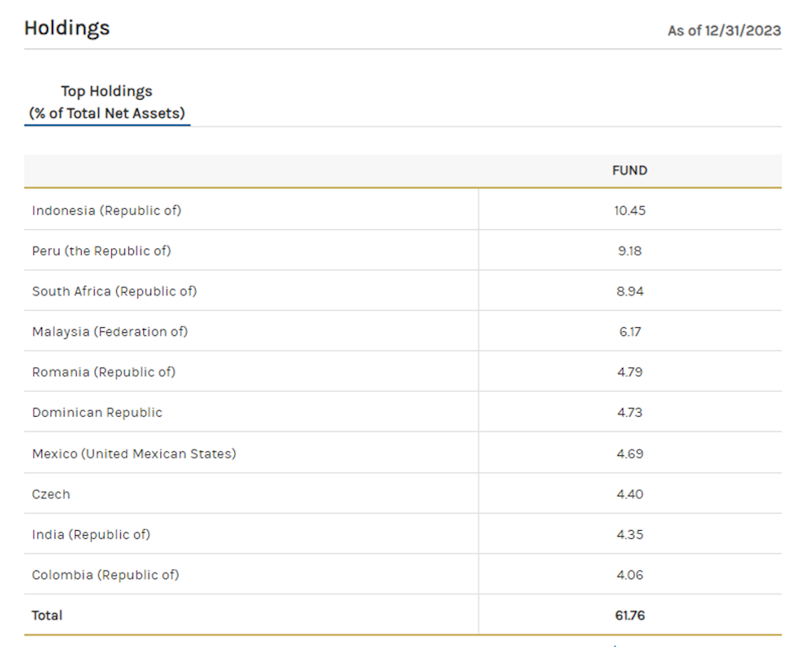
Emerging market fixed-income performance has been flat for a long time. The U.S. dollar has been strong for more than a decade, which has limited gains.
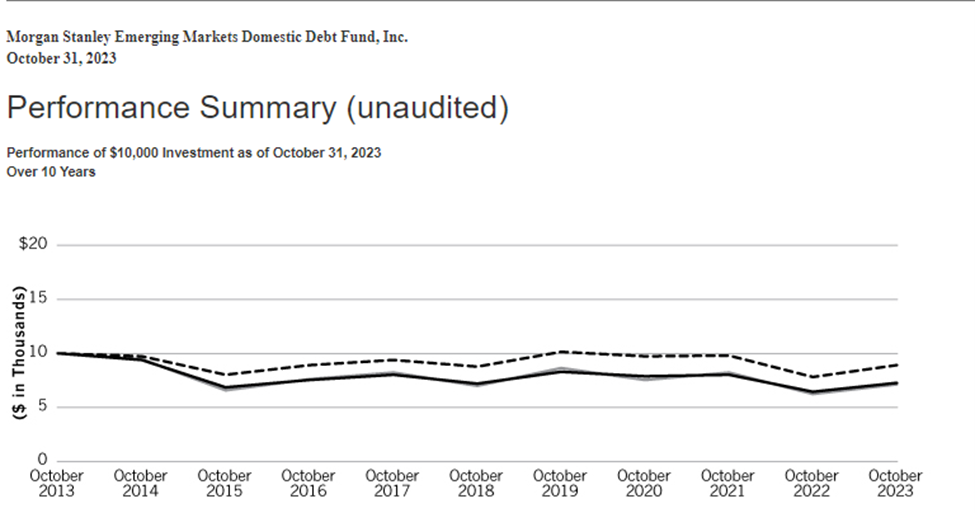
While the emerging market stories of China and India are well known, that’s not the case for the fund’s top holding, Indonesia. Indonesia is now considered an upper-income country and is a member of the G20. It is currently the seventh-largest economy in the world, ranked by gross domestic product.
Indonesia is expected to keep experiencing solid economic and population growth for several decades. The country is resource-rich, with a large agricultural base producing commodities including rice, palm oil, peanuts, rubber, and other items for domestic consumption and export markets. Seafood is also a massive industry for Indonesia: the country is the world’s largest producer of tuna.
Indonesia is also expanding its mining operations in critical metals, including copper, nickel, gold, and coal. Despite all the climate change discussions, coal is still a growing market, and reports to other emerging markets should continue to be strong. Indonesia will also be a significant player in the transition to green energy, as it is the largest producer of nickel and the second largest producer of cobalt.
While Indonesia may be an emerging market, its credit rating is right up there with many of the more developed nations. S&P assigns the nation a BBB rating with a “Stable” outlook. So does Fitch Rating Service.
I could go through all the top ten nations, but that would take too much time and be far too dull for most readers. Suffice it to say that these countries have vibrant economies and will be able to pay their bills, meaning there is nowhere near the level of credit risk that most investors will automatically associate with the phrase “emerging markets.”
If you do not already own this fund, add it to your fixed-income portfolio as soon as possible. You can pay up to .80 for your shares.
I did add a new fund to the portfolio last week—yet another infrastructure fund.
Private infrastructure is one of the best-performing asset classes available to investors; however, most people skip it because it is not exciting.
But, I’m telling you: it should be exciting.
While infrastructure is not going to offer you the promise of turbocharged get-rich-quick schemes, what it does offer is far more realistic and valuable. Private infrastructure, both energy and non-energy, offer steady returns that allow you to compound your wealth at a high rate for long periods of time. When things go south in the economy and markets and turbocharged promises turn into massive real losses, infrastructure prices hold up much better than the price of stocks and keep throwing off steady streams of cash.
While the Ecofin Sustainable and Social Impact Term Fund (TEAF) owns some traditional energy infrastructure, it also has a substantial interest in renewable infrastructure, including private investments in solar farms and wind assets, as well as water-related assets and other valuable, cash-producing infrastructure projects.
The fund has also been involved in financing not-for-profit senior living facilities. Considering that 10,000 Americans a day are turning 65, the need for these facilities will be enormous.
The lack of new projects has helped the nonprofit facilities maintain high occupancy rates. This model has fared much better than for-profit facilities in recent years.
Financing charter schools is another unique infrastructure investment strategy the fund uses to deliver inflation and economic-proof returns for investors. Charter schools currently serve 3.7 million students in 7,996 schools across the United States, and I expect that number to grow substantially.
While most projects are in the United States, TEAF has infrastructure assets worldwide. The Ecofin fund does own a lot of private investments, but most of them are things like schools and solar farms that are relatively easy to value.
The market’s fear of private investment has caused put the shares at a discount to the net asset value of 23%. At the same time, most of the projects owned by the fund are throwing off large amounts of cash, and the shares are yielding 9.5%. Dividends are paid monthly and are reported on IRS Form 1099. Once again, the magic of closed-end fund accounting turns partnership income into ordinary dividends, with no K1s or tax hassles.
Tortoise is the primary advisor of the fund, which has been a target of SABA Capital and other activists in the past year.
Tortoise was once thought to be too big to tackle for activists, but Boaz Weinstein has laid that idea to rest, and all closed-end fund managers and sponsors are now targets if the discounts to NAV of these funds are too wide.
This is apparent when you consider that Saba and Weinstein have scored yet another win against mutual fund behemoth Franklin Templeton (BEN). Franklin is the parent company of Clearbridge, the sponsor of a portfolio holding ClearBridge MLP and Midstream Fund (CEM).
The fund announced last week that it would be merged into ClearBridge Energy Midstream Opportunity Fund Inc. (EMO). The merger value will be based on the NAV of the respective funds at the time of the completion of the deal.
Even with the merger it’s interesting to see what impact adding EMO to your portfolio could have using Magnifi (it’s free for my readers.
Try it now, click here.
Prior to completion of the merger, it will conduct a tender offer for up to 50% of its shares at 100% of net asset value for 50% of the outstanding shares. Make sure you tender 100% to get the maximum 50% acceptance. If you tender 50%, you will only sell 25% of your shares back to the fund.
With the most recent Federal Reserve announcement, Wall Street was shocked that Jerome Powell and his team indicated they were not ready to lower rates yet. The Fed statement proclaimed that: “The Committee does not expect it will be appropriate to reduce the target range until it has gained greater confidence that inflation is moving sustainably toward 2 percent.”
Apparently, traders were surprised by that. But I am not sure how surprised you get to be when government officials tell you something they have been telling you they would say to you for weeks in advance.
While core inflation is down, the Fed wants to see more data, and feel confident that inflation will fall below the target rate of 2%, before signing off on cuts in the fed funds rate.
There is no longer any discussion of possible hikes. Barring some inflation spike caused by energy prices or some other geopolitical disaster, this rate-hiking cycle is over. The question has now shifted to when, not if, on the subject of rate cuts. The timing of the cuts will determine if this is wildly bullish or insanely bullish for our fixed-income funds.
I would like to get some near-term shock to the interest rate markets to add aggressively to our tax-free funds at better yields. We were just getting started with tax-free promotions when rates began their rally last year and have just recently begun to trend sideways or slightly lower. Hopefully, there will be some news flow that will cause the downward drift to continue.
Our two overweights are infrastructure and fixed income, so we are perfectly positioned for whatever happens next.
While we would love to get more money to work in small-cap funds and funds with significant real estate holding, I will not break the rules to do so.
We have scored multiple wins from activist activities in our funds so far. We continue to collect above-average income streams, and the latest addition to the portfolio increases the amount of cash hitting your account every month.
Be sure to join me for our next live monthly webinar later this month. You can get the link and watch the most recent replay here.
January 2, 2024 - 8:00 am
I am writing this on the 27th of December, and we have more than accomplished my major goals for Underground Income in 2023:
1. We have collected a dividend yield greater than the junk bond market, and with far less risk.
Our total return so far this year is more than 15%.
If we can compound in the mid-to-high teens while ignoring the broader stock market, we should be able to help total return-oriented investors compound their wealth at a pace that helps them reach all their goals and financial dreams.
That does not match the gain of the S&P 500, but that was never our goal – as I’ve grown to appreciate in the years when the markets tank.
2. We easily outperformed the bond and oil markets.
This wasn’t exactly a goal, but it is quite an achievement—especially given that we were massively overweight fixed income and energy assets all year—so it’s worth including here.
While I pay attention to what is happening in the markets and am well-versed in macroeconomic and geopolitical affairs, they are not the driving factor in selecting discounted closed-end funds for the Underground Income portfolio.
There are four factors that go into that decision-making process:
First, we must feel like the asset class is due for a reversal.
This is not based on headlines, opinions, or feelings—it is pure math. We want to buy significantly undervalued assets, and I do not care if they are stocks, bonds, real estate, or commodities.
I am also impartial to the distinction between foreign and domestic assets for the most part. The overriding question is whether the assets are undervalued to the point that a reversal in the near future seems imminent.
The math leads us to favor those sections that bombed out, and that everyone hates. More than three decades of being a deep value investor with a huge contrarian streak has taught me that the math is correct most of the time.
People’s opinions and feelings are much less important than math when it comes to markets and investing. Leave your feelings and opinions for the holiday dinner seating arrangements (although if I could use math for this, I would) and team sports franchise attachments.
Second, the fund must trade for less than the value of the stocks, bonds, real property, and cash it holds.
We are looking to buy discounted dollars. The first thing to consider is the level of the discount to net asset value (NAV). I want to buy funds that trade for much less than the value of the stocks and bonds owned by the fund, and the larger the discount to NAV, the more interested I am in adding the fund to the Underground Income portfolio.
Third, there must be an income stream.
This service is for Income and total return-oriented investors; most of our funds pay monthly dividends, but we have a handful of quarterly payers. Either way, a decent dividend yield is a must.
Finally, there must be an activist shareholder who has a long track record of leaning in management to take the steps necessary to narrow the discount to the net asset value.
I make it a point to know the track record of the activists involved in closed-end funds and prefer the small handful with strong track records of success.
This year, we have seen several activist victories leading to dividend increases, buybacks, trade offers, and mergers, including one pending merger into an exchange-traded fund.
Most recently, ClearBridge MLP and Midstream Fund (CEM) announced that they have reached an agreement with Saba Capital, a prominent activist shareholder, and would be considering a tender offer.
The fund will buy back up to 50% of its shares at 100% of net asset value. In Return, Saba will rescind its nominees for board seats and vote to merge several Clearbridge funds.
When you receive notice of the tender from your broker, tender 100% of your shares. You will get a maximum of 50%, but tender all, or you will get half of what you tender.
This will be another major winner for us, with further gains possible when the merger of the funds culminates after the tender offer concludes sometime in 2024.
Following the four rules above gives us three ways to make money with every fund added to the Underground Income portfolio:
- Asset appreciation: The value of the securities and assets in the fund stops going down and increases in value.
- The NAV discount narrows: This can happen on its own, as fund discounts and premiums tend to be mean-reverting over time. Limiting our preference to funds with proven activists accelerates the reversion process.
- Each fund in the portfolio pays a dividend: You can take it in cash or reinvest in more shares; either way, it is cash paid that cannot be taken back.
You will find that I am a stickler for the rules regarding this portfolio.
I did not pull them out of thin air. Some, I learned from successful, experienced investors who share their knowledge of closed-end discount arbitrage investing with me. Others, I learned through my own experience. I have confirmed all the rules the hard way, by contributing my cash to people who did not bend the rules, tempting as it is to break the rules.
I am not in the camp that thinks all commercial real estate will implode and crash the financial markets. In fact, I have my eye on closed-end funds that invest in commercial real estate. I have owned them before and would love to own them now. However, the discounts never got high enough, and there has been no significant activist activity in the funds.
The same holds true for small-cap value closed-end funds run by the managers I respect. Our conditions were never met, so we never bought a share. I suspect we will get our chance in 2024, but suspicions will not be the deciding factor—we will buy them if and when all four conditions are met. My feelings and opinions will not play a role.
Several of our funds have paid special dividends recently, and as we approach the New year, we have seen a rally of just about every asset class. Stocks, bonds, and REITs have all rallied sharply on the expectation not only that the Fed is done raising rates, but also that cuts are coming sooner rather than later. If that turns out to be the case, then stand by for a sharp reversal of the rallies in stocks and REITs. Rate cuts would mean that the economy is weakening rapidly.
There have been signs of some weakening in things like capital expenditure plans and manufacturing reports from Philadelphia, Richmond, New York, Kansas City, and Dallas. Small business optimism was in the toilet all of 2023. The Index of Leading Economic Indicators was also down all year. However, while the data has shown some weakness, none of it has shown signs of accelerating economic decline that would justify lowering interest rates in the first quarter of the year.
Optimism abounds if you look at the various predictions and estimates for 2024. And when it comes to economic and market forecasts, anytime anything abounds, a healthy dose of skepticism is in order.
Nothing in a mathematical observation of equity markets suggests the basis for a rally that further extends valuation is in the cards; however, that does not mean it cannot happen. It just means that probabilities suggest that returns for the next several years will be low and possibly even mildly negative for large-cap stocks.
If we look at geopolitics and economics, there is a lot more potential for negative surprises than positive ones. The wave of optimism is dismissing one of the most unsettled global geopolitical situations in a long time.
The math of closed-end funds is keeping us mostly out of non-energy-related stocks and real estate as we enter 2024. In my over three decades of tracking closed-end fund activity, discount levels and activist activity have done a decent job of forecasting what is about to happen in markets.
That track record as a prognosticator is as good as, or better than, most people collecting six and seven-figure paychecks to make predictions.
2023 was an excellent year for Underground Income, and following discounts and activist activity in unpopular and ignored asset classes should lead to another good year in 2024.
The recent court decision involving Saba, Nuveen, and Blackrock has set the stage for a supercharged level of activist activity in closed-end funds over the next several years. The victory for Saba, especially, makes it clear that no fund sponsor is too big to tackle anymore.
We are in the first inning of what will be a massive transformation for the closed-end funds, and enormous profits will be made.
Underground Income investors should expect to collect their fair shares and then some of these profits.
December 6, 2023 - 4:53 pm
Right before I began pulling together my notes for this month’s newsletter, I saw the news that Charlie Munger had died.
For those who do not know, Munger was the Vice-Chairman of Berkshire Hathaway, and Warren Buffett’s sidekick and intellectual companion for decades.
It is impossible not to acknowledge that Buffett is one of the most successful investors and sharpest business people of the last 70 years. We also must admit that he is a master of the PR game. Although the blood of a pirate of the bounding main flows through his veins, he hides it behind the persona of a capitalist Santa Claus.
But just ask anyone who was ever on the opposite side of the table from him how much of a Santa Claus Buffett is in reality. He ended up owning Berkshire Hathaway (BRK-A) because he had a deal to sell the stock back to the company as part of a negotiated tender offer. Then, the CEO, Seabury Stanton, tried to chisel Warren out of an eighth of a point. Buffett backed out of the deal and bought the whole company so he could fire Seaborn.
Santa Claus indeed!
Munger was also a brilliant investor and a thinker of an entirely different level than most people. A few hours of reading Poor Charlie’s Almanac, and some of the talks and discussions published in that volume will quickly make you aware that Munger understood things most people don’t even think about on any level.
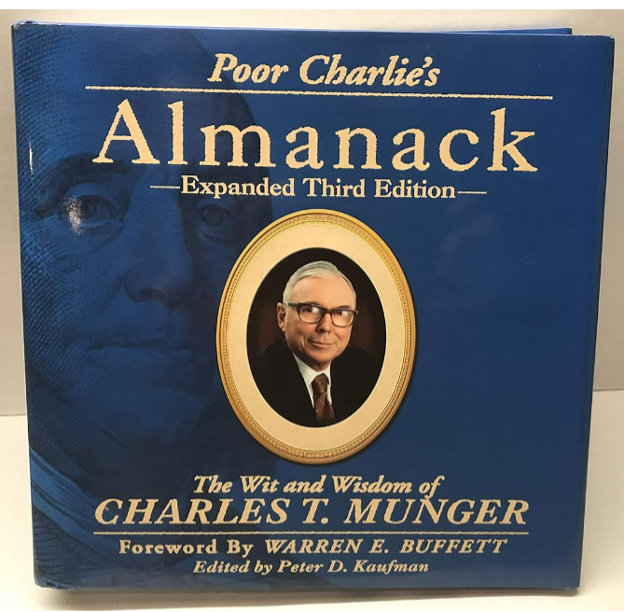
I am not going to rewrite Munger’s obituary. There will be several dozen versions of that spinning around the web by now. There will also be countless “How I knew Charlie” and “How I almost met Charlie one time” stories circulating.
I have nothing to add to those. I never even came close to meeting Charlie Munger. I could have met him at a Berkshire meeting, but he and Buffett were always inconsiderate enough to hold it on my birthday weekend. (The great state of Kentucky throws a horse race for the occasion every year, but the Berkshire Bobbsey Twins never bothered to acknowledge the day!)
I would be remiss if we did not touch on some of the principles that made Munger not just a great investor but a great person.
First and foremost, Munger was a prolific reader. He also said at various points that he never met any wise people who were not prolific readers. His kids referred to him as a book with legs.
I can relate and agree: the biggest favor you can do for your kids is teach them not just to read but to love books. And without my own love of reading, my life would follow an entirely different and much less attractive script.
Munger loved biographies and history. He called reading biographies making friends with the eminent dead. And making friends with the right dead people, Munger pointed out, can make an enormous difference in your life.
He was also a huge fan of being different from everyone else. After all, doing the same thing everyone else does achieves the same results as everyone else. So, given that the average individual investor underperforms the market, why would you shoot for average?
Like me, Munger despised trading. He had a discussion as recently as April of this year with Todd Combs, the CEO of GEICO. He said this about trading:
We have a liquid stock market, which is two things at once—it’s a place for people who are doing long-term investment rationally to go and make their transactions, and it’s a place for another bunch of people to do casino gambling. We mix them up totally. It’s an absolutely insane thing for the country. It’s like we mixed up running the army with child prostitution. It’s ludicrously crazy, but everybody that’s making money out of it loves it this way.
He added that making the casino part of the modern form of capitalism was an insane policy.

By the way, the people making money from trading are NOT the retail traders. The ones making money are the market makers and options statistical arbitrage players. It is often the sophisticated volatility traders who you’re seeing prosper—not Joe Sixpack, trading five contracts because of some super special price pattern.
Working around markets and Wall Street, LaSalle Street, and Wacker Drive, I have met plenty of wealthy people. I have had many drinks with many people in the bars of Rush Street in Chicago who made millions in the options market. They were all floor traders, spread traders, or market makers.
For us mere mortals, the secret to investing success is not short-term, lightning-fast, multi-million-dollar gains—those are the stuff of luck, legend, and leverage. Fortunes, instead, are built by steady compounding of returns without any disastrous losses.
Munger and Buffett emphasized the same principles we use here at Underground Income: price, time, and margin of safety. If we buy the right fund at the right price and avoid taking stupid risks, time (with considerable assistance from closed-end fund activists) will help us compound our money over time.
If income is your primary goal, then Underground Income can allow you to collect high levels of income, most paid monthly, and the combination of asset improvement and narrowing discounts can help offset the ravages of inflation.
As I write this, the news is all favorable for inflation and, allegedly, the economy. The GDP number for the third quarter has been revised up to over 5%, and the inflation readings remain modest. I am writing this before the personal consumption expenditure index, the Fed’s favorite measure, comes out, but I do not expect any massive changes from expectations in that number.
Analysts are falling all over themselves to suggest we will have a magical soft landing.
I really do not expect that to happen.
If you go below the headlines of the Beige Book released by the Federal Reserve last week, consumer spending is slowing—big purchases of stuff like furniture and appliances is down. Employment is flatlining. Retail sales are declining, even as we start the holiday season. Black Friday hit record numbers, but sales were clustered amongst the most heavily discounted items. And the four-week average of continuing unemployment claims hit the highest numbers since December of 2021.
A “soft landing,” in which the economy chirps merrily along while the inflation rate falls below 2% still seems highly unlikely.
That does not put me in the end of America, imminent depression, and riots in the street crowd. Instead, I expect to see a garden-variety recession, with moderate unemployment, sometime next year.
The biggest threat to the suggestion of an economic slowdown is spending by the government. State and local governments are doing their share, but the real culprit is the Federal government. The spending programs in the laughably named Inflation Reduction Act and tax credits for the Green Energy Grift are doing their best to offset the higher interest rates and tighter bank credit conditions that have been slowing the economy.
That does not smooth the path to a soft landing. In fact, it is far more likely to ignite inflation.
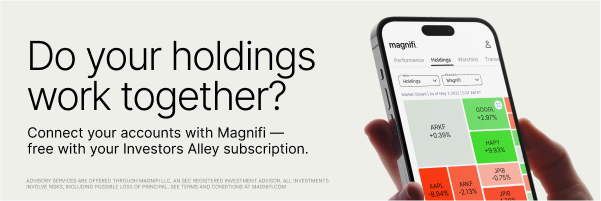 As we go into the holiday season, the markets want to believe in a soft landing. As usual, most participants are only reading the headlines, which in most cases are written to appease those participants.
As we go into the holiday season, the markets want to believe in a soft landing. As usual, most participants are only reading the headlines, which in most cases are written to appease those participants.
Even the soft-landing scenarios include a softer, kinder Fed, lowering interest rates at some point next year. Some scenarios show the Fed delivering cuts at the same pace FedEx delivers packages two days before Christmas, with multiple cuts in 2024.
Whether the cuts come from the kindness of “Uncle Jerome’s” heart or in response to an economic slowdown, they will be outstanding for our fixed-income positions.
There are, however, threats to our outlook.
One is geopolitical. At this point, Ukraine, the Middle East, and China are all still in play. How the markets might react to that is hard to know.
The nice part is that it’s a safe bet that energy and fixed income will react differently and offset each other in the event of an event. Energy moving higher on its own due to market forces or shocks is another risk that could reignite inflation. Once again, if that happens, one part of our portfolio will zig while the other zags, with offsetting price movements.
Under either worst-case scenario, the cash keeps pouring into our account month after month.
The Kayne Anderson Energy Infrastructure (KYN) merger with the Kayne Anderson NextGen Energy & Infrastructure closed this month. As expected, we saw a bump in dividend income, and this is now one of the most attractive funds in the portfolio. The NAV is $ 10.32, and the market price is around $ 8.35—a 19% discount to NAV. For new buyers, the yield is over 10%. And as always, all that K1 partnership income is turned into 1099 dividend income, thanks to the magic of closed-end fund accounting.
This combined portfolio is a collection of the most attractive energy infrastructure assets in the United States. Click here to see how much KYN you own – and decide whether it’s time to add more.
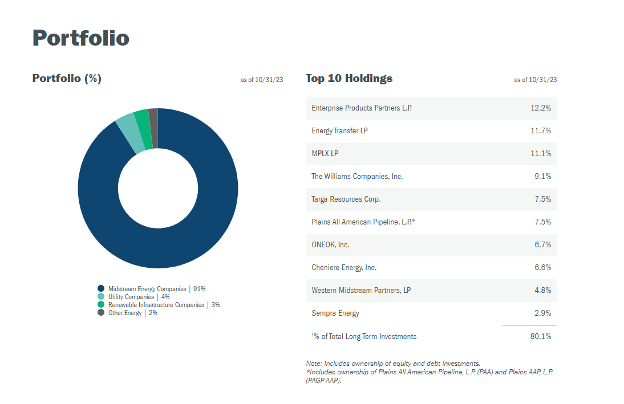
The Holiday season is fast upon us, and however you celebrate this time of year, I wish all the best to you and yours.
Best wishes for a happy and very prosperous New Year.

Click here to see the current Underground Income Portfolio.
November 1, 2023 - 9:00 am
The stock market returns 10% a year—everybody knows that.
Owning stocks is much better than owning bonds. When you consider inflation and taxes, bonds are just certificates of confiscation—everybody knows that, too.
Timing the markets is always a mistake. It cannot be done.
You should stay in stocks and take your lumps no matter what happens. It is the only way us regular folks can make money.
Everybody knows all of that, too.

In the past decade or so, fueled by a race between the Federal Reserve and Congress to see who can pump the most money at the fastest pace into the economy, everybody’s action junkie cousin has decided that the surest, quickest path to riches is trading.

The more leverage, the better. And even better than that, let’s use options so we have an expiration date and know exactly how long we have before we must cash in our massive gains.
Most mutual funds do not match the index returns. Moist individual investors do not match the returns earned by mutual funds. And most short-term traders lose money—lots of money.
We overtrade and chase stories.
The concept of staying in for the long run can be compelling. The problem is that if you pick the wrong decades to be long-term buy-and-hold investors, you tend not to do well.
The problem for most of us is that the worst decades usually follow the ones that were awesome and got us all excited about owning stocks after years of strong performance.
The problem is that we are all human, and humans get excited about their money.
Excited people favor emotional thinking over rational thinking. But emotions and the stock market are like bourbon and grapefruit juice: they just do not mix.
Ruthlessly applying common sense to stock markets can make you more money than all the trading schemes promoters ever dreamed up.
There are often huge changes in the markets. The hard part is to recognize them when living in the day-to-day world.
After World War II, you did not need to be a rocket scientist to realize that the war had revived the U.S. economy: the depression was over, once and for all, and the United States was the premier power in the world.
Once the cost of the war began to recede and all those war vets came home and started families and buying things, an economic explosion was inevitable.
U.S. industry learned a lot during the war, and they used that knowledge to turn out cars, washing machines, ovens, bicycles, baby buggies, and just about anything else the new family could wish to purchase. Homebuilders rushed to build neighborhoods with safe streets, good schools, and white picket fences. Jobs were created making all the stuff people did not know they wanted, and the economy boomed.
On the first day of January 1950, stocks yielded about 7%. The P/E ratio of the S&P 500 was just 7, giving stocks an earnings yield of over 14%
By comparison, high-grade corporate bonds yielded just 2.62%. T-Bills were paying out a little over 1%.
It should have been an easy choice, but stocks were still viewed as being too risky for most Americans. So even though, on average, stocks returned 20% annually in the 1950s, most people missed it.
As the 1960s started, stocks had a P/E ratio of 17, and the yield was down to 3.43%. High-grade corporate bonds paid about 4.4%, and the now available 10-year Treasury paid 4%.
Stocks did okay, with a return of about 7.5%, but things were getting ugly as the 1970s neared.
1968 was a brutal year for the United States. Robert Kennedy and Martin Luther King were both assassinated. The Democratic Convention in Chicago turned into a violent affair with riots and so-called “long-haired freaks” being beaten in the street by Richard Daly’s cops. Congress took U.S. currency off the gold standard. The battle of Khe-San, the My Ai massacre, and the Tet Offensive were in the news and all over America’s televisions.
Stocks were soaring as they had been in the go-go years, and corporate mergers were all the rage. The S&P 500 traded at 18 times earnings. Bargains were so hard to find that Warren Buffett wrapped up his wildly successful investment partnership at the end of the year.
Then, for the next 14 years, stocks were a terrible investment.
The 1970s were ugly. We had not one, but two, oil crises involving our friends in the Middle East. We had Watergate and the first resignation of a sitting President. We had to endure what to me was one of our nation’s low points: disco music. Had it not been for the Grateful Dead, the Rolling Stones, and the Baltimore Orioles, the decade would have been even worse than it was.
Nobody who bought into the long-term buy-and-hold concept in the late 1960s earned any returns over this period. Those who recognized that the world was ugly and stocks were expensive could have purchased corporate bonds and earned about 9% on their money while the insanity swirled around them.
In the early 1980s, there was a massive change in the economy and market, and investors who recognized it made fortunes. Bonds had very high yields, and stocks were very cheap—you could buy high-quality bonds with coupons of over 11% and stocks traded at seven times earnings.
The headlines did not reflect it, but America was ready for change. Paul Volcker was at the Fed, and Ronald Reagan was about to become president. In the first year of the Reagan Presidency, Volcker raised the fed funds rate to 20%, and that was the top in yields. (We have never really come close to that level since.)
Investors in the 1980s who recognized the change in the mood of the country and the waning of inflation made fortunes over the next two decades. But it did not take a rocket scientist to see that valuation had gone beyond high, to stupid levels in 1999 and 2000. Analysts were valuing stocks based on clicks and eyeballs. Earnings were irrelevant.
At the turn of the millennium, we had entered a new paradigm. Stocks had a dividend yield of 1.17%. The P/E ratio of the S&P 500 was 33, giving stocks an earnings yield of just 3%. 10-year treasury bonds paid over 6%, and high-grade corporates yielded 8%. The intelligent choice was bonds over stocks. But no one cared.
If you applied a little logic to economic conditions and valuations, it was clear this could not go on forever.
It is not like there weren’t any warnings.
In 1999, Warren Buffett wrote an article for Fortune magazine suggesting there was no way stocks could live up to public expectations. Jeff Bezos, the founder of Amazon (AMZN), agreed with Warren, telling his employees and the public that they should heed Warren’s warning because a lot of people were going to lose a lot of money betting on the internet.
Over the next ten years, index investors made no money. Tech investors got crushed. As Seth Klarman, the legendary investor who manages the Baupost Fund, wrote in a 1999 report:
Students of financial history can point to historic levels of valuation to suggest that we are in a bubble. However, students of psychology may be needed to complete the picture. For one thing, the financial markets have been so strong for so long that fear of market risk has mostly evaporated. People who used to hold bank certificates of deposit now maintain a portfolio of growth stocks. It is not really within human nature to comprehend that you may not know everything you think you know and, further, that what you believe in could change on a dime.
Investors who applied cold, hard logic and relied on math and not stories could have purchased corporate bonds with yields above 8% and more than doubled their money, while index fund holders lost money.
In the aftermath of the Great Financial Crisis, the Federal Reserve under Ben Bernanke began to take more of an activist role in managing the economy and the market. The Fed started responding to moves in the stock market as much as changes in the economy.
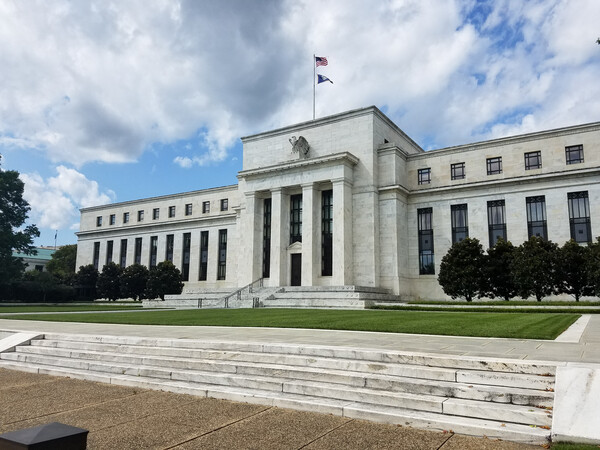
Investors who recognized that the Fed was going to keep rates near zero and that it was going to drive asset prices dramatically higher made a fortune over the next 13 years. Stocks went high. Real estate went higher. And bonds went nowhere.
There is probably a book to be written about the Fed’s turn toward economic activism, but it would take far more time than I want to devote to the effort.
We saw more signs of activism intervention under the Greenspan Fed. When Long Term Capital borrowed enough money and stupidly owned enough illiquid securities with that borrowed money to blow up the world, the Fed got involved and brokered a deal that kept financial chaos at bay. We saw more signs of this leading up to the GFC, but the aftermath of that catastrophe brought Fed activism to the forefront.
I can buy the argument that we needed a zero-interest rate policy (ZIRP) in the short term to prevent collapse. ZIRP is a harder sell for seven years.
Harder still is the Fed taking accommodative action every time stocks sell-off. The era of Fed intervention to protect asset prices was a huge change, and those who recognized it made a lot of money in stocks and real estate. But of course, all those changes were difficult to recognize when you were in the moment.
When valuations were low, and we were at the tail-end of hard times, buying stocks paid off a big deal. When valuations were high, and we were at the tail-end of boom times, the smart choice was to buy bonds and ride it out.
Today, the Fed is letting interest rates rise to fight inflation. The market is allowed to set yields for the ten and 30-year bonds without intervention from the central bank. Fed chair Jerome Powell has no intention of saving the stock market and has made that clear.
The S&P 500 has a dividend yield of 1.65%. The P/E is 24, giving stocks a yield of 4.1%—assuming earnings do not decline as the economy slows, which is a huge assumption. The yield curve is inverted, so short-term rates are higher than long-term rates. Interest rates have stopped going down, breaking a 42-year trend.
Meanwhile, the money market yield is over 5.25%. The ten-year Treasury is flirting with 5%. We can buy BB-rated bonds all day with yields of around 9%. High-grade private credit loans are yielding around 12%. New residential mortgage bonds yield over 7%.
Valuations are high. The mood of the country is sour. The political situation at would be a comedy if it were not a tragedy. There are signs the economy is weakening. There is conflict in the Middle East.
If you had recognized key turning points in the economy and market in the decades since World War II, you would have made an enormous amount of money: catching the key turns of the last 25 years has made you rich.
We’ve had a great run.
But today, it is time to step back from the stock market and look at where we are right now: returns from the stock market from current levels are likely to be subpar. Fixed income returns will be much higher than stock returns.
There is yet another massive change going on that will drive returns that no one is talking about that will make our Underground Income voyage even more profitable: activists are remaking the closed-end fund (CEF) industry.
For decades now, the biggest funds have gone unchallenged. They had too much money and too many lawyers to make it worth it fight with them. Funds issued by industry giants had steep discounts, and there was nothing anyone could do about it.
That is changing. The activists have more firepower than ever before, and they are talking on even the industry giants like Blackrock (BLK)—and winning. The activists will not kill closed-end funds, but the industry will change over the next several years, and discounts will be much narrower.
Buying fixed-income CEFs with activist involvement is going to be wildly profitable as bond yields eventually peak and discounts narrow. If yields stay higher for long, as may well happen, we’ll collect huge streams of cash and benefit as discounts narrow.
As any sailor knows, you cannot change the direction or strength of the wind. You can only change how you rig your sails. Failure to adjust sails when the wind changes will keep you from getting where you want to go.
In the financial markets, the winds are changing; it is time to set your sails.
Using the strategy deployed in Underground Income gives you the perfect chart book and tell-tales to line up your sails to reach your chosen financial destination.
October 4, 2023 - 10:12 am
Oil is rising.
So are bond yields.
Once again, Jerome Powell and the Federal Open Market Committee have succeeded in disappointing Wall Street.
It has become a dance that the pair have been doing all year. Powell and the FOMC tell markets that inflation is still higher than they want to see, and they will be data-dependent when it comes to making decisions about raising rates.
They are very insistent that they are open to more rate hikes if it is felt it is needed. Interest rates, they tell Wall Street, will stay higher for much longer than anticipated. And yet somehow, Wall Street interprets that as “happy days are here again.”
Strategists raise the earnings estimate and price target for the S&P 500, but no one talks about the multiple payments for these earnings. And anyone who talks about valuations is old-fashioned and does not understand.
At least one enlightened individual will suggest rather strongly that the Fed will be lowering rates sometime in the next few months. Reading the hard data is nowhere near as important as interpreting the surveys of economists and (apparently) business leaders and traders who are fierce advocates of legalized marijuana.
Markets will rally because everything is fine, and interest rates will drop soon. The economy will boom. Consumers will keep spending money, and job growth will continue without wage growth being a problem.
We will have a most wonderful and magical soft landing for the U.S. economy.
But back to reality: let’s talk about soft landings for a minute, shall we?
The only soft landing that I recall was the end of the recession in the mid-1990s.
Sometimes, tossing facts in the face of stories is fun. Occasionally, it upsets the storyteller, but sometimes, the storyteller needs to be angry.
Over three years, from 1993 to 1996, the Fed raised interest rates from 3% to 6% to tame inflation—300 basis points in three years.
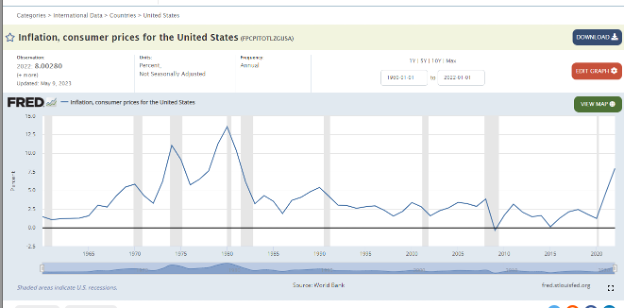
As you can see, inflation was about 3% at the time. The economy kept growing without missing a beat.
So, was it the talent of Alan Greenspan? The genius of Bill Clinton? Or a happy, once-in-a-lifetime accident?
The mid-1990s was a perfect storm of positive events for the United States economy and most of the developed world. NAFTA was passed, and that was good for the U.S. economy. The European Union was formed, which was good for the global economy. The Intel Pentium chip was developed and, in accordance with Moore’s Law, made computing much faster than ever before. The Lithium-ion battery was perfected for commercial purposes, and computing became mobile for the first time. Trade with China was at the beginning of a period of explosive growth. The USSR was gone, and there was only one superpower—us.
The banking industry had recovered from the savings and loan crisis, and bankers were happy to extend credit. Lending standards were not being tightened excessively. In fact, as the Fed began raising rates, most banks were still loose with credit to businesses, and that was good for the economy.
Look at the chart below and compare credit conditions during the “soft landing” to today.
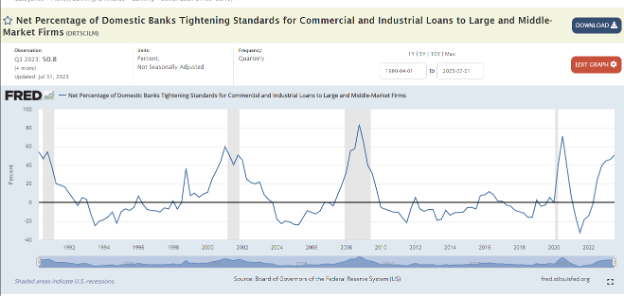
The Fed kept rates stable until Long Term Capital tried to blow up the world in 1998. The central bank had nothing to do with the soft landing.
The explosion of international trade and the rapid advance of technology helped the economy ignore the relatively benign increase in interest rates.
Today, inflation is higher than it was in 1994, even after all the Fed’s efforts to reign in the dragons. Interest rates have gone up 500 basis points in about 18 months. Trade with China is decelerating for more reasons than we have space to discuss. Banks lending standards are very tight. Energy prices are skyrocketing. Oil prices are about five times higher than they were back in the 1990s.
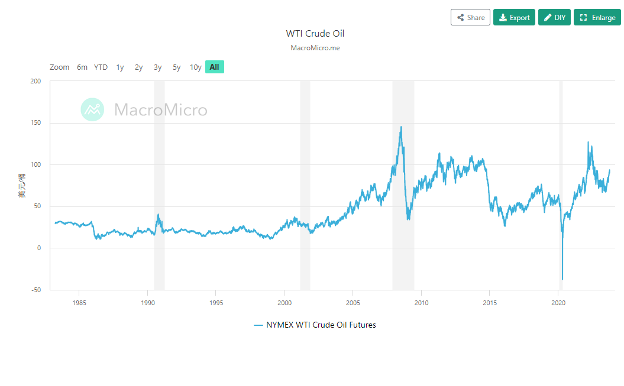
In the 1990s, there were no full-blown wars on European soil to disrupt global supply chains. Europe was not the economic mess it is today. China was not actively working to displace the U.S. on the global stage.
We have seen this movie before.
In 1990, the debate was not about how the country navigated an economic slowdown, the tail end of the S&L crisis, and the junk bond blow-up.
Economists and pundits simply wanted to know how soft the landing would be. For the economy and President George H.W. Bush, it was not a soft landing at all.
In late 2000, a column in the New York Times outlined all the reasons we would have a soft landing. We did not
In 2007, the Dallas Fed suggested we would navigate the subprime crisis with no serious consequences. The consequences surpassed seriousness and danced with catastrophy.
I do not know precisely what the economy will do over the next several months. The data suggests that we will have an economic slowdown that leads to a mild-to-moderate recession. It might be worse than that, but at this point in time, I have no reason to think that will be the case.
There is no data to suggest that we will have a soft landing. Instead, the data suggests that we may see one more rate hike, and then that rates will stay high until we have enough of an economic slowdown for the Fed to feel that rates can be lowered by reigniting inflation.
The forecasts and predictions suggesting rate cuts this year are laughable—the Fed will not lower rates this year. The only way Jerome Powell and company would risk kicking inflation back into a higher gear is if we have a massive economic collapse or a catastrophic geopolitical event—I am talking something of the magnitude of Russia firing on a NATO nation or China invading Taiwan.
Higher-for-longer rates, followed by an eventual cut because of a slowing economy, is a wildly bullish scenario for fixed income. In fact, right now, the numbers suggest that is the most probable outcome.
We gain an edge over fixed-income markets by focusing on heavily discounted closed-end funds. We also collect regular streams of income that make it easier to deal with the current high volatility of the markets.
The presence of activist shareholders gives a potential catalyst for capital gains regardless of market behavior. So does the presence of closed-end fund activist investors who share our conviction that the discount is too wide and should narrow.
The fixed-income funds I have highlighted in recent issues should do well over the next year. We should see the Underground Income Triple Play at work. The asset class will improve as the Fed eventually lowers rates, and we will collect high levels of income on a regular basis, usually monthly.
A combination of activist activity and mean reversion should narrow the discount to net asset value, giving us gains that have nothing to do with market movements.
So far, we have only made one purchase of a high-yield focused fund, and even that one focuses on the higher quality segment of the market. The New America High-Income Fund (HYB) invests in high-yield or junk bonds but has focused on the upper end of the market.
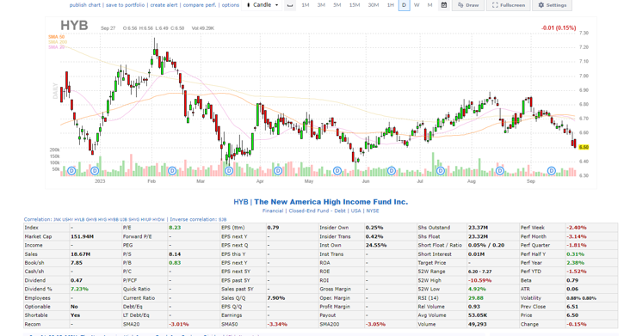
About $ 44 of the binds in the fund are double-B rated.
Those who have been with me for a bit know that double-B, or B.B., is the sweet spot of the bond market and offers the best risk-reward combination in the bond market. 40% is rated B.
Most of the bonds in our fund have maturities of seven years or less. A look at the top holding of the fund shows that they own debt securities issued by companies like Ford (F), American Airlines (AAL), Caesars Entertainment (CZR), Vistra Energy (VST), Carnival (CCL) and Occidental Petroleum (OXY).
This is a relatively small fund with about $ 150 million in total assets. It will need to be merged into a larger fund or ETF to narrow the discount. T. Rowe Price (TROW) is the investment advisor, and it could easily fold HYB into one of its massive high-yield funds.
The current discount to NAV is 16.75%. That is well above the ten-year average of about 10%. There are activists and closed-end fund arbitrage shops on the shareholder list. The abnormal discount could begin to attract attention—and if not, changing conditions in the bond market should eventually cause the discount to return to historic average levels.
The fund pays monthly dividends and yields 7.2%.
I added a new energy fund to the portfolio this month.
I have been vocal about wanting to increase our exposure to energy infrastructure. Tracking activist activity has allowed us to add exposure with a fund that is “in play.” Saba Capital has been actively buying shares of First Trust New Opportunities MLP and Energy Fund (FPL).
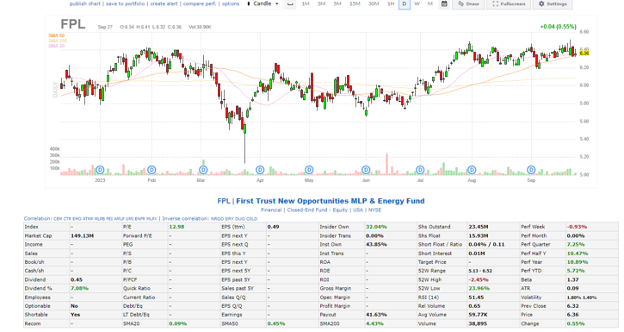
First Trust has historically been one of the fund sponsors that most activists consider too big to battle. But Boaz Weinstein has made it clear that they will battle—and beat—anyone, regardless of size.
As you can see, the fund owns all the usual energy infrastructure MLPs.
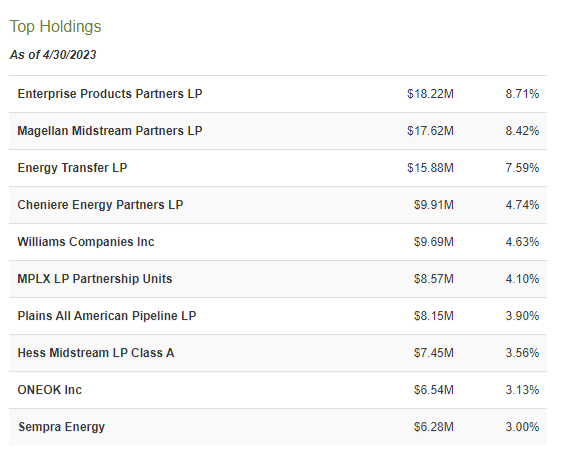
The current discount to NAV is almost 14%. The fund pays monthly and yields 7.1%.
Thanks to closed-end fund accounting, the K1 payments of the partnerships are converted to 1099 income.
I went into deep detail about why we will use fossil fuels longer than the politicians told you during the most recent member’s meeting. That recording is on the website, so feel free to check it out.
As long as we use oil and gas, it will flow through the energy and processing facilities, pipelines, and terminals we own with energy infrastructure MLPs. Those flows will produce dividends that come to us regularly.
All our energy-related funds trade at steep discounts and all have activists and arbitrageurs as shareholders.
September 27, 2023 - 2:12 pm
I want you to buy shares of First Trust New Opps MLP & Energy Fund (FPL) using a limit order near the current price.
I have been looking for more energy funds to add to the portfolio, and the recent filings by Saba Capital led me to this fund.
The activist has been an aggressive buyer of the shares in recent weeks and now owns 8.38% of the outstanding shares.
The fund is currently trading at a discount to NAV of almost 14%.
The yield is currently 7.11%.
Dividends are paid monthly and are reported on a 1099.
Buy shares of First Trust New Opps MLP & Energy Fund (FPL) using a limit order near the current price.
Do not pay over $ 6.75
September 6, 2023 - 11:03 am
What has changed in the world since the last issue?
According to the headlines, there have been enormous changes.
Jerome Powell gave a speech in Jackson Hole, Wyoming. Depending on your preconceived bias, it was either very hawkish or very dovish. Powell clearly stated that interest rates were going higher, or else that they were not going higher.
Banks and commercial real estate are still an existential threat to humanity and will probably cause mass extinction, global depression, and, even worse, stock prices might go down.
In the meantime, the economy is in fantastic shape except for those pesky weak spots that keep showing up in the reports. There will not be a recession, no matter what the yield curve and leading economic indicators say on the subject.
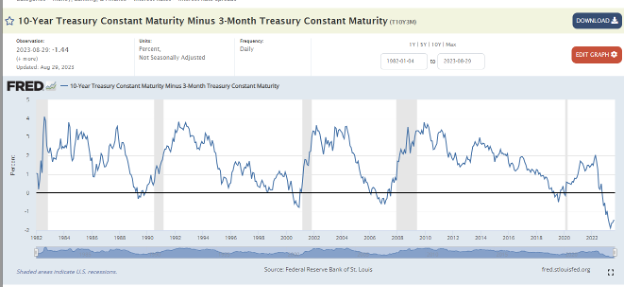
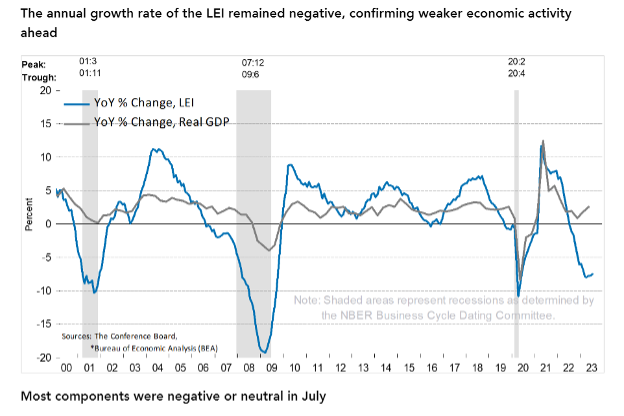
Inflation is completely tamed. Just ignore what the Fed chair and members of the Federal Open Market Committee (FOMC) are telling us. Do not look at the actual numbers showing that the price of everything but energy and used cars is still moving higher.
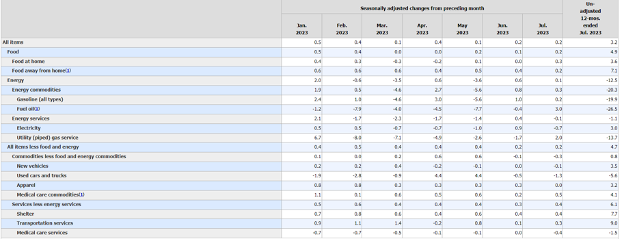
The mix of headlines and data is confusing right now. We have an economy that is still experiencing a high inflation rate, and interest rates have risen at a historic pace since last year.
The jobs market has bucked all historical trends and has been much more robust than most analysts expected once rates began to rise.
And consumers have held up much better as well: after an initial rally in 2021, when inflation began to rear its head, commodity prices have become a mixed bag.
Housing is one of the chief drivers of the economy, so affordability has become a high issue. We have seen some bursts of activity, but the market is struggling to accept the new normal of higher mortgage rates.
It does not help that those of us with sub-4% mortgages (more than 60% of homeowners in the U.S.) have no intention of moving anytime soon.
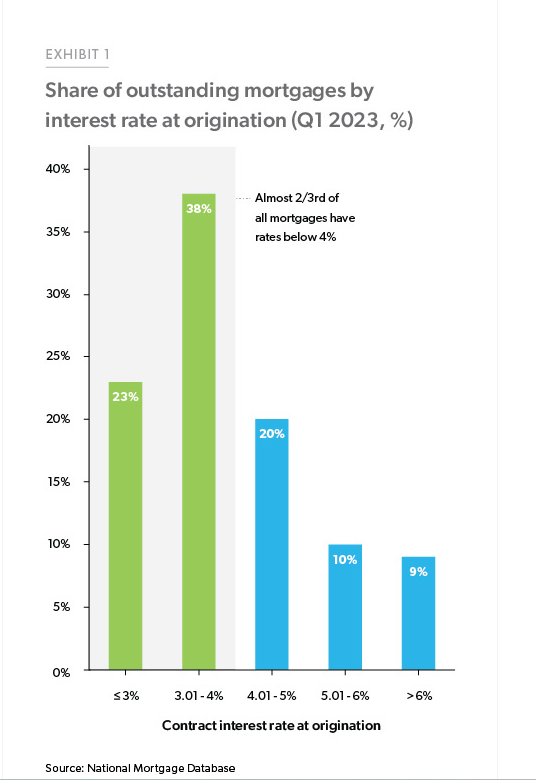
Existing home supplies are tight, and sales have slowed to a crawl.
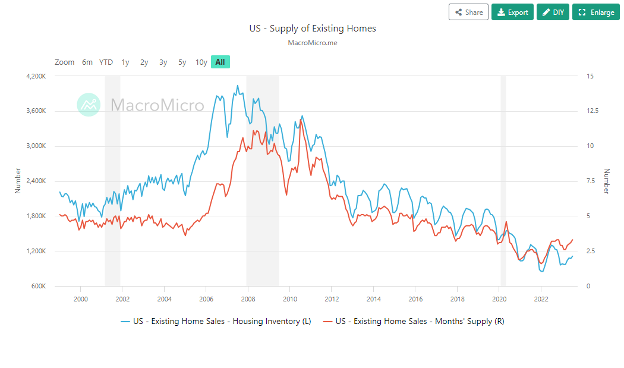
https://en.macromicro.me/
According to the headlines a week ago, the housing market is recovering because of an increase in pending home sales. The leading news outlets and financial media sites report that all is well, and housing will come roaring back. Unfortunately, that is not what the actual data shows, as you can see in the actual numbers from the National Association of Realtors.
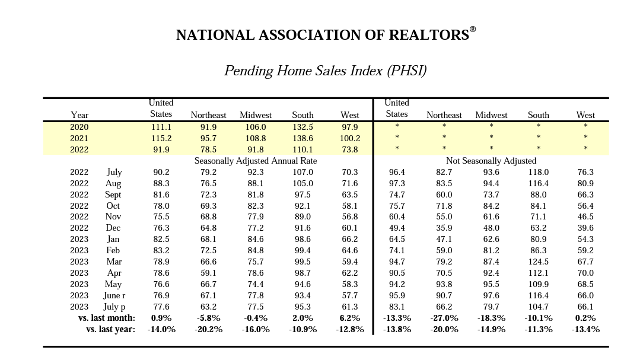
Sales picked up from a month ago, but they are still way down from last year.
No one wants to talk about the fact that underneath the headlines, economic activity is clearly slowing.
If you look at the recent U.S. Purchasing Manager Index from S&P Global, it becomes clear that the wonderful economy the headlines present are a bit light on actual information.
The opening paragraph of the PMI release pints a much more stark view of the economy:
U.S. firms signaled a slower rise in output during August as activity teetered near stagnation across the private sector. Manufacturers dipped back into contraction as production fell again, while service providers saw growth slow to the weakest since February.
Manufacturing was especially ugly:
At 47.0, down from 49.0 in July, the S&P Global Flash US Manufacturing PMI signaled a solid deterioration in operating conditions midway through the third quarter. The decline was the second-sharpest since January, as a renewed drop in output and a steeper decrease in new orders weighed on the overall performance of the sector.
Let me be clear: do not add my name to the list of those who think the world is going to end.
We will not see widespread bank failures, and most commercial real estate problems will be confined to the central business districts where work-from-home practices have changed the demand picture.
Barring some nasty geopolitical turn of events, we will see a nice normal mild-to-moderate recession. It has been inevitable since the post-pandemic cash injections into the economy caused inflation to rear its ugly head.
There is a lag between rate hikes and economic slowdown. Fed actions have lengthened this lag to offset the carefully manufactured banking crisis and persistent spending by state, local, and federal government agencies. While delayed, it has not disappeared, and we are now starting to see the first signs of a slower economy in some of the data.
There will be fits and starts along the way, but the odds still favor a meaningful economic slowdown.
For us, that is fantastic news.
We have been building a position in heavily discounted fixed-income closed-end funds for months now. We are not the only ones who think it is a bargain opportunity, as the leading activists have also been aggressive buyers of these funds.
This has usually been the case. Most of the economic and market data ends up being reflected in the discount levels of closed-end funds. When an asset class is out of favor, retail investors tend to dump shares.
There are no natural buyers for closed-end funds, so the bids tend to fall to levels that reflect steep discounts.
That attracts activists…who then attract us.
I could look at the chart of discount levels and trends of various closed-end funds by asset class and give you a better reflection of what is happening in markets and the economy than you will get from most newspapers and websites.
We continued adding to our exposure to fixed income and activities this month by recommending you buy Nuveen Multi-Asset Income Fund (NMAI) shares.
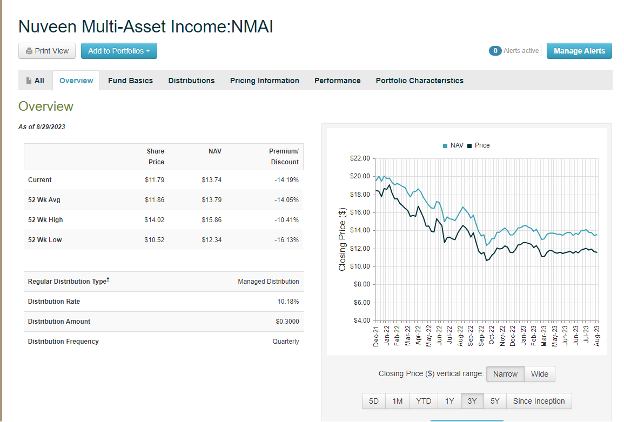
CEFConnect.com
This fund invests in both stocks and bonds from around the globe. About half of the fund’s assets are currently invested in fixed-income and preferred shares; the rest is invested in stocks from around the world. One of the attractions of the fund is that managers apparently share my contrarian bent, and a healthy percentage is invested in out-of-favor sectors like real estate, financials, and utilities. Most of the fixed-income assets are rated BB or better, so it is a higher-quality fixed-income asset. The fund also has large positions in agency-backed residential mortgages and asset-backed high-grade credit securities.
NMAI formed when three funds—Nuveen Diversified Dividend and Income Fund, Nuveen Tax-Advantaged Total Return Strategy Fund, and Nuveen Tax-Advantaged Dividend Growth Fund—merged to create the Multi Asset Income Fund.
The merger created a fund with about $ 650 million in assets that needs to be merged into an open-ended multi-strategy fund.
Nuveen would have been better off merging it into an open-ended fund to eliminate this discount and moving on. Instead, the company just delayed the inevitable.
Saba Capital has been buying shares aggressively and now owns more than 11% of the fund. Saba is tackling the big firms lately and winning, and right now, it appears to have Nuveen (NMAI) and Blackrock (BLK) firmly in its sights.
Other closed-end funds that own shares include arbitrage firms and activists, including Sit Investments, AQR Arbitrage, Wolverine Asset Management, and Millenium Management.
The fund trades at a 14.1% discount to net asset value and yields over 10%.
I also added Nuveen Real Asset and Growth (JRI) to the portfolio. This fund owns real assets, including real estate and energy infrastructure, two of my favorite long-term asset classes.
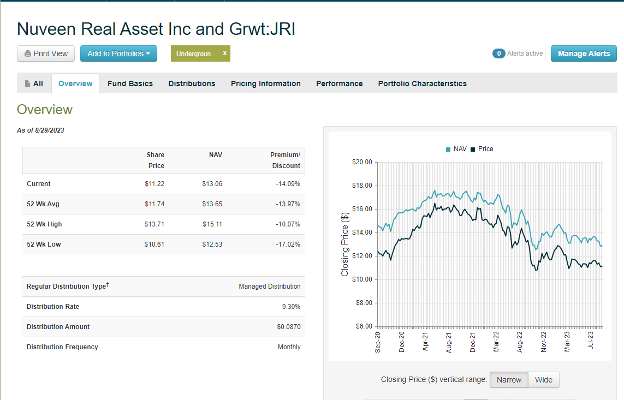
CEFConnect.com
The hard part has been getting real estate at a wide enough discount, and this fund allows us to do precisely that.
The fund is about 50% stocks and 50% debt and preferred shares issued by real asset companies.
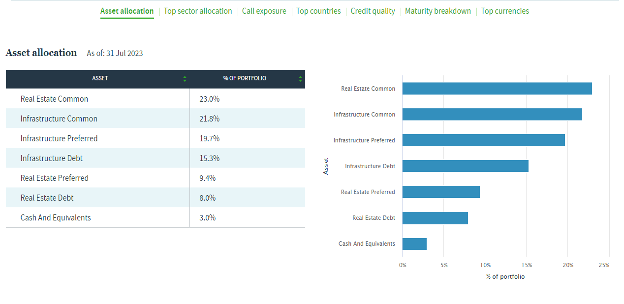
The top ten holdings all fit with major themes we have been embracing and allow us to buy into the major macro trends at a steep discount.
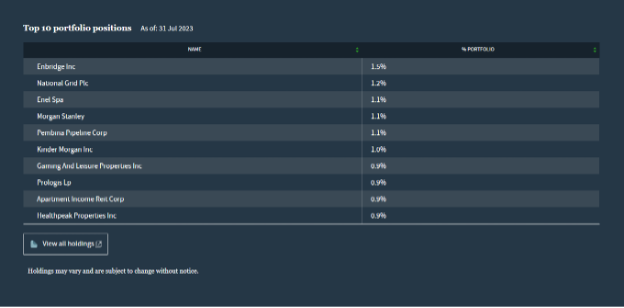
The debt portion of this fund is also mostly BB or better and fits the definition of a high-quality income asset.
Saba Capital is also leading the charge here and recently filed an initial 13d announcing that it owns more than 5% of the fund. Many of the usual suspects are also owners, including AQR Arbitrage, Cohen & Steers, Logan Stone, and Citadel.
The Nuveen Real Asset Fund is currently trading with a 14% discount to net asset value and yields 9.3%
We remain overweight on fixed income and energy infrastructure, and we continue to add to both when we have the opportunity to do so on favorable terms. We are also adding funds with high exposure to real estate when we get the right discount with an activist presence.
We remain almost perfectly positioned for the current environment. It is not my genius as a macroeconomist but the combination of discount and activism that drives the final decision—which, as is often the case, is lining up perfectly with the macro and market conditions ot give us an extraordinary opportunity for robust total returns.
August 29, 2023 - 10:25 am
I want you to buy shares of Nuveen Multi-Asset Income Fund (NMAI) using a limit order near the current price. Do not pay over .92 for shares of the fund.
This is another smaller Nuveen fund that is being targeted by Saba Capital. The fund is trading at a 14% discount to net asset values and needs to be merged with a larger fund to eliminate the discount.
Saba has shown no fear when it comes to taking on the larger fund management companies and Nuveen appears to be in their gunsights along with Blackrock.
Several other activist and arbitrage shops have also been buying shares of the fund.
While the fund does have about half its equity in stocks, a dig through the portfolio shows that it holds a lot of the out-of-favor sectors I favor like REITs, financials, and utilities. The manager also said that they thought US markets were overvalued and had begun selling calls against the fund’s positions.
It also owns corporate bonds and mortgage pools that I think have very attractive total return potential.
The yield is a little over 10% and the dividend is paid monthly.
I will have more details in the upcoming new issue.
Buy shares of Nuveen Multi-Asset Income Fund (NMAI) using a limit order near the current price. Do not pay over .92 for shares of the fund.
August 16, 2023 - 2:37 pm
I want you to buy shares of Nuveen Real Asset Income and Growth Fund (JRI) using a limit order near the current market price.
August 2, 2023 - 6:00 am
You must buy stocks. Everybody knows that. All the books say so.
You must be in it to win it. If you missed the ten best days of the market, you did not make any money. You must own stocks all the time and suffer the drawdowns.
That has been the mantra of academics for decades. 401K purveyors, mutual fund companies, and many brokers also espouse this philosophy. And, it has become accepted gospel for individual investors.
Like all alleged great truths, there is some accuracy to it. Long-term buy-and-hold strategies do work better most of the time than trying to trade in and out of the markets.
However, there are periods during which valuations become so extreme it no longer makes sense to have your portfolio heavily invested in stocks. (If you have firecrackers or small missiles to lob in my direction, now is the time to light them)
Research shows that indicators like the CAPE Ratio and the Average Individual Allocation to Equities identify times of over and undervaluation.
The CAPE Ratio is the 10-year average PE ratio of U.S. companies. When valuations are high, returns over the next decade will probably be very low. And when valuations are low, returns will probably be high over the next ten years.
The CAPE Ratio in the United States is currently 31 and change. It is not quite the most expensive valuation in the world (India and Denmark have higher valuations), but it is close.
The CAPE Ratio currently suggests a long-term return, including dividends, of a little over 3.5% annually. But a long-term 3.5% return will not get us where we want to go.
Do not think it cannot happen. From 2002 to 2010, stocks returned a little less than zero. After hitting a high in 1968, stocks did not break even until 1982. In both periods, devastating declines caused many investors to panic and sell everything, locking in huge losses. But if we sell stocks, we will miss all those big up days that provide all the returns of the market.
If we try to time the market, we will be paupers in retirement. At Christmas time, we will have to knit the grandkids socks using yarn from old sweaters and build them toys from driftwood. Forget the country club—we will be reduced to checking out ancient Wii Golf sets from the library and making sure we never return it late and incur fines.
We must stay in stocks no matter what happens, or we will miss all those big gains everyone talks about. It is time in the market, not timing the market—everyone knows that.
At least, that is what the so-called experts will tell you. Like most self-appointed experts in history, they are full of a certain material that falls from the southern end of a northern-bound horse.
There is some truth to what they say, of course; timing the market in the short term is usually a fool’s errand. I know a few people who can do it, but they have advanced degrees in statistics and physics, as well as extraordinary computing power to assist them in crunching numbers. They could explain how they do it, and it is still unlikely we could replicate their achievements.
And of course, they also eat risk like a tasty snack.
It is a rare combination of brain and computing power combined with emotional and fear control that would make First Officer Spock blush with envy. Even with all of that, all the people I have met who do this have blown up entirely at least once—and most of them, more than that.
However, using the CAPE Ratio and the Average Allocation to Equities like a thermometer, we can measure when the market is so hot that we should stop adding cash and instead take some money off the table.
What about missing those best ten days?
As it turns out, missing those days is not that big of a deal. As Meb Faber of Cambria Investment documented a few years ago, both the biggest up and down days usually occur during bad markets. Missing a big up day when the market hits a new bottom a few weeks later means nothing to your long-term returns. And missing the worst days has added more to your returns than capturing the best days that happen in a downtrend.
It turns out that if you can miss the biggest moves up and down, you beat the market rather soundly.
So, what do we do with all our money when it is not in stocks? After all, everyone knows the best long-term results are made by investing in stocks.
While that is true, it is worth considering that investing in income-producing assets when stocks are too risky has been the source of some of the world’s most enormous fortunes.
Consider John Pierpont Morgan, the financier who helped shaped the modern financial system and financed much of the growth of the United States in the late 1800s and early 1900s. Morgan was a banker. He made loans to new industries and, on several occasions, the Federal Government. He was collecting interest.
When markets made extreme moves, Morgan moved in to acquire companies. When a poor economy caused a borrower to miss payments, Morgan would take over the assets.
Most of the time, he lent money and earned interest. He acquired assets in bad times at bargain prices.
Or you may recall Hetty Green, the Witch of Wall Street—we talked about her in an earlier issue. Most of the time, Hetty was a lender, primarily first mortgages on homes and apartment buildings. When panic selling would set in, as it always does, Hetty Green would eventually become a buyer of stocks and real estate at ridiculously low prices.
In between buying opportunities, Green collected interest. And she was the wealthiest woman in the world when she passed away.
In more recent years, Andy Beal of Beal Bank has had a similar investing story. First and foremost, he is a lender who collects interest. But when markets implode, he becomes an investor.
Beal Bank opened its doors back in 1988 and quickly became one of the most profitable banks in the United States. Thirty-five years later, that is still true.
Following discount levels and activist activity allows us to adopt the same interest-collecting and opportunity-seizing style that has built some of the biggest fortunes in the history of the world.
We will own stocks and real estate. I want to own them—especially real estate.
We have a little real estate via our ownership of Principal Real Estate Income Fund (PGZ). In addition to commercial mortgage-backed bonds, this fund owns several REITs, including favorites like Digital Realty (DLR), VICI Properties (VICI), and Alexandria Real Estate (ARE). Best of all, we own these data centers, casinos, and life sciences properties at a discount to the market price of about 13.5% and collect more than 13% in income payments. And several known closed-end fund activists are large shareholders.
I would love to own more real estate CEFs like this, but the discounts still need to be wider to justify the purchase.
We will get there. We will always do.
As for stocks, they remain the flavor of the day.
I would love to buy into some stock funds, especially small-cap value funds, at a massive discount with a strong activist presence. I just can’t right now. There is no consistent activist buying of equity funds.
That makes sense: closed-end fund activists are arbitrage traders at heart. And at their core, all arbitrage traders are value investors. Value investors do not chase stocks when the CAPE Ratio of over 230 and the trailing PE of the S&P 500 is over 25.
As for the Nasdaq 100 index of tech stocks the market has been in love with this year, the P/E ratio is over 40. The average stock in the index trades at a whopping 16 times the value of the net worth of the individual businesses.
That is not value investor territory.
The time to be an aggressive buyer of stock closed-end funds is when everyone hates stocks. When I see a hedge fund manager on TV whose tie is askew and looks like he has not slept in a week, and I can smell last night’s scotch fumes through the TV, I will start getting excited about adding CEFs that invest in stocks. The discounts will be wider than they are now, and activists will be buying.
Until then, we will collect interest from our closed-end funds.
Our collection of energy infrastructure assets allows us to also function as toll collectors. We collect fees on all the oil, natural gas, and byproducts that pass through our pipelines and gathering systems.
For every drop and whiff of energy processed in a facility owned by one of the companies or partnerships, there is a fee paid, and after expenses, we collect the fee as a dividend. Every time a truck pulls up and takes on a load of fuel in one of our terminals, we collect a fee. When a ship enters one of our terminals, we collect a toll.
The solar and wind farms we own in some of our funds charge the energy companies a fee for producing and transmitting the energy.
Every time a car rolls onto the Dulles toll road, a small percentage ends up in our pockets. The same happens on the Chicago Skyway connecting Chicago and Northwest Indiana. We also own a piece of several toll roads in Europe.
Stocks are too expensive. The discounts need to be higher to get aggressive.
Until then, we will clip coupons and collect tolls.
The beauty of that is that the current valuations in fixed income and the slowing in much of the economic data combine to give us returns over the next years that will make be the envy of most other asset classes, including stocks.
Oil and gas prices may fluctuate, but we will turn on the lights every day and move from one place to another. That requires energy. So does turning on the air conditioner, which has become a very popular activity across most of the United States this summer.
Most of the energy produced in the United States comes from oil and gas. Almost all that oil and gas passes through the assets we own via MLPs and energy CEFs, and we collect a toll.
Of course, some of the energy is produced using renewable sources. We collect a fee on some of that as well.
Coupon clipping and toll collecting. This is what the wealthy do until the markets give an opportunity for extraordinary returns from stocks and real estate.
It is also what we are doing here at Underground Income.
July 10, 2023 - 10:26 am
Please sell NXG Cushing Midstream Energy Fund (SRV) using a limit order near the current price.
July 5, 2023 - 8:00 am
“Still the same.”
Bob Seger was apparently singing about an ex-girlfriend with a gambling problem, but the statement is equally true for positioning investment portfolios with the potential for maximum gains and minimum risk right now.
We are long on fixed-income and cash-producing energy infrastructure. Last week we added to the mist of fixed-income funds, and we plan to continue to do so when we have the right combination of yield, asset direction, and activist involvement.
The recent headlines are fantastic. The May jobs report was excellent. Consumer spending has remained healthy. Housing prices are going up, and people are scrambling to buy the few new homes that are on the market.
All of this points to a strong economy and the probability of a soft landing.
But as always, if you go deep behind the headlines, there is far more to the story than the sound bites.
Consumer sentiment did bounce in June; however, longer-term consumers remain pessimistic about their economic situation. The gap between current confidence and future expectations is at levels generally predictive of a recession.
Markets seem to be forgetting that all this positive news has locked in a rate hike at the July Federal Reserve Open Market Committee meeting. In fact, the infamous “Dot Plots” that show Fed officials’ expectations reveal that the folks running the economy think there will be two more rate hikes this year. That would put the fed funds target rate at 5.75%–6%.
If you look at the headlines, it appears the economy has ignored the Fed’s rapid interest rate increases. The strong jobs market and steady consumer spending have kept the economy going and are why many think we will have a soft landing.
Again, below the headlines, the story changes.
The jobs market has been strong, but unemployment claims are rising. They are not yet at levels consistent with a significant slowdown; still, the four-week average claims are at a high for this economic cycle, well above the lows of last September. And, the length of the average unemployment period has been growing longer since January. Those who are laid off or lose their jobs are taking longer to find new employment.
Wage growth is higher than revenue growth, which is never a good sign. It frequently leads to job cuts as employers scramble to cut costs.
The Small Business Optimism Index continues to plunge—and you know pessimistic business owners do not add employees.
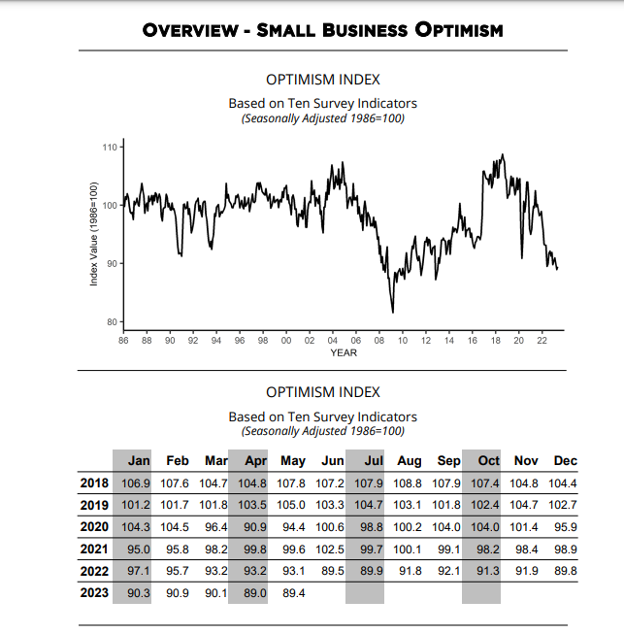
NFIB Research Center
The business owner that wants to hire is having difficulty finding people to fill positions. This is especially true of those positions requiring some training or skill set. The workforce shrank during the pandemic, and it is increasingly obvious that most of those who left have no intention of returning.
Higher interest rates will also limit employment growth. Money spent on interest payments is not spent on hiring new staff.
In the aftermath of the carefully manufactured banking crisis, bankers are tightening credit standards. The prospect of a slowing economy and the likelihood of new regulations concerning capital levels and loan portfolios have bankers adopting a very cautious attitude toward lending. The basic rule of thumb for these periods of tight credit is that if you need a loan, you do not qualify. These levels of tight credit will be a drag on the economy and discourage business expansion.
Okay, Tim, what about that durable goods report? That was much better than the economists expected, proving consumers are still spending.
Yes, durable goods spending rose 1.7% in May, which is fantastic. It proves that consumers are still spending. But the raw numbers do not reveal what consumers get for their cash.
Now let us back out of airplanes. I know a few people who own airplanes. I even know some who bought a plane recently, but it was a refurbished WWII fighter/bomber, so I do not think it counts. And most individual consumers will not be purchasing airplanes.
If we back out the current inflation rate of durable goods, we find that durable goods spending was down slightly in real terms. By the same token, durable goods shipments were up, leading to a decline in inventories at the manufacturer level.
That is because, according to the most recent Purchasing Managers Index (PMI) report, manufacturing activity fell off a cliff. The PMI fell all the way down to 46, well below analyst expectations.
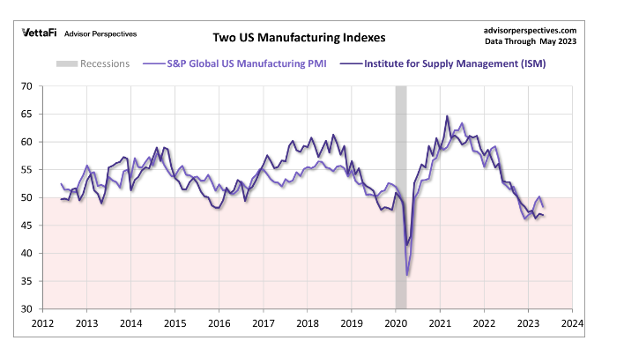
Service sector PMIs remained above the 50 level that indicates expansion, but they did decline.
“Well, Tim, what about those new home sales?” New home demand is up, and that is great for the economy.
Yes: new home sales are up, and it is a tailwind for now.
Let me just say there may not be a bigger long-term housing bull than me. The supply-demand imbalance is enormous and will get larger until we see dramatic changes in the housing sector. It is not just the builders that have excellent long-term prospects. It is the real estate services companies, the brokers, and everyone else who has anything to do with real estate.
According to Zillow, we are currently short 4.3 million homes.
For years we have had more families and households being created than new homes being built.
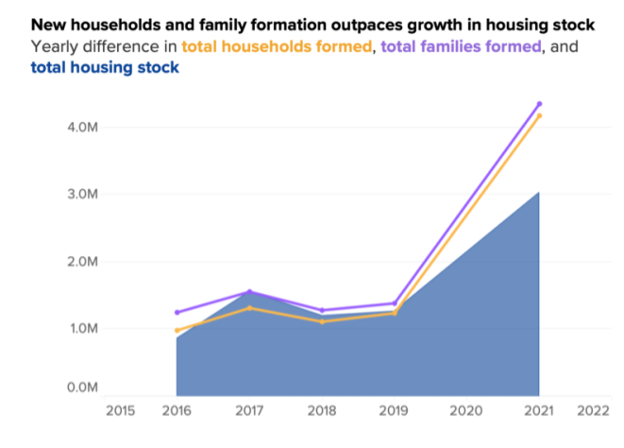
Zillow.com
That was a big deal when we had a few years of historically low mortgage rates. Everyone who could do so refinanced their mortgage to the new low rates. That explosion of home buying we saw in 2020 and early 2021 was done with mortgage rates as low as 2.5%.
Now that rates have spiraled higher, no one with a super-low mortgage will sell their house to buy another with at 7% interest. So, there is no inventory—and this is especially true for middle-income and first-time buyers.
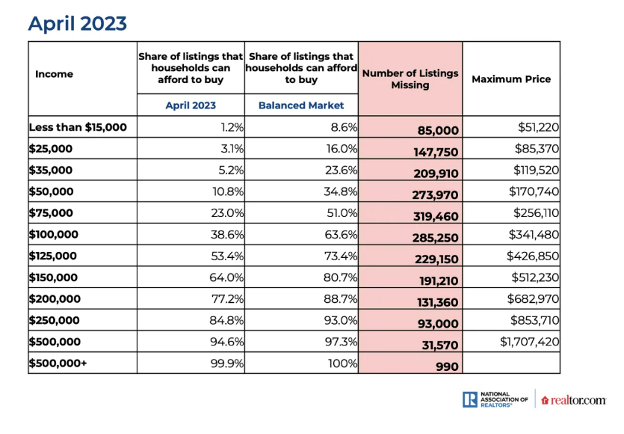
The shortage of homes for sale means buyers who can afford a house and are not scared off by mortgage rates have to buy new construction. There is no other choice.
This has made builders optimists. They have started new developments and other projects to meet this recent demand surge. This building wave will run head-on into the affordability problem and the uncertainty caused by rising mortgage rates.
That combination will moderate some of the building activity later this year.
Do not get me wrong. As I said, I am very bullish on residential real estate. In the other services that I offer through Investors Alley, we have lots of banks with portfolios full of mortgage loans. We own a builder trading at a massive discount on asset values.
For this service, I have a list of brokers and service companies I want to add after what I consider to be the inevitable stock market decline occurs.
I think we are going to see a flurry of building activity over the summer; then, towards the end of the year, we’ll see more rising rates, rising unemployment, declining consumer spending, and tight credit conditions, which will create an economic slowdown.
It is not just me. It is the Fed’s economists. As you can see by the dot plot chart, they all expect rates to be lower next year.
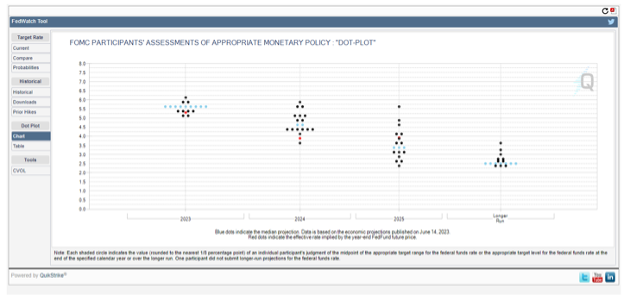
It is the traders at the Chicago Mercantile Exchange that stake millions of dollars on where they think rates will be at a given point in time.
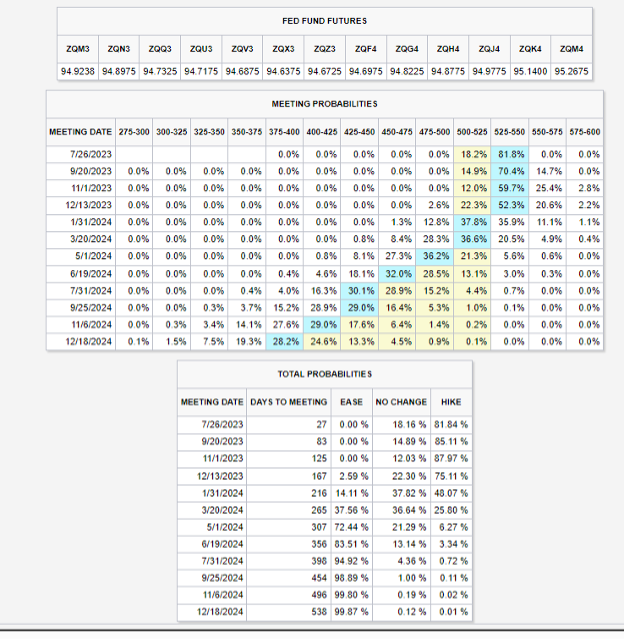
The economy is holding up okay right now. But as the year progresses, more interest rate hikes and tight credit conditions will tip the economy into a recession.
The good news is that the slowing economy will lead to lower rates, which is fantastic news for fixed-income investors.
If the scenario plays out as the Fed economy and smart money traders at the Chicago Merc expect, fixed-income investments should provide double-digit returns over and above the high levels of income we are currently collecting.
Our heavily discounted tax-free funds will perform more like growth stocks than low-risk municipal government bonds.
If the Fed and the Merc (and I) are wrong and the economy keeps humming along, the central bank’s most likely course of action will be an extended pause to see what impact the previous cuts and bank tightening have on the economy.
Keep in mind that 2024 is an election year, and the political pressure from both sides of the aisle to keep rates steady will be high. In that case, we will continue collecting the high levels of income, and there will be activist activity that helps narrow the discount to NAV creating double-digit total returns.
The only scenario that hurts our fixed-income positions is one of hyperinflation, but that would send the value of our energy infrastructure assets skyrocketing. While oil prices have seen some downside pressure, I do not expect energy to stay down here for long. Demand in the second half of the year will outstrip supply.
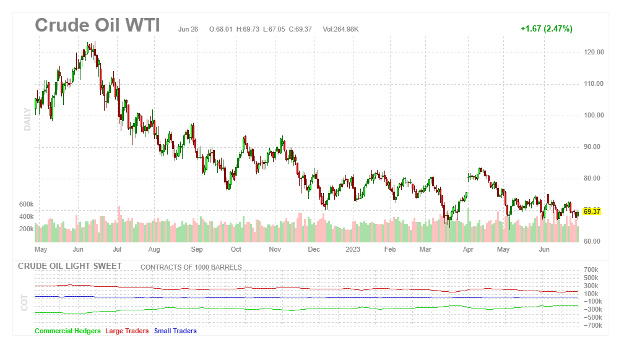
Finviz.com
Should prices remain sluggish, OPEC members—especially Saudi Arabia—have demonstrated they are willing to do whatever it takes to push prices higher and keep them there.
While price can influence sentiment surrounding oil and gas infrastructure, we are far more dependent on oil and gas flowing through the pipelines no matter the price to generate the cash flows we collect every month.
Barring the discovery of low-cost cold fusion using reactors the size of a hot water heater and the invention sometime soon of cars that can be made from biodegradable balsa wood and run on air, oil and gas usage will stay high.
As long as we are using fossil fuels to generate electricity, power factories, fuel our cars, cool and heat our homes, and everything else we use petroleum and gas for every day, our pipelines, gathering and processing systems, railroad and trucking terminals, and port facilities are going some high demand.
Politicians and activists can promise, plead, and flat-out lie to us about renewable energy all they want. Renewable is growing and will continue to grow; however, you cannot run the world on renewable energy right now. And it will be decades before you can.
I could bore you with a few thousand words on why we cannot get to the promised land of 100% electric vehicle usage by 2030, and I probably will in a future issue, but for now, just know it is not happening.
I expect to be filling up the same old, faithful pickup truck I drive today in seven years using the same grade of gasoline.
That gasoline would have started in an oil field and been shipped, piped, processed, and been piped and shipped again through existing infrastructure for which the oil company paid a fee. And most of that fee will find itself in the hands of investors.
As you drive around the country, if you see oil and gas infrastructure—be it storage terminals, trucks, pipelines, or shipping terminals—odds are you own a piece of it. Given the large collection of energy infrastructure owned by all our closed-end funds, we own a part of almost all the major infrastructure in North America. The funds have a heavy discount to net asset value and continue to a good deal of activist buying.
I did add a new fund to the fixed-income allocation this month.
I am late to the BlackRock ESG Capital Allocation Term Trust (ECAT) party. I took note of this fund when Saba Capital first filed its 13D, but I believed a firm with more than a trillion dollars in assets would have the firepower to fight off the activist.
That’s the last time I underestimate Boaz Weinstein, who has taken the fight public and is using Twitter and SEC filings to berate BlackRock.
Here is an example of the attacks:
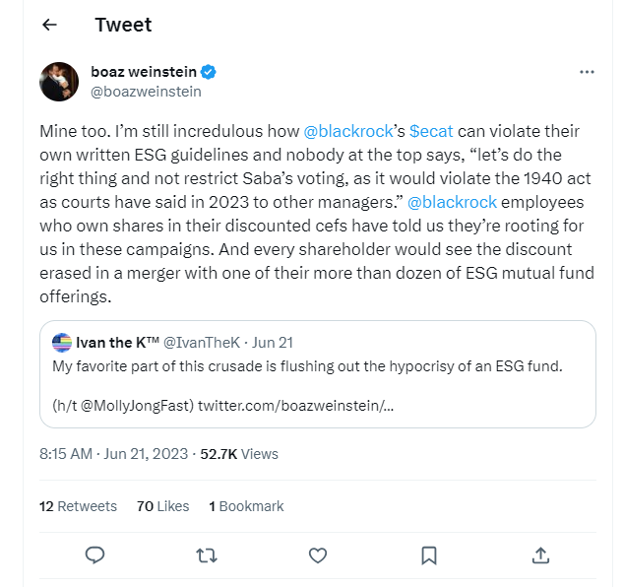
At a recent Bloomberg Investment Conference, Weinstein said:
I, in the past year, have been amazed at how the discounts for some of these funds have ballooned out to 20 cents, 20% discount. And in our flagship fund 46% invested in closed-end funds. And particularly with BlackRock because they are the world’s largest asset manager and are talking the talk on ESG; they’re saying this is how we want to be treated when we are shareholders in IBM or Disney or what have you; I believe they have to walk the walk. They cannot use entrenchment mechanisms to prevent us from putting people on the board. And I’ll just say that they’re a thought leader, but what they are doing to entrench with respect to stripping shareholder rights, banning shareholder proposals, which they’ve done, puts them on the G side of governance as the worst company in the S&P 500.
The discount has since closed to about 12.5%.
I do not see any choice for BlackRock except for merging the fund with an open-end fund, eliminating the discount, and putting this whole sordid affair behind them.
In the meantime, we own a portfolio of high-quality corporate bonds that will move higher as rates go down. The distribution yield is about 9.5%, and the cash is paid monthly.
Fixed income, cash flow-generating infrastructure assets, and a healthy slug of high-yielding cash are the perfect allocation for today’s confusing market.
That is exactly where the Underground Income strategy has us positioned as we enter the year’s second half.
June 28, 2023 - 9:26 am
We are a little bit late to this party, but I want you to buy shares of BlackRock ESG Capital Allocation Term (ECAT). Use a limit order near the current price but do not pay over $ 15.85
Saba Capital has been agitating for some time, and the discount has narrowed, but it increasingly looks like this is going to be a big win for Saba and other investors with the 12.5% discount will be narrowed even further.
I had held off jumping onto this one as Blackrock is the 800-pound gorilla of money management firms and has more than enough lawyers to give Saba a battle.
I underestimated Boaz Weinstein and his team’s ability to push the fight into the public eye.
Blackrock has made almost every possible mistake a firm trying to ward off activists can take. The idea of a fund whose specific purpose is to invest in companies with good corporate governance is laughable.
I suspect that after trying everything else and being openly mocked, Blackrock will merge this fund into an open-end fund to make its history disappear.
In the meantime, we will collect a yield of 9.6% from a portfolio of high-quality bonds.
This is a term trust that intends to liquidate in September of 2033. I doubt it exists that long.
Buy shares of BlackRock ESG Capital Allocation Term Trust near the current market price but do not pay over $ 15.85.
June 9, 2023 - 9:29 am
Never Bet Against the United States of America.
That has been Warren Buffett’s message for quite some time, and it is one of the great financial truths of the last 247 years.
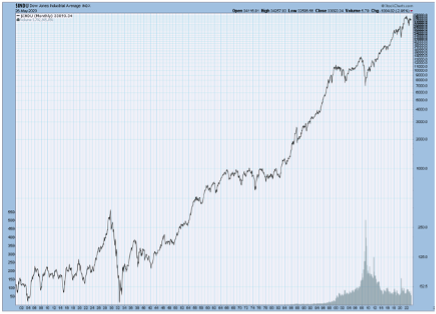
Stockcharts.com
Although historians may debate who invented what, the United States was one of the chief architects of the Industrial Revolution and has, ever since then, been a global leader in innovation.
The first city in the world with electric street lights was the booming metropolis of Wabash, Indiana, in 1886.
Nikolai Tesla threw the switch to make Buffalo, New York, the first fully electrified city in 1896.
While not discounting our allies’ role, without U.S. forces and the rapid innovation that came with a wartime economy, two World Wars would have been lost to Germany.
The polio vaccine was discovered by Jonas Salk while working at the University of Pittsburgh School of Medicine.
The United States was the first to put a man on the moon and is still the only nation to have accomplished that task.
The Department of Defense invented the network that became the World Wide Web in the 1970s. (Sorry, Al Gore!)
The first personal computer was invented by Xerox in 1973.
E-Commerce was born here during the madness of the internet bubble.
In spite of the government’s efforts to regulate or tax innovation out of existence, the United States is a leader in quantum computing, driverless cars, social media, renewable energy, smart homes, wireless technology, and any other hot tech trend you could think of Alphabet (GOOGL), Amazon (AMZN), Nvidia (NVDA), Microsoft (MSFT), and OpenAI are all United States-based companies that are leading the way in artificial intelligence.
Despite vigorous efforts to displace us, we are still the largest economy in the world, with a more than 30% advantage over our good friends in China. And, if that wasn’t enough: we still have the best equipped and trained military in the world.
Betting against the United States has been a sucker bet for the country’s entire existence.
There is a reason that short selling is the stock market equivalent of smoking two packs a day of unfiltered cigarettes: you are betting against a nation populated by dreamers and doers who want to build a better world for their kids and grandkids. You are betting against millions of people who still believe that free enterprise and the rule of law can build a better world.
You might as well bet against Secretariat or the 1927 Yankees. Theoretically, you might have a chance of winning…but in reality, you just helped a bookie buy a new Cadillac.
Betting on the U.S. economy has always been a winning proposition.
The thing about betting that most people need to remember, however, is that the key to winning big is not just picking the winner. The odds you get on your bet matter just as much, if not more, than the horse or market on which you decide to bet.
When everything is going well, the economy is thriving, and everyone is so happy to place bets that the U.S. will continue winning, the odds are horrible.
In the early 1970s, when the “Nifty Fifty” were all the rage and the last blush of postwar optimism was beginning to run into growing cynicism and doubt, investors were thrilled to bet on what everyone knew were the best companies in the world.
Their optimism was not rewarded.
The Nifty Fifty as a group collapsed by more than 50% over the next few years, as Watergate, the oil crisis, and a high inflation rate deflated the once buoyant markets.
In 1986 the market was once again riding high. Junk bonds, private equity, and corporate raiders (I miss that phrase—“corporate activist” just does not have the same ring to it) combined to remake corporate America. Companies like MCI, the newly formed “Baby Bells,” and some newfangled cables called fiber optics were transforming how we communicated.
It was clear that the West was winning the Cold War under Ronald Reagan and Margaret Thatcher.
As 1987 began, the S&P 500 was trading at the highest price-to-earnings (P/E) ratio since the market peaked in 1972. And then came the crash of October 1987, when the market lost 25% of its value in a single day.
We saw a similar development in 2006 and 2007, when the growing conviction that real estate could never go down and everyone deserved a home regardless of their ability to pay for it combined to unleash a wave of stupidity and recklessness across the banking industry that took us into what we now call the Great Financial Crisis. Once again, as 2008 began, valuations were well above the historical averages…until financial gravity asserted itself with painful consequences.
In every instance, the U.S. economy eventually asserts itself and once again unleashes a combination of innovation and productivity that continues to make us the envy of the world.
Those who made bets at bad odds and had the fortitude to hang on for decades eventually emerged with respectable-but-not-spectacular results. Most could not stand the pain and exited the bet. History tells us that the point of maximum pain for these bettors is pretty close to the market bottom.
In the stock market, valuations are the equivalent of odds.
In January 2020, very few people knew that the coronavirus pandemic would have the impact on the U.S. economy markets that it eventually did. However, if you paid attention to the odds, the S&P 500 traded at a P/E ratio of slightly over 24—about 40% above the historical median valuation.
Pandemic or not, it was not a great time to be buying the U.S. stock market. The odds were against you.
Today, the stock market is once again trading at 24 times earnings.
The interest rates being used to value commercial real estate and most real estate investment trusts are far too low. And as much as we may want to own closed-end funds investing in risk-based assets like stock and real estate, the odds are against us.
The valuations are too high, the discounts to NAV are too low, and the CEF activists could care less about these funds right now.
That will change. It always does.
Waiting for it to change can be maddening, but in financial markets, patience builds more fortunes than anything else that comes to mind.
What does it look like when the odds change?
Back in 1970, Fortune Magazine columnist Carol Loomis asked Warren Buffett how he felt about stock prices. He replied: “Like an oversexed guy in a harem. This is the time to start investing.” Inflation was in double digits, the Arabs were using oil to hold the world hostage, the President was talking about malaise, and the average person’s desire to buy stocks was about the same as the average person’s desire to have a case of shingles.
In 1976 the S&P 500 traded at about 8.5 times earnings, half the historical median.
The 1970s led to the 1980s and 1990s, decades when the stock market turned hundreds of thousands of individuals into millionaires. Investors who put money into the Fidelity Magellan Fund in 1977, when a sharp analyst by the name of Peter Lynch took over, saw every ,000 invested turn into more than 2,000. Investors who bought into Berkshire Hathaway after Warren Buffett’s disastrous 1974 loss of 48% turned every ,000 into more than 5,000 in 10 years.
And over 20 years, every ,000 invested became .87 million.
The markets were depressed in 1975, and valuations were low. No one wanted anything to do with the stock market.
The odds were right.
In March 2009, it felt like the world was going to end: banks were failing. Homes were being foreclosed on all over the country. Miami had block after block of empty condo towers. Unemployment was at 9%. The S&P 500 was down over 50% from the peak.
It was so bad that one of the favorite jokes of the time was about stockbrokers:
Q. What do you call a stockbroker today?
A. Hey-Waiter!
Not even the miracle on the Hudson could cheer us up for very long.
Warren Buffett’s October OpEd about buying America fell on deaf ears. The Cboe Volatility Index (VIX) was at 45, down from a high of 90.
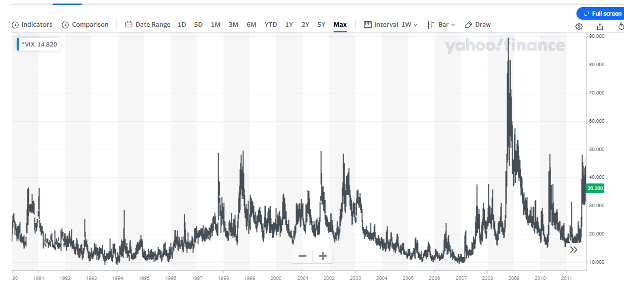
Yahoo Finance
High Yield Credit Spreads were at their highest level since the Fed started keeping track.
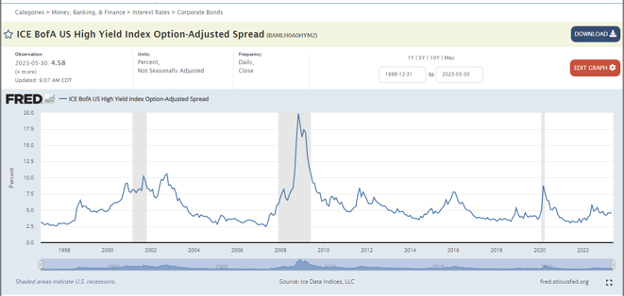
But Buffett was buying. Legendary value investor Seth Klarman was an aggressive buyer. So were Stanley Druckenmiller and David Tepper, two of the most successful investors of the last fifty years. Closed-end fund specialists and activists were loading up on heavily discounted closed-end funds.
As the market bottomed in early March, I was visiting one of the great risk arb traders of all time in Midtown Manhattan, and we were buying up all the discounted convertible funds we could find.
The odds were right.
Our time to be aggressive in risk-based assets will come.
When it does, we will load up on closed-end funds that own small-cap value stocks, real estate investment trusts, International stocks, more high-yield bonds, convertible bonds, and other bargain-priced assets.
These funds will be heavily discounted, pay large distributions, and have activist shareholders. The odds will be in our favor.
Until that happens, our three selection criteria—an asset class ripe for mean reversion, heavy discounts to net asset value (NAV), and an activist presence—have steered us into the perfect asset allocation for 2023.
We are long on fixed-income, cash-producing energy infrastructure, and cash. We are at about 50% of the level I consider fully invested. But I promised you on day one that I would never add funds just for the sake of activity, and I have never even thought about doing so.
We are going to have a recession later this year or next year.
The data says it is almost inevitable. Inflation is not going away as quickly or easily as many so-called experts had hoped. And we are already seeing some dings of an economic slowdown—while employment has been resilient, it is cracking ever so slowly.
Dealing with a recession and uncertain markets is never fun, but we are well positioned for one in the Underground Income portfolio.
The other side of the inflation fight and economic slowdown is very bright.
Artificial intelligence will be a gamechanger in many industries and make it possible to do more, do it better, and do it cheaper.
The building boom to keep up with pent-up demand for homes will be fantastic for builders and building supply companies. It will also create tens of thousands of high-paying jobs, and that’s good news for consumer-oriented companies.
While renewable energy will not replace fossil fuels for decades, it will be the fastest-growing energy source and create even more good jobs. The rehoming of the semiconductor industry will also be a huge tailwind for the U.S. economy. And if Washington gains a smidgen of intelligence, the pharmaceutical industry will be close behind. As the song goes, the future is “so bright [we] gotta wear shades.”
Professor Andrew Lo of MIT once opined that the secret of making big money as a long-term investor is to survive long enough ot be a long-term investor. The Underground Income portfolio is putting us in a position to survive and thrive until it is time to commit to equities and real estate.
June 5, 2023 - 9:16 am
I want you to buy shares of The Nuveen California Quality Muni Income Fund (NAC) using a limit order around the current market price. Do not pay over $ 11 a share for your position.
Tax-free bonds now have a taxable equivalent yield well above the long-term yield of Federal Government Bonds. While municipal bonds are not immune to fluctuations due to economic gyrations, they tend to be more muted.
Market conditions this summer are likely to be influenced by a very light new issue calendar.
We are closer to the end of the rate hike cycle than the beginning. Holding Munis through the impending recession should be a very profitable endeavor in terms of both cash flows and potential gains.
A significant portion of the bonds held by the fund were issued when rates were lower and have declined in price. Add in the 15.67% discount on the net asset value at which the fund shares are trading, and we have our own version of a discount double play.
The current yield is 4.08%, giving us a taxable equivalent yield of 7.4% for middle-bracket California buyers. A top-bracket buyer is closer to almost 8%.
An out-of-state buyer is still getting almost 6.8% TEY from state and local government bonds.
The portfolio is focused on high-quality bonds with little chance of default. The safety of municipal bonds is second only to US Treasuries.
You can buy shares of The Nuveen California Quality Muni Income Fund using a limit order around the current market price. Do not pay over $ 11 a share for your position.
June 2, 2023 - 9:47 am
I want you to buy shares of Blackstone Strategic Credit 2027 Term Fund (BGB) using a limit order near the current price. Do not pay over $ 11.
May 3, 2023 - 9:47 am
The outlook remains pretty much unchanged from last month’s issue and subsequent calls. Although we missed the April members’ meeting because of an unfortunate bout with the flu, the slide deck would not have looked much different from prior months.
As economic, market-related, and geopolitical data become available, my conviction about the allocation we have developed in Underground Income becomes even stronger. The exciting part of this is that the allocation decision has been made by tracking the buying activity of the leading closed-end fund activists. For the most part, the big investors in closed-end funds have been focusing on fixed-income and energy-related funds because of growing discounts to NAV.
It just so happens that following the activists and focusing on discounts is helping shape the portfolio in a way that is entirely in line with the current macroeconomic and political backdrop.
Discounts in equity funds and funds investing in real estate-related securities have yet to reach the level where the activists have begun to get interested in a meaningful fashion. When they do, we will be ready to act…but, for now, the strategy continues to invest in fixed-income and energy assets for the most part.
Given the current economic outlook, overloading in fixed income is the right move at this moment in time.
In the last set of Federal Reserve minutes, it was clear that even the staff that put together the briefing for Fed meetings felt that a recession was inevitable later this year or early in 2024.
The still-healthy jobs market and consumer spending patterns can carry us for a few more months, but there is every indication that these two factors are starting to slow.
While the absolute number of jobless claims is still in line with a decent economy, the trend is decidedly higher, as we have seen more claims for several weeks in a row.
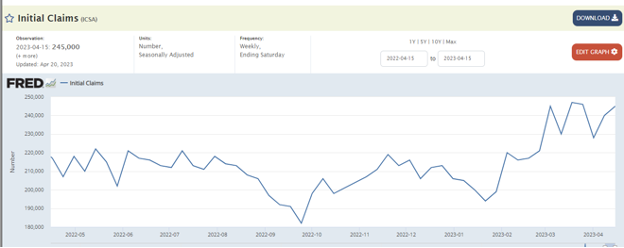
At the same time, the Index of Leading Economic Indicators continues to come in lower month in and month out. Historically, a continuous decline in the LEI has been followed by a recession.
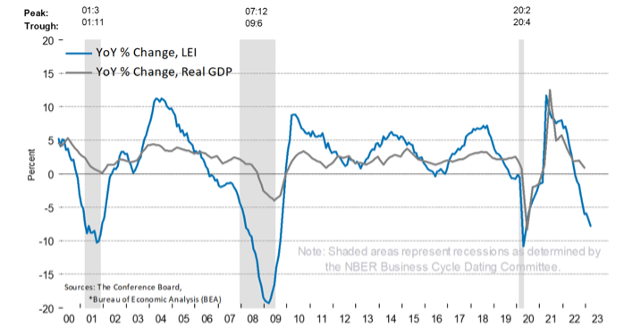
When you dig into the recent reports from the Federal Reserve banks in Dallas, New York, Philadelphia, and Richmond, they all report lower forecasts for business spending on capital expenditures.
I have said for more than a year now that it is highly unlikely that the Fed will be able to engineer a soft landing, and a recession is inevitable.
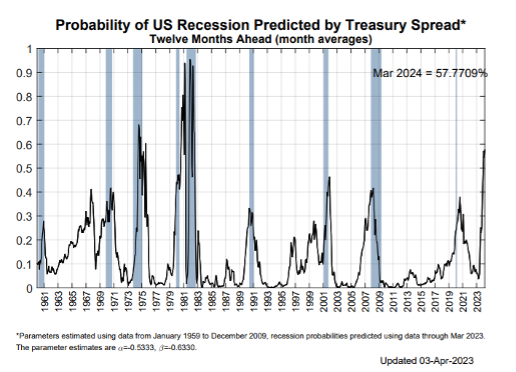
To make matters more difficult for Fed chair Jerome Powell and his merry band, the inflation numbers are not falling closer to the levels that would make them comfortable lowering rates.
Most of the recent weaknesses in inflation numbers we have seen result from lower energy prices. I have previously discussed the looming supply and demand imbalance that will develop in crude oil later this year.
Although natural gas has been weak this year, the demand will increase, and the hoped-for production increase is unlikely. There is no economic incentive for producers to increase output and depress prices. In fact, if we do not see production cutbacks that lift natural gas prices, you will start seeing marginal producers take their operations offline, further reducing available supplies in North America.
We will see increased demand for natural gas from the complete reopening of the Freeport LNG facility, as well as Europe’s need to replace the stockpiles and begin to consider its energy needs for next winter. The Old World cannot count on another mild winter to keep natural gas demand low.
Led by Germany, Europe continues to make epically bad decisions on meeting its energy needs, ultimately creating demand for U.S. natural gas imports. LNG exports will continue to grow, and I expect the United States to be the leading exporter of LNG to Europe and those Asian nations with which we have cordial relations.
And, after a brief demand spike thanks to stupid policies, coal demand should begin to fall once again and be replaced by natural gas for generating electricity and powering the industry in the United States.
All of this creates a very bullish backdrop for oil and gas infrastructure here in the United States. We will continue to use oil and gas no matter how much the green energy activists and politicians tell you differently.
We own a lot of oil and gas pipelines, gathering systems, processing centers, terminals, trucks, and storage facilities. And, as we will discuss momentarily, we added more last week. If activist investors keep buying these closed-end funds, we will keep increasing our allocation.
I want to be bullish on equities, but with the market trading at more than 23 times earnings and the VIX trading at low levels, it is hard to get excited about buying into equity funds. Moreover, we have not seen any aggressive moves into equity funds by closed-end fund activists to make me inclined to question my thoughts on equity exposure.
I am seeing some movement in real estate-related funds that is getting interesting, however. After talking with real estate experts and investors at leading real estate research and private equity firms, I am developing a contrarian view of commercial real estate that is increasingly bullish.
All the headlines talk about developing problems in commercial real estate and the following articles discuss at length the difficulties in the office market. But outside of office real estate, I am seeing pricing dislocations in multifamily, data centers, medical offices, sunbelt high-end retail centers, and other segments of the REIT market.
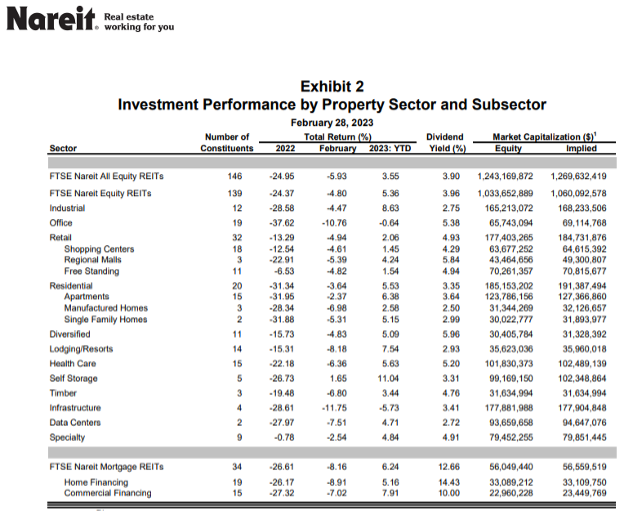
When the pricing is right, and I see some activist movement, I intend to move aggressively into these closed-end funds as the upside from these levels is enormous.
While I would like to become fully invested as quickly as possible, I am not going to sacrifice the commitment to the rules that make the Underground Income closed-end fund arbitrage strategy work so well:
- The fund must be invested in an asset class or strategy that is about to turn the corner and move higher.
- There must be a high level of NAV discount and activist shareholders who might push to narrow that discount at some point.
- There needs to be a high level of regular income payments from the fund.
All these conditions must be met before I consider adding the fund to our portfolio.
That said, we did add several funds to the portfolio this month.
The first edition was the Nuveen Core Plus Impact Fund (NPCT). This fund was introduced with a great deal of promotion around the idea that the fund would invest in the debt of companies with strong environmental, social, and governance (ESG) criteria.
According to the fund’s website, the Nuveen Core Plus Impact Fund would make “strategic allocations to bonds with direct and measurable impact within affordable housing, community or economic development, and renewable energy and natural resources.”
Sounds noble, doesn’t it?
The only problem is that when it came time to market the fund, no one really cared.
Closed-end funds are primarily marketed to individual investors through brokers. While ESG investing is a lot of fun for pension consultants and members of Congress to discuss as the Holy Grail of do-good investing, very few investors care, in my experience.
The fund only attracted about $ 350 million in assets.
For a company the size of Nuveen, with more than $ 1 trillion in assets under management, the fund’s asset size is not even large enough to be a rounding error.
The fund managers have adopted a contrarian approach to investing in bonds, and I like the portfolio. 80% of the bonds are BB or better, and the range of maturities is diversified. The fund currently trades at a discount to net asset value of about 15.7% and has a yield of 9.71%. Dividends are paid monthly.
The fund is so small that it would make sense for Nuveen just to merge it into a larger fixed-income fund. And in fact, one large activist investor is already pushing management to take steps to eliminate the discount. The easiest way to achieve that would be to merge the fund into one of Nuveen’s larger open-end funds, thereby eliminating the discount entirely.
We also added another energy infrastructure fund to the portfolio. Two of the MLP funds in the portfolio are above the buy price because of activist activities, so when I saw that Saba Capital had purchased 8.5% of Tortoise Pipeline Partners, I was happy to add the fund to our portfolio. Saba has taken an activist position and is already taking steps that could lead to a proxy fight to gain board seats.
This fund trades at a discount to net asset value of over 18% and yields over 9%. I am excited to add it to the mix, as more than 60% of the fund is natural gas infrastructure and natural gas demand will skyrocket over the next few years. The export market for LNG will be massive, and we will participate in that explosion as owners of this fund.
Finally, we added Federated Premier Municipal Income (FMN) shares to the tax-free Underground Income portfolio. We finally had an activist filing on a fund with a combination of discount and yield high enough to qualify for the portfolio.
I have been strict about which funds I want to add, and this fund qualifies on several counts. Federated Premier has a very high-quality portfolio, with about 85% of the portfolio carrying an investment grade rating. The binds in the fund are mostly longer maturities that will benefit from any pause in Fed interest rate hikes and could deliver explosive gains if a recession causes the Fed to lower rates early next year.
The discount is currently 15%, so there is ample opportunity for gains due to a narrowing of the discount. And finally, its federal tax-free yield is 4.2%—the equivalent of a 7.07% taxable yield from a very high-quality investment.
Following the activists and closed-end fund specialists has helped us put together a portfolio that is poised to benefit from the biggest macroeconomic and geopolitical trends in the world today. We have sidestepped the risks of the equity market almost entirely and are collecting a very high-income stream in both the regular and tax-free portfolios.
Underground Income continues to be one of the best strategies for investors interested in both high incomes and solid long-term total returns.
April 26, 2023 - 9:49 am
April 26, 2023 - 9:38 am
April 17, 2023 - 9:27 am
I want you to buy shares of Nuveen Core Plus Impact Fund (NPCT). Use a limit order near the current price but do not pay above $ 11.10 for shares.
This fund was sold as an ESG (Environmental, Social, and Governance) when all of Wall Street thought the idea of doing well by doing good would appeal to investors. The concept of investing in companies that meet some arbitrary social guidelines and have the appearance of being nice sounded great but never really caught on with most individual investors.
It certainly did not with this fund, as the market cap is only $ 300 million.
What investors overlook is that this fund is focused on strong credit, with over 80% of the fund’s holdings rated BB or better.
The shares are trading at a 14% discount to net asset value and yield 9.6% at the current price. Dividends are paid monthly.
The fund’s shareholder list contains some of the biggest activists and closed-end fund specialists.
Given the size of the fund relative to other Nuveen offerings, a merger makes an enormous amount of sense for this fund. Do not be surprised if we see a passive-holder turn activist and suggest exactly that before too long.
Use a limit order to buy shares of Nuveen Core Plus Impact Fund (NPCT) near the current price.
Do not pay over $ 11.10.
April 5, 2023 - 12:51 pm
The market was too calm in the year’s first two months, so we invented a banking crisis.
Make no mistake about it: the crisis was not necessary. The issues affecting Silvergate (SI), Silicon Valley Bank (SIVB), and even Signature (SBNY) were unrelated to anything else happening in the banking system.
It is true that many banks had securities-related losses thanks to rising interest rates. It is true that many people were looking at money market funds and treasuries as an alternative to bank deposits and moving their money out of banks. And it is also true that many banks have uninsured deposits. In fact, about half of the deposits in the average bank in the United States are uninsured. And the bigger the bank, the more uninsured deposits it has.
All of this was as true a month ago as it is today, and it will all be true a few months from now, too.
Similar circumstances have existed in the past. They will happen again in the future.
The deposit bleed was never going to be enough to cause banks to sell a significant portion of their securities. Eventually, the securities would have matured, eliminating the paper loss.
Sure, banks would have had to start paying higher rates on saving accounts and certificates of deposit to stop the bleeding. But the bankers would have grumbled and then done what was needed to keep depositors happy.
This cycle has existed since ancient Athens’s temple lenders invented banking in 2000 BC. It will be with us when our great-great-great grandchildren are banking at the Second Consolidated Klingon-Romulan Intergalactic Bank of Stevensville in the distant future.
The Silicon Valley closure should have been a one-off event with few to no consequences for anyone outside the venture capital world. Instead, with an able-bodied assist from headline writers and the click-seeking media, instant experts, and stunningly dimwitted elected and appointed government officials, we turned it into a crisis.
The Fed and the Banks
The Federal Reserve had to use moderate language in its most recent interest rate announcement to avoid further spooking the markets. While the pundits think the Fed has decided to slow the pace of rate hikes, what the Fed actually did with a 25-basis point hike was please everyone it could and buy six more weeks to examine the data.
Fed Chair Jerome Powell did say that the tightening bank credit could do some of the heavy lifting when it comes to slowing inflation. And banks are going to tighten credit in the aftermath of the recent debacle. No one wants credit problems on top of higher deposit pricing.
If you need a loan, you probably will not be able to get one. This will slow the economy and likely cause a rise in unemployment.
Commercial Real Estate Investment Trusts
Of course, once it became apparent that the deposit run had been stopped in its tracks by the Fed, the FDIC, and the banking industry, the newly minted experts decided that it would be commercial real estate that collapsed the banking industry and pushed us closer to the end of the world.
If you are just now noticing that commercial real estate prices are inflated in some sectors and that central business office districts in gateway cities have a huge potential problem, you truly are a newly minted banking and real estate expert.
This problem has been brewing for some time. Ongoing work from home has dropped actual office occupancy below 50% in cities like New York, San Francisco, and Washington, D.C. Many businesses are going to need less office space, and that is going to be a problem in some areas.
One important consideration here is that most commercial real estate bank debt is held on the books of larger banks.
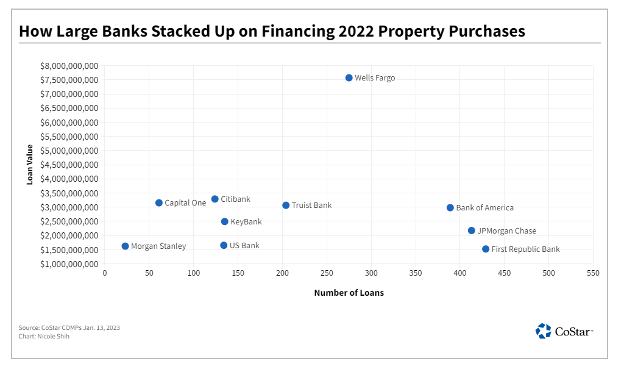
The headlines here could get interesting, and some banks may have CRE-related issues; however, if you look at the CRE lending guidelines issued by the regulators, you realize that while the headlines could be ugly, the reality is survivable even if the banks have to foreclose and market the property for sale.
I think that some REITs financing debt at much higher interest rates will have a bigger problem than most banks. Even then, REITS with office buildings outside the major cities or in segments like life sciences will still see high occupancy rates and have little difficulty paying their debts.
There will be a lot of headline risk, and some banks will have bad quarters because of it, but not enough to cause a 2008-style crisis.
Hopefully, what will happen is that REIT closed-end fund owners will dump their shares and push the discount rate to higher levels. Tempting as it has been over the past few weeks to go ahead and buy the REIT closed-end funds, the discounts are not yet at the level that signals what I consider a slam-dunk profit opportunity.
Still, some of them are creeping closer, so do not be surprised if we buy one or more REIT-focused funds soon.
On Inflation and Interest Rates…
If we step back to the big picture, the Fed is not finished fighting inflation unless we see a near-miraculous reversal in prices. If that has happened, someone forgot to tell the folks at Publix, CVS, and every restaurant in SW Florida.
Another rate hike from the Fed seems likely to me. The markets, however, seem to be betting we get no change and maybe even a rate cut—despite Fed officials’ insistence that a cut is unlikely. But, it is a possibility if bank tightening of lending standards puts a break on the economy.
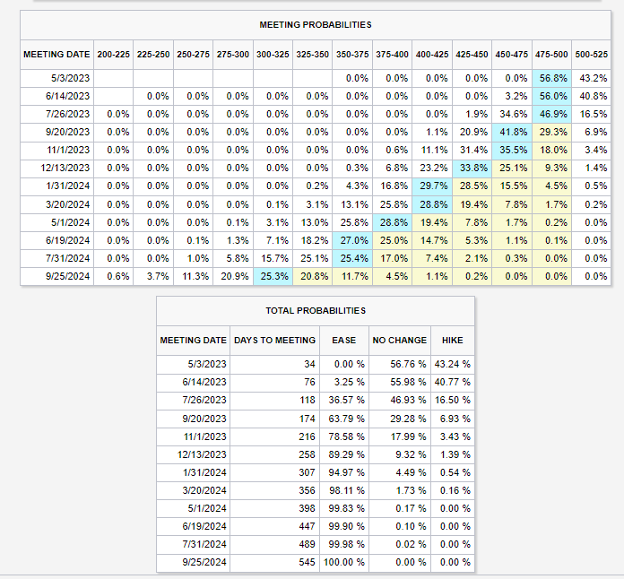
CME Fed Watch
If rates plateau or the Fed does begin to cut rates later this year, that is a highly bullish scenario for fixed income.
It is not so bullish for equities. The only reason the Fed would stop hiking rates, let alone begin to cut them, would be if the economy slows down enough to bring inflation down rapidly towards the 2% threshold.
In theory, that can happen without causing a recession, but there is a better chance of the 2023 World Series featuring the Kansas City Royals battling the Washington Nationals—it could happen, but you sure would not want to bet it that way.
The three-month-10-year yield spread continues to indicate a recession sometime in the next several months.
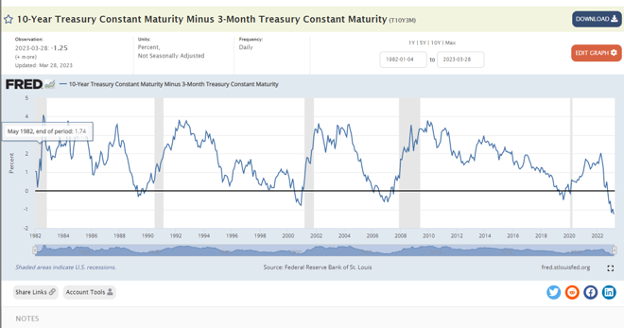
Given its track record, you definitely want to bet that it will be correct again.
We also have not seen anywhere near the levels of fear that would indicate a market bottom.
High-yield credit spreads widened in March, but not enough to signal a buying opportunity.
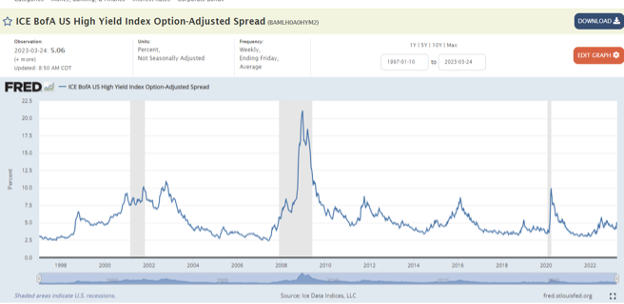
The CBOE Volatility Index made a brief run before falling back asleep.
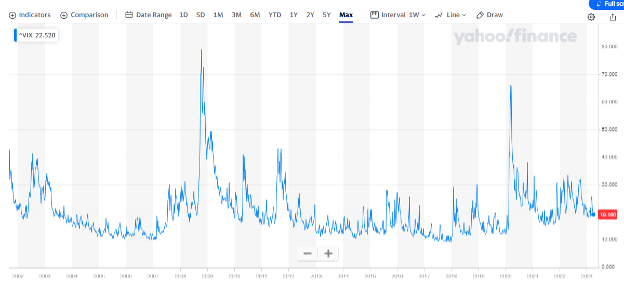
Yahoo Finance
Given all the things that could go wrong for equities in the economy and around the world, I continue to expect that at some point, we will see fear spike and a widening of equity and REIT fund discounts to NAV that allow us an attractive entry point.
Will the recession affect energy?
You would think that a likely recession would mean lower oil and gas prices. Thanks to moronic energy policies by much of the Western world and an insistence on allowing politics to take precedence over reality, that is not the case.
The Energy Information Agency is projecting that shale oil production here in the United States is going to increase by almost 600,000 barrel equivalents a day.
That is not very likely.
There is no economic incentive for producers to ramp up production to those levels, which would depress gas prices further and pressure profits.
The current prices are already pressuring marginal, smaller producers. If we do not see marked price improvement soon, the actual output could decline by 20%, according to Quantum Energy, a private equity firm that invests in oil and gas companies.
The bigger shale producers will keep drilling flat and return cash flows to investors through dividends and buybacks instead of investing in new production.
This paints a bullish picture for the energy and energy infrastructure funds we own in Underground Income—as does the International Energy Agency’s prediction that demand will outpace supply in the year’s second half.
The combination of the big picture and current conditions favors overweighting income-producing energy assets and fixed income and remaining patient when adding risk assets, including stock and real estate.
New portfolio additions
This month we took a big step toward our fixed-income goals, adding three heavily discounted funds to the portfolio.

Finviz.com
The Principal Real Estate Income Fund (PGZ) invests in commercial real estate securities. Most of its investments are in commercial real estate and commercial mortgage securities. The fund also invests in REIT and debt securities issued by real estate companies.
Right now, the price of the securities in the portfolio is below face value according to the most recent fact sheet. On top of that, the fund shares are trading at a 16 discount to the net asset value.
The yield is over 13%, and dividends are paid monthly.

Finviz.com
The New America High-Income Fund (HYB) is the first pure-play high-yield fund added to our portfolio. I have been very patient about waiting for discounts to reach attractive levels, and this is the first fund to reward that patience.
This fund invests in higher quality high-yield bonds, and about 43% of the bonds it owns are rated BB or better. As I mentioned in the buy alert, some of the larger holdings in the fund include bonds issued by:
- Ford Motor (F)
- American Airlines (AAL)
- Caesars Entertainment (CZR)
- PetSmart (PETM)
- Sirius XM (SIRI)
- Freeport-McMoRan (FCX)
- Occidental Petroleum (OXY)
- Goodyear (GT)
- Staples (SPLS)
None of these are likely to have difficulties paying the interest or repaying the debt at maturity.
The fund shares trade at a discount of 15% and currently yield 7.4%

Finviz.com
FS Credit Opportunities Corp. (FSCO) was a non-listed private credit fund offered by alternative investing leader FS Investment. The firm decided to list its shares on the NYSE via a staggered direct listing process. The first third of the shares were listed last year, the second third this past February, and the final third will be listed in May.
The owners of the private credit fund wanted no part of a fund marked not just to market but market sentiment every day. As a result, the previous owners have been aggressive sellers since day one, creating a unique opportunity for us.
Institutional investors who did not want publicly listed shares have sold enough to push the funds shares out to a massive discount to net asset value. But as selling pressure begins to fade, the discount should begin to narrow. Eventually, I expect to see activists take an aggressive approach to this fund’s significant discount.
FSCO has outperformed the relevant indexes since a new manager, Andrew Beckman, took over in 2018. Beckman also heads up the Liquid Credit and Special Situations investment team for FS Investments. He has been active in high yield and special situation investing since the late 1990s, so he has seen several risks on/risk off scenarios unfold and invested successfully through turbulent periods in the markets. Before joining FS Investments, Mr. Beckman worked at leading Wall Street firms, including Goldman Sachs (GS) and Salomon Smith Barney, as well as several hedge funds.
The fund’s co-manager and director of research, Nick Heilbut, also has a long track record of successful high-yield investing stretching back to the 1990s.
They two have excelled in earlier credit and market cycles and have seen plenty of up-and-downs with prices and volatility, so I have little doubt they will this time as well.
FSCO is 82% invested in senior debt, and 63% of the investments are floating rates, so any future rate hikes from the Fed will benefit those loans’ yield and pricing. The fund’s shares currently trade at a discount to the net asset value of over 30%.
Portfolio overview
Right now, our portfolio has an average yield of more than 10% and a discount to net asset value of more than 17%. The little bit of direct non-energy equity exposure we have is limited to blue chip stocks, and most of that is invested in shares of Berkshire Hathaway. The rest is balanced between fixed-income and income-producing equity assets and corporations.
All of our funds have activist and specialist shareholders except FS Credit Opportunities, which has not been listed long enough to attract attention.
I think we will see that change when the new 13F filings begin to trickle in at the SEC next week.
With a target portfolio size of 25-30 funds, we are just about 50% invested, and you should still have cash on the sidelines to take advantage of future opportunities.
It is the perfect asset mix for the current market and economic conditions.
March 27, 2023 - 9:24 am
I want you to buy FSZ Credit Opportunities (FSCO) shares using a limit order near the current price. Do not pay over for your shares in this fund.
FS Credit Opportunities was a non-listed private credit fund offered by alternative investing leader FS Investment. The firm decided to list the shares on the NYSE via a staggered listing process. The first third of the shares were listed last year, the second third in February, and the final third will be listed in May.
The owners of the private credit fund wanted no part of a fund that is marked not just to market but market sentiment each and every day. As a result, the previous owners have been aggressive sellers since day one, creating a unique opportunity for us.
This fund has outperformed the relevant indexes since the new manager took over in 2018. The new team has been active in the high-yield credit markets since 1998-99, so they have seen up-and-down price and volatility cycles.
They excelled in early cycles, and I have little doubt they will this time as well.
The fund is 82% invested in senior debt, and 63% of the investments are floating rate, so any future rate hikes from the Fed will benefit those loans yield and pricing.
When the listing process is complete, I expect activists to begin taking stakes in this fund.
Until market forces and activist activity combine to narrow the discount, we will collect a dividend yield of about 14% with monthly payments.
The payout is comfortably covered by investment income.
Use a limit order near the current price, and do not pay over for your FC Credit Opportunities Fund shares.
March 20, 2023 - 9:19 am
I want you to buy shares of the New America High Yield Fund (HYB). Use a limit order to buy your shares but do not pay above $ 6.85 for your shares.
This is our first foray into pure-play US high yield, but I doubt it will be our last.
The fund focuses on the high end of the high-yield market, and 83% of the portfolio is B rate or higher. 42% of the fund is invested in BB rate binds, the rating that I consider to be the sweet spot of the high-yield market.
The fund owns bonds in companies that you know well and are unlikely to struggle to pay their bond interest These include:
Ford Motor (F)
American Airlines (AAL)
Caesars Entertainment (CZR)
PetSmart
Sirius XM (SIRI)
Freeport-McMoRan (FCX)
Occidental Petroleum (OXY)
Goodyear (GT)
Staples (SPLS)
I could go on, but I think you get the idea. These companies can pay their bills, and our bonds should be paid as agreed.
Closed-end fund activists and successful closed-end fund specialist investors have been buying the shares recently.
The fund currently trades at a discount to the net asset value of over 15% and yields about 7.50%.
Use a limit order near the current price to buy shares of the New America High Yield Fund but do not pay over $ 6.85.
March 15, 2023 - 10:11 am
I want you to buy shares of the Principal Real Estate Income Fund (PGZ) near the current price. Use a limit order to enter your positions, and do not pay over $ 10.50 for your shares.
This fund invests in real estate securities, primarily commercial real estate mortgage-backed securities and other real estate-related securities.
About 75 of the securities are rated BB or better, so credit risk is not a problem for this fund.
Commercial real estate may have a tough year again in 2023, but we are not buying properties. We will be investing in debt, and it will take a collapse of epic proportions to cause widespread defaults in the commercial mortgage-backed securities market.
I do not see that happening, as there is not enough leverage or general stupidity present in the financial system.
We have been trying to tilt even more towards fixed income as I believe we are close to the end of the hiking cycle than the beginning. I will not rule out fixed-income closed-end funds going down before they go up, but when the Fed cycle does end, our fixed-income investments will go up a lot.
In the meantime, we will collect very high cash dividends.
The big activists are large shareholders and have been buying more shares recently.
Use a limit order near the current price to buy shares of the Principal Real Estate Income Fund (PGZ).
Again, do not pay over $ 10.50 for shares.
At the current price, the discount of this fund is over 15%, and the current distribution yield is 12.8%.
Dividends are paid monthly.
March 1, 2023 - 8:55 am
March 2023 Vol. 1 Issue 10
While there will likely be some bounces and false starts along the way, the Federal Reserve is finally winning the battle of expectations. Recent inflation data clearly indicates that it will not simply fade away. If 450 basis points of interest rate hikes have yet to get the job done, more will probably be necessary.
Once we finally reach a terminal rate, rates will probably stay at these high levels for an extended period.
During last month’s member meeting, I used the Battle of the Five Armies from The Hobbit to portray the battle between the Fed and the buy-the-dip traders. Later, I said should have used the Clone Wars from Star Wars: Episode II, as we have seen a matchup between Jerome Powell and his council of economic Jedis, versus the machines that make up most of the daily trading volumes.
Although the battle must be close to keep viewers entertained, the Jedis always end up victorious.
Jerome Powell has been saying from day one that he is committed to controlling inflation and will do whatever is necessary to bring inflation back to the 2% target rate. And I have been telling you from day one that he would not blink, and that the eventual outcome would not be pleasant for stocks.
Last week’s news week regarding inflation and the increasing likelihood of a higher terminal rate is finally starting to weigh on the outlook of short-term traders and black box algorithms alike. The news is not great for the broader market, especially the high price-to-sales, no profit, all-story tech stocks.
For the day traders, both machine-driven and the ever-hopeful-but-doomed retail crowd, higher rates for longer terms turns them into the financial equivalent of the French Army at Agincourt, who lost what they thought would be an easy victory to a much smaller English force and its longbows.

Cathie Woods and her ARK funds staged a comeback in the early days of 2023, but given the prospect of higher rates ahead, they are going to join the 1981 Cincinnati Bengals in the land of failed comebacks, as the market turns against hope and dream investing once again.

The blue-chip stocks in our one nonenergy-specific stock fund will feel some selling pressure, but they’re all high-quality blue chips; if the fund falls far enough and the discount widens, we will in fact buy more of the SRH Total Return Fund (STEW). Its largest positions are basically Warren Buffett and Jamie Dimon, and I am okay hanging out with those two during a market decline.
We retain overweight energy infrastructure in the rest of the portfolio and tilt towards fixed income.
That fixed income tilt will increase in the weeks and months ahead, as rates continue to creep higher. If the world grants my wishes, we will finally see cracks in the high-yield market that will cause discounts in high-yield closed-end funds to widen to attractive levels.
The returns from discounted high-yield funds in the aftermath of a junk bond collapse have historically been awe-inspiring. The discounts to net asset value usually shift to much higher levels, and the cash yields can reach the mid-teens or higher.
I am seeing some positive developments in the high-yield CEF universe. As a result, I will be monitoring closely for an opportunity to get more money to work in this high-return sector of the fixed-income markets.
Our overweight energy position remains intact.
Morgan Stanley (MS) shares my bullish view of oil and gas. The firm raised its oil and gas demand estimate by 36% last week, thanks in large part to returning demand from China and increased demand from the aviation industry expected over the rest of the year.
We do not need oil and gas prices to skyrocket for our existing energy positions to perform well. I think prices remain flat for a few months and then head higher as the year progresses, barring any geopolitical shocks, which could escalate the pace of the price increases.
We added to the overall energy infrastructure allocation in Underground Income in February with a bit of a twist.
The MainStay CBRE Global Infrastructure Megatrends Fund (MEGI) does own some traditional energy infrastructure, but it is projects and assets that are in the process of being updated to accommodate the renewable future.

The fund also owns renewable assets, including solar and wind projects worldwide.
My favorite asset in the fund has almost nothing to do with energy, but it is a chance for me and millions of others who have ever lived in the Washington DC area to get back some of the cash we have given this asset.
The Mainstay CBRE Global Infrastructure Fund has a little over 5% of its asset invested in Atlas Arteria Limited (MAQAF), an owner of toll roads.
Three of the roads, in Western Europe, are essential passages in France, Germany, and Switzerland. Two others are in the United States: the Chicago Skyway, which connects Chicago and Northwest Indiana, and also a significant part of the Dulles Toll Road. (The fund has loans secured to buy the portion it does not own.) While I can only recall driving the Skyway once, I have driven the Dulles Toll Road road hundreds, if not thousands of times, to and from both the Dulles airport and other destinations in Loudon County and beyond.
A team from CBRE Investment Management, the global real estate and tangible assets investment firm, manages the fund. The firm’s official founding was in 1972 as a stand-alone entity, but it can tie its roots back to William Ellis, a London real estate appraiser in the late 1700s. Today, CBRE Investment Management is active in 30 countries with over 1000 employees and almost $ 150 billion in assets under management,
Jeremy Anagnos, the Chief Investment Officer of infrastructure investments for CBRE Investment Management, is the fund’s lead manager. He has been with CBRE since 2004 and has seen several economic and investment scenarios play out in the global economy since then. Before joining CBRE, he was in similar positions with Lasalle (JLL)and Deutsche Bank (DB). In all, Mr. Anagnos has been investing in real estate and infrastructure since 1995.
Joseph Smith, the fund’s co-Manager, oversees listed real assets investing for CBRE. He has been with the firm and its predecessors since 1997. Before that, he was with Alex Brown & Sons, PaineWebber, and Radnor Advisors. He has been involved in real estate-related investment management since 1991.
The Mainstay CBRE Global Infrastructure Fund is trading at a discount to the net asset value of over 15% and yields almost 9% right now. The dividends are paid monthly.
Closed-end fund specialists, including Karpus, RiverNorth, and Saba, were all buyers of the fund in the fourth quarter of the year, and are all large shareholders. While none have yet filed their Schedule 13Ds, if the discount continues to widen, I expect one or more of them to take a more active stance toward the fund’s board.
This month I am introducing another feature to Underground Income. As rates have continued to creep higher, the discounts to net asset value for tax-free CEFs are creeping higher as well. Saba and Bulldog Investors were also nibbling at tax-free closed-end funds in the fourth quarter.
The question was not whether we should be buying tax-free closed-end funds. The clear answer to that question is yes. The question was, how do we handle them for portfolio purposes?
A significant percentage of Underground Income readers invest in tax-advantaged plans like IRA and 401K accounts. Therefore, it would make no sense for them to own tax-free funds inside those already tax-advantaged plans. They would lose the advantages of income free from federal—and in some cases state and local—taxes.
In some cases, existing Underground Income Investors’ investment objectives could differ from investors looking for tax-free income and modest capital appreciation.
The more time I spent thinking about his issue, the more apparent it became that the obvious solution was to create a new tax-free portfolio inside Underground Income.
That is precisely what we have done.
Now is a perfect time to begin building a municipal bond closed-end fund (CEF) position. While I expect to see more rate hikes by the Fed, we are closer to the end of this phase of the interest rate cycle than the beginning.
A market in which rates stay elevated for an extended time will allow municipal fund managers to position for maximum income for investors. The credit quality in the municipal market remains very high despite some of the end-of-the-world predictions we hear in the media: California is not going to collapse into the ocean. For all its problems, Illinois is unlikely to default on its bonds. New York is not going to fail as it did in the 1970s.
The truth is that 49 of 50 states had a budget surplus last year.
I would not want to live in California, Illinois, or New York as the taxes they collect to pay their bond interest and principal will sting. (Illinois and New York were out of the question as potential residences anyway because of the whole snow thing.) However, millions of residents of these states like where they live and are willing to pay to stay there. The taxes will get collected, and bondholders will get paid.
As a refresher, here are the first five tax-free closed-end funds included in the portfolio:
Pioneer Municipal High Income Advantage (MAV) invests in tax-free bonds issued by states, municipalities, and territories of the United States to produce tax fee income. The fund favors lower-rated issues to maximize income and favors longer maturities. While this mix may create short-term volatility over time, it has been a winning portfolio for earning high levels of tax-free income. Do not pay more than $ 8.50 for your shares.
RiverNorth Flexible Municipal Income (RFM) is a unique portfolio that uses discounted closed-end funds and individual municipal bonds to produce high levels of tax-free income. The alternative investment specialists at River north handle the closed-end fund selection, while MacKay Municipal Managers handle the individual bonds. I am a huge fan of what RiverNorth is doing with its closed-end fund offerings. Do not be shocked if you see more of its Muni and taxable funds end up in our portfolios if the discounts widen further. Do not pay more than $ 16.60 for shares.
MFS Investment Grade Municipal (CXH) invests in highly rated municipal bonds to produce tax-free income. Almost 80% of the fund is in investment-grade bond issues, so credit quality is not a concern with this fund. Do not pay more than $ 7.60.
MFS Municipal Income (MFM) invests in a mix of high-grade and high-yield municipal bonds to produce regular tax-free income. The fund has about 57% of its assets in investment-grade municipal bonds and the rest in higher-yielding issues. The barbell approach should allow us to capture the best of both worlds in the municipal market. Do not pay more thabn $ 5.30.
BlackRock MuniHoldings NY Quality (MHN) invests in municipal bonds issued by the state of New York and municipalities within that state. The interest is free of state and local taxes in addition to being federally tax-free. Do not pay more than $ 11.
While we will mostly favor national tax-free funds, if we get a state-specific fund with an attractive discount and yield combination, I will include it.
Members outside the states can still enjoy a federally tax-free income, and state residents will get a bonus from the state and local tax exemptions. All five of the initial tax-free portfolio selections pay monthly dividends.
I will maintain this as a separate portfolio on the Underground Income website.
Be aware that as the Fed continues to raise rates, we may see some of these funds move lower before they move higher when rates flatline or begin to decline.
Moving slowly and buying into down days makes sense when putting together your tax-free income portfolio of discounted closed-end funds. So far, our cautious approach with the overweight energy and fixed income stance has been exactly correct for the current market environment.
It will be time to buy heavily discounted equity and high-yield closed-end funds at some point in the hopefully not-so-distant future. When that time comes, I will move aggressively to take advantage of the opportunities created.
Until then, we will collect dividends and be patient.
February 15, 2023 - 10:02 am
I want you to buy shares of MainStay CBRE Global Infrastructure Megatrends Fund (MEGI). Use a limit order near current prices to buy your shares but do not pay over .75 for your shares.
This fund is investing in infrastructure, but they have a slightly different approach than our existing energy infrastructure funds. This fund is investing in energy assets that are being upgraded to be a part of not just today’s energy market but tomorrows as well. They are buying into existing infrastructure for oil and gas that are also preparing for a renewable future.
The fund is also investing directly in renewable projects, including solar and wind energy, around the world.
The CBRE Global Infrastructure Fund also is buying into digital infrastructure around the world. The world is changing rapidly, and digital infrastructure will be as important as roads and bridges in a world that is developing.
I am still wildly bullish on oil and gas, but renewable and digital infrastructure is going to be the future, and we want to be invested in these areas of the infrastructure market as well as our traditional positions.
The fund is currently trading at about a 15% discount to NAV with an 8.6% yield.
I will have more in today’s member meeting and next week’s call, but for now, use a limit order near the current price to buy shares of the MainStay CBRE Global Infrastructure Megatrends Fund.
Do not chase the price above .75.
February 1, 2023 - 8:30 am
February 2023 Vol 1. Issue 9
The new year has started much like the old year, with inflation and interest rates topping the headlines. Stocks have caught a bid based on the belief that the Federal Reserve is almost finished raising interest rates and that we can go back to what the financial markets looked like pre-inflation and pre-pandemic.
Whatever happens the rest of this year, assuming we will go back to what markets were before 2020 is unrealistic.
The Great Bull Market that followed the Great Financial Crisis was driven almost entirely by artificially low-interest rates that justified increasingly ridiculous valuations for risk assets. The multiple used to price tech stocks with no profits made some day traders who had not been active since 1999 re-emerge into the daylight to try their hand one more time. Unfortunately, this market ended the same way this time the last one did, but you can’t blame folks for trying to get filthy rich in 48 hours, starting with just .
Commercial real estate transactions were being done based on the assumption that interest rates would stay low forever.
They did not.
Whatever the market looks like on the other side of the current Fed cycle, the atmosphere will be unlike what it was before the pandemic began three years ago this month. The Fed will not be as accommodative this time around. To go back to near-zero interest rates would mean a heightened risk of catastrophic inflation.
As the chart below shows, the Federal Reserve had a balance sheet of trillion in 2010. Today it is over billion. And Recent Fed projections show that the number decreasing to less than trillion by 2025.

Source: Federal Reserve
Instead of injecting liquidity into the system to fuel rallies in riskier assets, the Fed will be removing excess cash.
How will that impact stocks, real estate, and other risk assets?
No one knows—we have never really done this before.
Quantitative easing and tightening
Quantitative easing bailed out the U.S. economy after the Great Financial Crisis. The world would like a lot different if the Fed did not apply QE when the coronavirus pandemic arrived in the United States.
I leave it to historians to decide whether lockdowns and other measures to stop the spread of the virus were right or wrong, but once that policy choice was made, we would have suffered an epic economic collapse of 1930s proportions without stimulus packages and QE.
QE has been a significant driver of the rally we saw starting in March 2009. When stock sold off in 2020, QE was the gasoline poured on the embers to reignite the fires that made stock prices soar again.
We have no idea how quantitative tightening will impact the market, so it is going to be a learning experience.
QT and its impact on the market is one of the reasons that we have so far favored fixed income and alternative investing in Underground Income. At some point, we want to be huge buyers of equity closed-end funds at a considerable discount that are paying large distribution and will benefit from a market recovery.
I don’t think 20-times earnings is that a realistic of a launching pad when the major fuel for rising prices is being removed. Without zero-percent interest rates, stocks must trade on earnings potential, and with an economy that will—at best—slow down and a more likely trip into a mild recession, earnings are unlikely to fuel a massive rally.
Right now, I can get more than enough bang for my buck in fixed income, energy infrastructure, and arbitrage strategies.
Dispatch from Davos
One of the highlights of the year so far has been the annual gathering of global elites in Davos, Switzerland.
While the media plays it up as a gathering of global overlords to plot new ways to subjugate the world’s proletariat, I find it more reminiscent of a joint convention of Three Stooges and Marx Brothers fan clubs.
Where else can you see so-called global intelligentsia flying in on private jets to lecture us all about climate change?

Source: The Guardian
We also go to learn about the subject of energy from old favorites in the space.
Al Gore was out in full force, demanding we end oil and gas financing immediately. He compared the usage of fossil fuels to setting off 600,000 Hiroshima-class atomic bombs. The former vice president warned of boiling oceans, rain bombs, melting glaciers, and climate refugees.
Not to be outdone, John Kerry insisted that he and a select few were saving the planet with an effort that is “almost extraterrestrial.”
United Nations Secretary-General Antonio Guterres warned us that oil and gas were incompatible with human survival. He warned of an environmental perfect storm that would lead to a bleak outlook for humanity.
Some talking heads ran his by JP Morgan CEO Jamie Dimon, and he reminded them that defunding the oil and gas industry would lead to a global depression rather quickly. We are indeed headed toward a greener future, but Mr. Dimon was quite correct when he suggested that oil and gas would be part of the global energy solution for at least another 50 years.
It is hard to believe that energy activists like Al Gore and John Kerry want us all to make massive economic sacrifices while they live the lifestyles of the rich and famous, but that is what the evidence shows.
Oil and gas will be around for decades longer, making our investments in energy infrastructure wildly profitable over time. They also throw off a lot of current cash flow that we can reinvest or use to offset the impact of inflation on fixed incomes.
Portfolio Updates
We added two new funds to the portfolio this month.
We discussed the Legg Mason Brandywine Global Income Opportunities Fund (BWG) in a weekly call right after we added it and covered it again in the most recent monthly meeting. Since not everyone watches all the recordings, I want to hit the highlights in this issue.

Source: Finviz.com
Legg Mason Brandywine Global Income Opportunities Fund has a broad mandate to invest in income-producing securities all over the world. The fund owns bonds issued by governments, agencies, and corporations worldwide.
One of the main attractions to the fund was that after months of impatiently waiting for it to happen, the U.S. dollar finally rolled over and began to lose ground to other global currencies.
The Brandywine Global fund has large stakes in several emerging markets, including Brazil, India, and Mexico, where the country’s economic conditions are an outstanding choice for fixed-income investment. All of them have interest rates much higher than this here in the United States and could see rate reductions rather than increases in 2023.
That, along with tailwinds from a declining dollar, could provide substantial capital gains and a high-income stream.
The fund also owns corporate high-yield bonds, a market I have been waiting to enter at a high discount to net asset value for some time. So far, BWG has provided the only opportunity to achieve this. When we purchased the fund, it was trading at a 13.42% discount to net asset value, which is well above where we can buy U.S. high-yield funds right now.
Looking at my portfolio right now, I see bonds issued by companies whose high-yield debt is very attractively priced right now, including Delta Airlines (DAL), Owl Rock Capital (ORCC), Marathon Oil (MRO), Blackstone Secured Lending (BXSL), Magnolia Oil and Gas (MGY), and Nissan (NSANY).
Not only do these bonds have attractive yields and total return potential, but none are likely to face any financial distress or have difficulty repaying the bonds when they mature. As a result, there is a substantial margin of safety in all these companies.
The Legg Mason Brandywine Global Fund is the first of several opportunities to buy high-yield bonds at steep discounts in 2023.
The yield on the fund at the time of the original recommendation was 13.1%.
The discount and yield have declined since our original purchase as buyers have pushed the share price a little higher and the discount a little lower. However, the fund is still below our buy-below price of .65 and yielding over 12%, so I would use weakness to buy shares if you still need to do so.
The world of risk arbitrage
When I started becoming interested in and working around financial markets in the early 1980s, risk arbitrageurs were the rock stars of the day. If investing were baseball, the risk arb traders were the center fielders.
The best of them were the superstars who got all the press, but even the mediocre ones got a lot more press than almost every else on the team,
Risk arbs were among the few folks who made it through the turbulent 1970s with massive profits. In fact, Pru Bache, a securities firm that would later become infamous for losing enormous amounts of money for its clients in bad limited partnership deals, only survived because of the tens of millions of dollars Guy Wyser Pratt and his arbitrage team made for the firm every year.
Risk arbitrage is trading based on the value of an announced takeover offer from a company. Because there is always some risk of the deal not closing, these target companies never trade at the deal price. There is almost always a discount to the eventual closing value of the transaction.
Risk arb traders buy the target, hold until the deal closes, and capture the spread.
Back in the 1970s and 80s, those spreads could be huge. Mr. Wyser Pratt, one of the biggest and best risk arbs of all time, once told me that back then he would not even consider a deal with less than a 30% potential return.
Take that 30% spread and add two or three turns of leverage as most arbs did, and you begin to see why risk arbs were so famous.
The 1980s were the last hurrah of the gunslinging risk arb traders. Michela Milken and Drexel Burnham were financing the remaking of corporate America using junk band so finance leveraged buyouts.
One of the better know merger arbs of the day was Ivan Boesky. Boesky left L.F. Rothschild in 1975 to start his own risk arb fund. He was wildly successful and earned hundreds of millions of dollars for himself and his clients. In 1986 he even wrote a book about the risky arb business titled Merger Mania, which further levitated his superstar status.
To return to my hypothetical, if investing were baseball, then for a brief shining moment, Ivan Boesky was a cross between Mickey Mantle and Willie Mays.
Of course, all good things must end (except value and momentum). The success of risk arb’s funds spawned new funds, and enormous amounts of capital entered the space reducing spreads.
And then Boesky was caught trading on insider information.
The Fed decided to use the power of the Racketeer Influenced and Corrupt Organizations Act (RICO)—intended to convict gangsters—to crush the soaring success of Drexel and Milken. The Icarus of finance had flown too close to the sun and came crashing back to earth.
The final nail in the coffin of the gunslinging arb traders was the proposed management-led leveraged buyout of United Airlines (UAL). The deal was iffy at best, but the wide spreads lured in all of the risk arb community who clung tightly to their illusion of infallibility.
On October 13, 1989, UAL management announced they could not obtain financing, and the deal collapsed.
It was the last hurrah of the wild-eyed risk arbs.
It was also when the green eyeshade risk arbitrage traders came into their own. These arb traders understood that even with lower spreads, risk arbitrage was very much a business that could allow for low-risk returns over long periods that would build wealth quietly and efficiently.
Most people do not realize it, but Warren Buffett has also used risk arbitrage over the years to add incremental returns at Berkshire Hathaway. Buffett wrote in the 1988 Berkshire Hathaway letter, “Give a man a fish, and you will feed him for a day. Teach a man to arbitrage, and you will feed him forever.”
There is a lot of truth to that statement. I confess to loving arbitrage trading in all its flavors. At various points in my career. I have traded some risk arb, a lot of liquidation arbitrage, and had a ball in 2007 and 2020-2021 trading Special Purpose Acquisition (SPAC) arbitrage. In fact, arbitrage theory is a big part of making investment decisions for the Underground Income portfolio.
Mario Gabelli is one of the quiet risk arbs. Gabelli has been using risk arb to produce profits for his firm and its investors for decades.
In 2007 Gabelli sold shares of GDL (GDL), a risk arbitrage-focused closed-end fund, in an IPO. And when the fund got to a 20% discount, it made an enormous amount of sense to be a buyer. In this case, we added shares at a 20.7% discount to NAV with a yield of almost 6%.

Source: Finviz.com
There are some activist shareholders, but since Gabelli and Company is the biggest shareholder, a proxy fight is unlikely to work. The activists are aware, as am I, that when the discount gets to levels like we’re seeing currently, Gabelli has conducted buybacks of shares of the GDL fund.
Over the last three years, the fund has repurchased about 6% of its outstanding shares annually.
Currently, the GDL Fund is invested 60% in treasury bills and 40% in arbitrage situations. I will always be a fan of the idea of paying $CONTENT.80 on the dollar for T-bills.
We should see a shift toward more deal stock in 2023 as M&A picks up. If that does not happen and we end up collecting 6% on T-bills and low-risk arb deals, I am not going to complain about the outcome.
Following the numbers
So far in Underground Income, we have favored alternatives like energy infrastructure, community bank debt, emerging market debt, and now risk arbitrage strategies.
As much as I would like to claim that this is the result of some grand macroeconomic vision, the truth is that I have just followed the numbers and the activist into the situations we own.
When the time is right to add more equity and some real estate exposure, the numbers will reach that conclusion for us as well.
I am satisfied with our start to the Underground Income journey and hope you are as well—it will only get even better from here.
January 24, 2023 - 1:07 pm
I want you to buy the Gabelli Deal Fund (FND) at a price near the current quote. Use a limit order near the last trade, and you should get filled quickly.
This is a risk arbitrage fund managed by the risk arb team at Gabelli. Mario Gabelli and his firm have been in the risk-arb business for decades with a steady track record of success.
I have lost track of how many times I have owned this fund over the years, but buying it at a 20% discount to net asset value has always worked well for me.
The discount to NAV today is at 20.57%, which represents a fantastic entry point.
Almost 60% of this fund is in U.S. Treasury bills. The rest is invested in announced merger deals that trade at an attractive spread to the closing price, as well as announced tender offers and liquidations. While there is always some risk that a deal fails to close, Mario Gabelli and his team do extensive due diligence to avoid deals with a high risk of failing.
The fund is yielding 5.8% right now, and distributions are paid quarterly.
The is one known activist large shareholder, but Gabelli’s organization is one of the largest shareholders. The fund actively buys back stock to attempt to bring the discount at a reasonable level.
Buy shares of The Gabelli Deal fund (GDL) at or near the current price of $ 8.05. Do not pay over $ 8.50 for your shares.
Use a limit order to enter your position.
January 10, 2023 - 8:55 am
I have now reached a comfort level with what I expect to happen with inflation, interest rates, and, more importantly, the U.S. Dollar in 2023 to begin to add foreign income exposure to our portfolio. We have been looking to add foreign income exposure to our portfolio for some time and feel this is very much the time.
I want you to buy shares of Legg Mason BW Global Income Opportunities Fund (BWG) for up to $ 8.75.
The Fund’s biggest foreign position is in Brazilian bonds, and the current political unrest provides an excellent entry point.
The Fund also owns a lot of US High Yield, and the heavy discount and high yield from this fund are more indicative of what I want to see in US high yield that most junk bind CEFs are showing right now.
Both the foreign and domestic holdings of this fund have high ratings, with 90% of the fund rated Double B or better.
Shares of the Legg Mason BW Global Opportunities fund are currently trading at a 13.42% discount to its net asset value.
The yield is 13.1% at today’s price. The dividends are paid every month.
If you do not need the income right away, I suggest reinvesting to use dollar cost averaging to take advantage of market volatility
The shareholder list reads like an activist. CEF Specialist Hall of Fame. Back in 2020, the fund did a partial tender offer at 95% of net asset value, and I suspect we will see more steps to reduce the discount sometime in the not-too-distant future.
Use a limit order within a few cents of yesterday’s $ 8.19 close to buy your shares.
Under no circumstances, pay more than $ 8.65.
We will go into a great deal more detail on next Monday’s close.
January 3, 2023 - 9:37 am
January 2023 Vol. 1 Issue 8
As we enter 2023, it is time for me to join everyone else on the planet and make my predictions for the year.
I have been predicting the markets this time of year every year for ten years now, and I have been entirely accurate every time. I should have been given a trophy for being the most accurate stock market forecaster in history, but I am still waiting for someone to get around to it.
Here we go for 2023:
The stock market will be open most weekdays between 9:30 a.m. and 4:00 p.m.
During those hours, prices will fluctuate, sometimes wildly.
Some stocks everyone hates will skyrocket.
Some stocks everyone loves will collapse.
There will be positive economic and geopolitical events that cause prices to rally at various points during the year.
There will be other economic and geopolitical events that cause the markets to sell off at various points during the year.
That is really all we can say for certain at the start of a year.
We all play this game every year. Forecasting is marketing when it comes to financial markets. If you get it right, you get bragging rights for the year, and everyone will stand in line to give you money. And if you get it wrong, no one remembers because almost everyone else also got it wrong.
The person who made a lucky guess will obtain celebrity status. The firm may even give them a fund to manage and name an ETF after them to raise money from investors.
Odds are they will never be right again, and enormous amounts of money will be lost.
Forecasting exactly where the markets will go is a fool’s errand most of the time.
I can and have said the market was over or undervalued at times. I can point out that momentum was positive or negative at various times.
But markets can stay over or undervalued for long periods. Momentum persists until it does not. And predicting markets—and then betting on those predictions—is a great way to lose a lot of money.
I prefer to react to what the markets actually do rather than trying to predict what they might do. That has a much larger margin of safety. There are tools to measure valuations, fear, and greed. They are entirely objective. There is no guessing involved. The conditions exist, or they do not.
If prices have declined, valuation multiples are low, and there is a lot of fear in the markets, it is a fantastic time to be a buyer of stocks. On the other hand, if stocks have been rallying for a long time, valuations are high, and everyone is complacent about risk, it is a good idea to be a seller.
That is true of stocks and just about any other asset class you can name.
The often-frustrating part for investors is that just because stocks are overvalued and there is complacency, stocks do not have to start going down immediately. In fact, they may continue to rally for some time, stretching valuations to ridiculous levels.
By the same token, undervaluation and rising levels of fear do not mean stocks will rally immediately. Usually, the pain and the puking go on longer than you might expect.
Trying to predict the exact time and level at which events will change is a worthless endeavor. You will always be early at the turning points, but you will be right far more often than you will be wrong.
Real estate and REITs provide us with a perfect example of the benefits of waiting to react. I really want to own the REIT closed-end funds as REITs have been falling like a rock. I am especially fond of the funds that give us a position in REITs from all over the world, as European REITs are what can only be called stupid cheap. Real estate in parts of Asia—especially Japan—is also undervalued.
I first started looking at closed-end funds with global real estate exposure back towards the end of the summer. The discounts to net asset value were very low, less than 5% in some cases.
Had I just decided to predict a global real estate recovery and start buying at that time, I would have taken a 25% loss in short order. I am pretty sure my thesis about cheap real estate would have eventually played out, but the math told me I was too early.
Globally, property prices are still falling, even though the decline is slowing. Office markets are still not at 100% occupancy in many places. Of the largest 25 cities here in the United States, only Dallas and Houston have achieved occupancy levels of 50%.
I am seeing large redemption requests for non-traded REITs issued by leading firms like Blackstone (BX) and Starwood in excess of the monthly maximum levels. If that accelerates, we could see the funds have to sell properties to make redemptions. This could be a source of selling pressure that would push prices lower in some of the larger commercial real estate markets.
The low discounts told me that real estate markets were not pricing in inflationary pressures and higher interest rates, and it was not yet time to be an aggressive buyer of real estate closed-end funds. I heeded the math of the situation and waited. It was the right choice and helped avoid significant losses.
I still think that real estate will provide enormous returns when we have more clarity on the global economy. Unfortunately, I may have to wait for a recession for real estate to bottom—but when that time comes, the discounts on real estate related closed end funds will be much higher than they are currently. The discount level has lifted from earlier this year but is still in the single digits.
I try to apply the same logic to all my investment decisions.
One of my favorite quotes about investing comes from Hetty Green, a New York resident who was the richest woman in America in the 19th and early 20th centuries. She once suggested: “More money is made in the end by an over-supply of caution than by indiscriminate recklessness.”
Green’s story is a remarkable one. Often referred to as the Witch of Wall Street, Green was a tremendous cheapskate to the point of once taking so long to find free healthcare for her son’s medical condition that he ended up having to have a leg amputated. In addition, she never used hot water to save the expense of heating it and moved apartments constantly to avoid tax collectors.
For all her unpleasantness, she was one of the best investors of her day—or any other.
Green learned about stocks, real estate, and other types of investing from her grandfather. At a very young age, she would read the stock market and economic reports for him every morning and absorbed an enormous amount of investing information.
Green’s family was in whaling and used their fleet to trade with China, so she also learned much about commodities markets and economic affairs around the family table.
Her approach was a simple contrarian method of investing. She owned bonds and invested in high-yielding mortgages when the economy was strong. When a panic came along, and people were desperate to sell, Hetty Green became a buyer. She would buy real estate and railroad stocks at depressed prices and put them away until a few years later, when markets were booming, and everyone was clamoring to buy. Then, she would sell at premium prices and book enormous profits.
During the panic of 1907, it was Hetty Green who lent the City of New York the money needed to stay financially viable—at a very attractive rate.
Green turned the income of the $ 6 million trust her father left her into a fortune of somewhere between $ 100 and $ 200 million before she passed away at age 81.
Investing like Hetty Green has been the secret to many fortunes over the decades. Much of what Warren Buffett and Charlie Munger do at Berkshire Hathaway (BRK-A) is based on the same principles.
I intend to use the same principles to produce high returns and a steady stream of above-average dividends here at Underground Income. When an asset class is out of favor and closed-end funds specializing in the sector are trading at large discounts, we will be aggressive buyers. And when market conditions and activist pressure combine to force discounts to below historical averages, we will become sellers of those funds.
We are in the process of creating massive opportunities. Stocks continue to move lower, and the discounts on closed-end equity funds are beginning to widen. We have yet to see much activist activity in the sector, but as discounts continue to widen, we will begin to see things pick up.
During the booming markets of the last decade, technology stocks became the market leaders. Their popularity made closed-end funds focused on technology and even venture capital like tech investing easy to sell. Wall Street loves anything that’s easy to sell, and tech-focused CEFs sprouted up all over the place.
But now the discounts on these funds are widening rapidly as tech stocks have fallen out of favor. The returns from the eventual lows are going to be enormous.
Bonds are also becoming attractive, and closed-end fixed-income funds are also seeing widening discounts.
Junk bonds have held up much better than anticipated, and yield-seeking has been in vogue for a long time. But as we creep closer to a recession, that will change. I have been a buyer of junk and convertible bond funds in every significant market sell-off for three decades, and it has paid off big every time.
We have a significant presence in oil and gas infrastructure, and I expect to stay overweighted in that sector for much of the next year. The fundamentals of oil and gas are very attractive, and fossil fuels flowing through our collection of pipelines, storage facilities, and shipping terminals will continue to throw off high levels of dividend income for Underground Income members. In addition, we have a decent position in the integrated oil companies and refiners through our holding of Adams Natural Resources (PEO) and expect strong results from that holding this year.
2023 is shaping up to be an incredible year for Underground Income members. We come into the year well-positioned to take advantage of volatility in the financial markets that is likely to occur this year.
While other investors are panicking as the Fed continues to raise rates and the markets move closer to a recession, we will be buyers of heavily discounted cash-producing assets that produce massive returns.
I wish a happy and profitable New Year to all and promise to do everything I can to make that happen for members.
December 7, 2022 - 10:38 am
December 2022 Vol. 1 Issue 7
The financial market’s tug-of-war, between those who think Federal Reserve officials will pivot on interest rates, and the Fed officials themselves, who insist they will not. Every single Fed official who has spoken publicly about interest rates has said that while the pace of rate increases may slow going forward, rates would continue higher—and would stay high for a long time.
So far, I have sided with the people who actually make the decisions about interest rates; I will remain on that side for the foreseeable future.
And yet, there are those investors who are seizing upon every indication that some economic number is down as a buying opportunity, based on the presumed Fed pivot. Some pundits are talking about how the recession is already here.
It is not.
How can we tell for sure?
The jobs market remains strong. Durable goods orders were up last month. So was business spending. Prices are rising across a wide range of products and services, but wages are still rising, too, lessening the near-term impact of inflation for many families.
James Bullard of the St. Louis Fed recently stated that so far, all the rate hikes had done very little to slow inflation, and therefore more drastic measures would be needed.
The Fed has no choice. If it gives into popular demand and stops raising rates, it risks losing control if inflationary pressure returns.
As you can see in the chart, the Fed tried to lower rates too soon in 1975, and it did not end well.
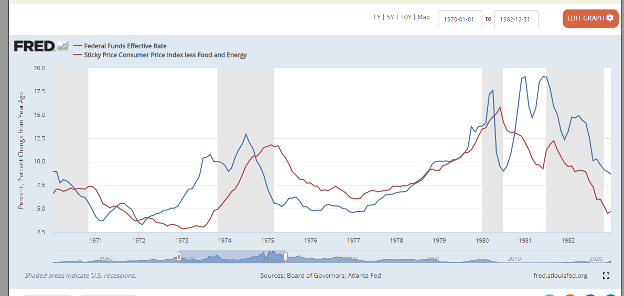
Getting inflation under control will take a certain amount of brutality on the part of the Fed’s chairman. The interest rate levels that will be needed to get inflation under control are going to shrink the economy before the job is done. The risk of a recession will become very high, and a soft landing is something of a unicorn.
Ultimately, this situation is not going to be good for the financial markets. In the short run, we are still seeing a lot of dip buying and pivot talk from traders who have never experienced high levels of inflation and have no knowledge of what has to be done to put the dragon back in its cage.
A prolonged period of stagflation will have a much more negative impact on the economy than a mild-to-moderate recession. Keep in mind, we are starting from a much stronger place than we have for most prior economic downturns. Many consumers still have cash after building bank balances during the early stages of the pandemic. The banking industry is in fantastic shape, with excess capital and pristine loan portfolios.
The economy can handle a mild recession. However, it cannot tolerate prolonged inflation.
Neither can the federal budget. Keep in mind that the average cost of our debt in 2021 was about 1.6%. At that level, the debt service on the national debt represented a very manageable 9% of the federal budget.
Now, remember that the government is made up of people whose only skill set seems to be conning people into voting for them, along with a few million bureaucrats whose primary goal is protecting their jobs. These folks worked together to put into place a policy decision that financed most of the so-called pandemic “money printing,” with debt maturing in less than two years.
About half of all the money the federal government owes is short-term. However, if that debt rolls over at two to three times the rate we currently pay, the debt service will rise to unsustainable levels very quickly.
The Federal Open Market Committee (FOMC) members are aware of this potential problem. Fed chair Jerome Powell is certainly aware. The central bank needs to take brutal actions to contain inflation by late 2023. Doing so will mean that interest rates will have to go higher, and stay there until the mission is accomplished.
That is not priced into stocks at current levels.
Commercial real estate deals are still being done with a cap rate of 5%, when 7% is a more realistic number. I have been using 8% when calculating the net asset value (NAV) of real estate investment trusts (REITs) for months. Many buyers remain anchored to lower rates, and that is causing some inflated valuations.
Traders seized on indications in the latest Fed meeting minutes that the rate hikes would probably slow down. Unfortunately, they completely ignored the part of the report that found: “The ultimate level of the federal funds rate that would be necessary to achieve the committee’s goals was somewhat higher than they had previously expected.”
Interest rates are not the only potential pitfall facing the stock market.
The consensus estimate for the combined companies in the S&P 500 index is 1 for next year. The price-to-earnings (P/E) multiple on that forecast is 17.3, well above the historical average of 16 for forward P/E ratios. And the current P/E ratio on a trailing basis is 21. Analysts are projecting that earnings for 2023 will be 5%–10% higher than they were this year, and the P/E ratios will expand.
I have a hard time seeing how either prediction is true.
We are not in a recession yet, but we are headed in that direction and will almost certainly get there at some point in 2023. Higher rates are already starting to cause some weakness in economic numbers. Earnings next year are likely to be lower than they will ultimately be for 2022.
The 10-Year to 3-Month U.S. Treasury Yield Curve has gone eight for eight over the last 50 years. Every time the curve inverts, a recession soon follows. And as you can see in the graph below, it is already inverted.
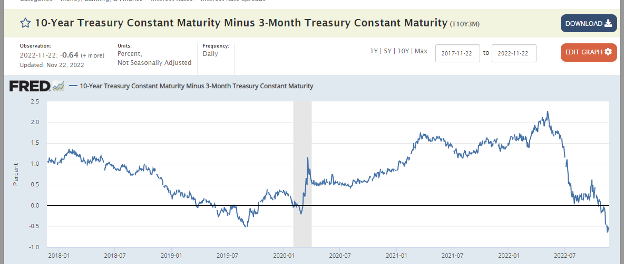
On top of that, higher interest rates should lead to a lower P/E ratio.
It is conceivable that we will see earnings come in at 0 or less for the year, and the earnings multiple will pull back to below-average levels. That combination would lead to much lower values for the index. For example, a P/E of 15 on earnings of 0 would put the index at 3,000, or about 25% lower than the current level.
It would be a lot easier to get excited about stock market prospects if I saw lower valuations and more fear. However, I am not seeing any of “I am never buying stocks again” type of sentiment that usually marks a significant bottom in the stock market. Both the Cboe Volatility Index (VIX) and high-yield credit spreads are trading at levels indicative of complacency, not fear.
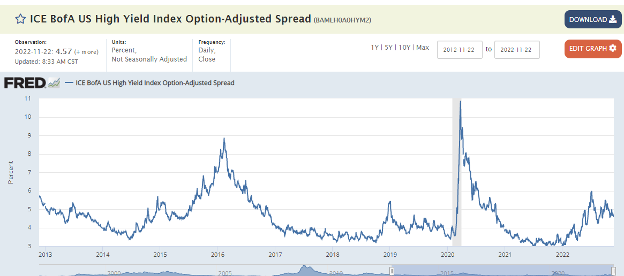
I am not a perma-bear when it comes to stocks. I cannot wait to get bullish and be an aggressive buyer of heavily discounted closed-end funds (CEFs) that own equities. Buying CEFs when panic levels are high and volatility is spiking has worked very well for me several times during my career, and I look forward to doing so once again. But as long as people are consistently calling for a Fed pivot and enthusiastically buying the dip, I have a hard time seeing a lasting rally developing.
We will get there. It may be frustrating at times to wait, but I find it easier to wait for the right funds at the right price than it is to ride out a steep decline like the one I suspect will happen when the reality of inflation and interest rates begins to take hold with investors.
I feel the same way about high-yield CEFs.
Let me get it on the record that I love junk bonds and always have. I started in the markets as Michel Milken began the blast-off stage of his career in the 1980s. Junk bonds remade American business and changed finance forever, and all the credit for the revolution goes to Mr. Milken.
My first big plunge into CEFs was in the early 1990s after Mike Milken and Drexel Burnham were toppled from power and junk bonds collapsed. In the late 1980s, retail brokerage firms made a fortune packing up junk bonds into closed-end funds to give retail investors access to these high-yielding securities.
When the junk market collapsed, fearful retail traders dumped the funds, and discounts ballooned to well above 20%. Yields on the funds were more than 15%. Snapping up these funds worked out extraordinarily well.
That same trade has worked for me in every market collapse since then. First, stocks sell off, and junk bonds follow the market’s lead. Then, the funds begin to drop and talking heads start discussing the evils of junk bonds, so retail investors sell at any price. Then, I buy what they’re selling off.
Right now, retail is far from panicked about junk bonds. Instead, they are buying high-yield exchange-traded funds (ETFs) and mutual funds like they’ll get a free puppy and a milkshake with every purchase… even though yields are less than 6%.
The average discount to NAV in high-yield CEFs is less than 5%. Currently, many popular high-yield CEFs are trading at a premium to the NAV. That is hardly indicative of a massive buying opportunity in the asset class.
I am not sure when the buying will end, but I am confident it ends badly for those buying risk assets at paltry yields.
Their bad ending will be our opportunity, but as is the case with stocks, that opportunity has yet to arrive.
Oil markets have fallen a bit in the last month as China’s coronavirus lockdowns continue to reduce global demand. In addition, fear of the inevitable U.S. recession is also bringing some selling pressure into the energy markets.
China has seen riots across parts of the nation because of ongoing lockdowns, such as the one in an Apple factory where workers protested being locked down for more than a month. But eventually, China’s lockdowns will end, and that demand will come back into the markets, increasing prices again.
Any decline in oil and gas prices will be short-term. Not only will Chinese demand increase, but the looming Russian oil embargo will take a lot of production off the market. Russia has also said it will refuse to sell oil to any nation that institutes a price cap for Russian oil, which will further reduce supplies.
Most of the world’s oil is still owned by people who hate the United States and have no interest in helping us. There haven’t been any massive oil finds to help lower prices domestically, nor are any refineries being built in the west for the oil currently produced here.
Our politicians continue to refuse to accept the fact that all the renewable energy targets for 2030 and 2050 are a pipe dream. Meanwhile, there is a global energy shortage that threatens to turn into a crisis, and renewables cannot currently produce enough to meet the rising energy demand.
Oil and gas will continue to be used. If western nations insist on turning off their nuclear plants and discouraging oil and gas exploration and production, coal usage will continue to rise and increase carbon emissions even more.
There will always be volatility, but oil and gas prices will remain elevated for a long time. That’s why we remain overweight on oil and gas assets in the Underground Income portfolio right now, and, I suspect, we will be for a long time.
I expect to see tremendous opportunities develop in stocks, junk bonds, real estate, mortgages, and other asset classes, but now is not the time to move on these investments.
Patience and discipline have worked very well for us so far, and I expect that to remain true. I will not make a trade just for the sake of making a trade. But when the time is right, we will move—and move aggressively—to add heavily discounted CEFS to the portfolio.
The time is coming, but it is not here yet.
However you celebrate this time of year, have a fantastic holiday season!
November 1, 2022 - 10:16 am
November 2022 Vol. 1 Issue 6
Things have been hectic since our last issue.
Stocks had a super strong month, as the S&P 500 was up 7.23% for the month of October. The NASDAQ 100 trialed its statelier cousin, but was still up close to 3.5% for the month.
Even the badly battered REIT market recovered by more than 6% in October.
Equities and risk on assets rose on hopes that the Federal Reserve was going to slow the pace of rate hikes because the economy is showing signs of weakness, which some investors assumed would light a fire under equities and real estate.
The bond market has always been the more intelligent market, and bonds continued to be in free fall. The yield on the benchmark 10-year Treasury bond rose from1.55% a year ago to almost 4% today.
According to Edward McQuarrie, an emeritus professor of business at Santa Clara University, this is the worst year for bonds since someone started keeping records back in 1794—bonds fell more than 6% again in October, bringing the annual decline to almost 35%.
There are those who hope that the end is near and the Fed will stop raising rates sometime soon. The problem is that with last week’s rate hike, the fed funds rate has gone from effectively zero to 4%, with little to no impact on the inflation rate.
If the Fed take rates up another 75 basis points at the December meeting, as most economists expect, we will have fed funds at 4.75%, which would bring on additional selling in the bond market.
While there have been some pockets of weakness in the economy, the plain truth is that the consumer is still pretty strong. They might feel gloomy, as seen in the consumer confidence figures from the University of Michigan sentiment numbers, but they are still spending.
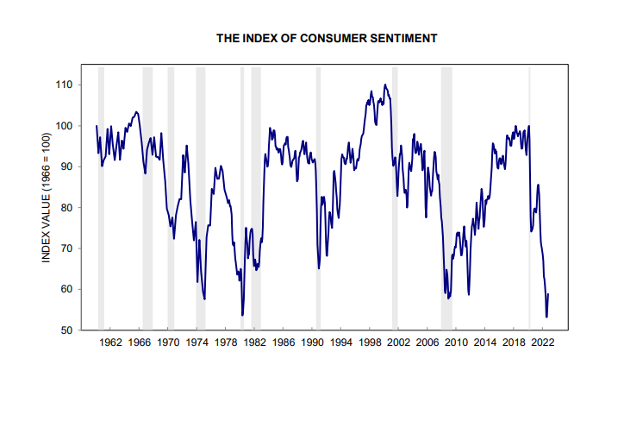
The job market is strong, and the unemployment claims numbers have been more in line with boom times than bad.
There was some discussion in the Fed’s recent Summary of Commentary on Current Economic Conditions by Federal Reserve District—the so-called “Beige Book”—that some employers were considering layoffs in the future, but they have yet to happen.
Gross domestic product (GDP) rose in the third quarter as exports, consumer spending, and government spending were the strongest contributors to growth in the quarter. While the pace of growth in consumer spending slowed from 2% in the second quarter to just 1.4% in the third, it was still stronger than it had been a year ago.
There are signs of developing issues, such as slowdowns in business spending and steep real estate market activity declines, but these are far from bad enough for the Fed to pivot.
The worst news for those hoping for a pivot is that hiking the interest from basically zero to 4% have done nothing to slow inflation. On the contrary, the Fed’s favorite measure of inflation, the personal consumption expenditure price index, rose by more than 6% in September, and core PCE was up 5.1% over the last year.
The economic strength and continued high inflation do not make a case that justifies the Fed slowing the pace of rate hikes.
We learned in the 1970s that you must be brutal to beat inflation. Then-Fed chair Arthur Burns tried the stop-and-start method of fighting inflation in the 1970s. So did Burns’s replacement, Paul Volcker, in his early years in the office.
Eventually, Volcker realized what had to be done: he raised rates rapidly and slowed economic activity to a halt. Then, with inflation put back in the cage, Volcker was able to start lowering rates, triggering an economic boom that lasted two decades.
If the Fed pivots too soon, inflation could spiral out of control, with more disastrous implications for the economy than a mild to moderate recession.
If you trust what the interest rate markets are telling us, we are going to see an economic slowdown in 2023. As you can see, the two/ten-year yield curve has not been this inverted since the internet bubble began to burst.
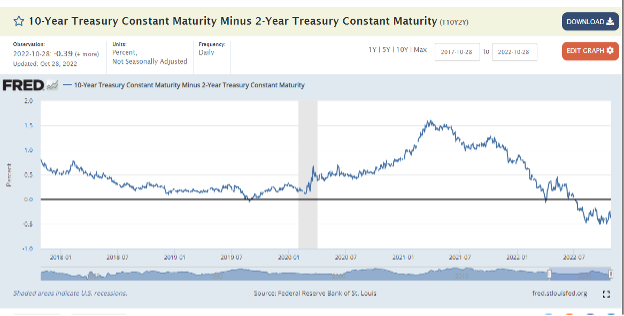
It is something of a frustrating time for investors. Opportunities are developing all around us. Equities are well off the highs of the year—and falling. Valuations are dropping but are not yet at levels that offer outstanding total return potential.
Bond yields are getting attractive, but prices are likely to keep declining thanks to the Fed’s need to continue hiking rates.
Real estate is dropping, but the discounts at REIT closed-end funds still have yet to reach levels that may make me want to dive.
European investments, especially European banks, are cheap, but the Euro-centric closed-end funds are not heavily discounted enough to be a buyer, and activists are not yet moving into these funds.
Emerging markets are trading at much lower valuations than developed markets, as this chart of price-to-book value ratios clearly demonstrates.
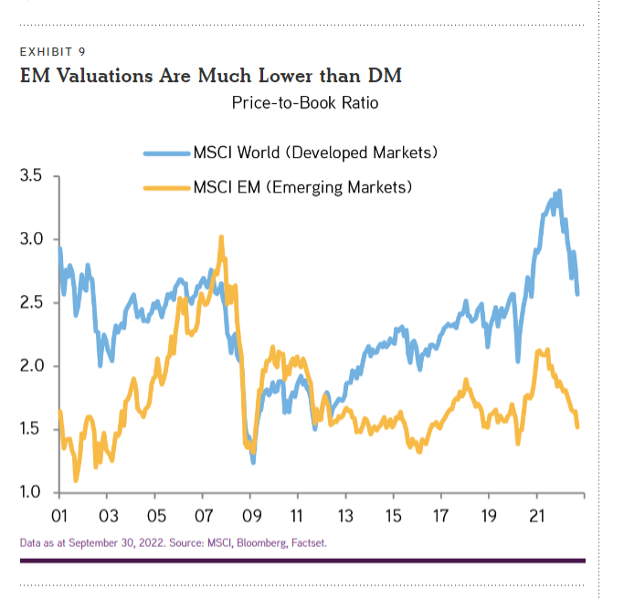
One of the significant barriers to entry for both the emerging market equity and fixed-income markets is the continued strength of the U.S. dollar. Every time it looks like the dollar is going to slow, it rebounds and heads toward new highs.
There is some hope that the recent pullback will begin to mark a change in direction or at least a flattening of the dollar’s rise. Other central banks worldwide are intervening to support their currencies because the strong dollar is hurting their economy.
Many emerging markets have used bonds denominated in dollars, and the climb in the dollar is raising the cost of making principal and interest payments, sometimes to back-breaking levels.
Japan, South Korea, Taiwan, the Philippines, Vietnam, Malaysia, and Thailand have all revealed recent currency interventions to their currency against the surging dollar. India has also been selling dollars to buy rupees in hopes of slowing the decline of India’s currency against the dollar.
We are getting close to the turning point. As you can see in this chart from global private equity giant KKR (KKR), the dollar is nearing its previous peaking points and will likely begin slowing soon.
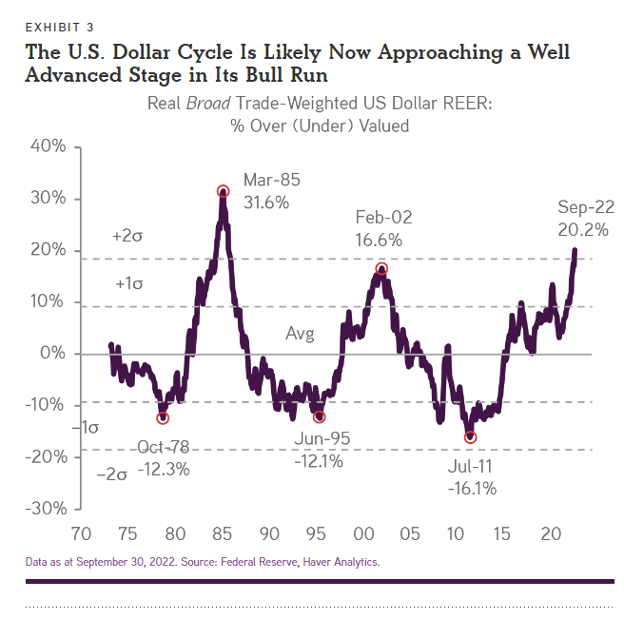
When the dollar does begin to turn, the opportunity for massive profits will exist in closed-end funds that invest in foreign developed and emerging markets.
Thanks to this year’s market volatility, opportunities are developing in markets and assets worldwide. The global need to fight inflation is creating opportunities that will give us incredible profit opportunities.
The frustrating part is that we could have said the same thing months ago. But had I thrown caution to the wind and jumped in with both feet, we would be seeing huge losses in our portfolio right now.
Being patient and disciplined is not always easy, but it is almost always the right thing to do, and that has been especially true when it comes to financial markets in 2022.
Things like activist and insider activity, along with changes to valuations and discount levels, will help tell us when it is time to strike. When that time comes, I promise we will aggressively move quickly to get our money to work.
One opportunity we got right this year has been energy and energy infrastructure assets. We have been energy-heavy in the Underground Income portfolio from day one and have added when the opportunity to buy heavily discounted funds with activist shareholders arose. If we see a new situation develop in energy-focused closed-end funds, I will not hesitate to add those funds to the mix.
While oil and gas prices are well off their highs, I expect them to remain at elevated levels that generate huge cash flows for energy infrastructure owners—which includes us.
The MLP closed-end funds we own in Underground Income collectively own pretty much all of the pipelines, trucking trains, marine terminals, gathering and processing facilities, and everything else involved in moving oil and gas from point A to point B. Most of these facilities have long-term take or pay contracts with energy companies that deliver high levels of reliable cash flows.
Through the magic of closed-end fund accounting, we turn this partnership distributions report on complex K1s into ordinary dividends reported on a plain old 1099.
Oil and gas companies have been lambasted by politicians and the media lately for earning windfall profits thanks to higher oil and gas prices. The President has demanded that these profits be taxed or somehow shared with U.S. consumers.
The idea of a “windfall tax” for the oil and gas industry has been kicked around the halls of the U.S. Congress in recent weeks. However, Chevron CEO Mike Wirth pointed out that the industry has up-and-down cycles, and companies must deal with the bad and good times. Thanks to both government energy policies and the geopolitical issues surrounding oil and gas, Wirth observed, prices and profits are elevated. He also cautioned against taxing oil and gas companies, as there could be unintended consequences. He said on Bloomberg TV recently that “Typically, if you want less of something, you tax it.”
If oil and gas companies slowed down production, there would be less of the stuff, and prices would go even higher.
Ironically, taxing oil and gas will reduce the amount of money being spent on renewable energy projects. Oil has been spending big bucks developing renewable energy projects in recent years. Just last month, Exxon (XOM) announced its first commercial project to store carbon underground, working with a pipeline company and fertilizer producer CF Industries (CF)to capture and sequester two million metric tons of carbon per year at a Louisiana plant.
That is the equivalent of switching 700,000 cars from gas to electric motors.
None of the money taken from energy companies as an extra tax will be earmarked for return to consumers. Instead, it will go into the general coffers for so-called investments in the projects favored by the current occupants of the White House and Capitol Hill.
Exxon CEO Darren Woods said in his most recent earnings release that Exxon was returning cash to the consumer in the form of dividends. While those remarks did not make President Biden very happy, as owners of both Chevron and Exxon thanks to our Adams Natural Resources fund position, we should be big fans of Exxon’s dividend hikes and continued buyback plans.
Our other holdings continue to hold up well and throw off regular dividends. If you do not need the income, it makes more sense to reinvest the dividends to dollar cost average your way into a bigger position in each fund.
I am vigilantly searching for new opportunities for us to get involved in new positions when all three ways of making money come into play. But, as I promised you on day one of our journey together, I will never force a trade in the Underground Income. We will only enter a position when we are near the point of maximum profitability.
Remember to send your questions so I can answer them in the weekly edition of the mailbag.
That’s all for now. Keep an eye out for our weekly mailbag videos every Monday. Our next Underground Income member meeting at 3:00 p.m. eastern on November 16th. Hang on to this link to attend: https://us02web.zoom.us/j/84617385429
October 10, 2022 - 8:53 am
Saba Capital has taken a 5% position in shares of ClearBridge MLP and Midstream (CEM). The activist said that they were purchasing shares of the fund for investment purposes but intend to have discussions with management about narrowing the discount to NAV.
I had more on this fund on yesterday’s Mailbag and there will be more in the monthly issue but for now, buy shares of ClearBridge MLP and Midstream Fund up to .50.
October 5, 2022 - 10:06 am
October 2022 Vol. 1 Issue 5
The markets are finally starting to take Jerome Powell at his word.
For months traders have been convinced that the Federal Reserve chairman would blink when the economy started to weaken, or when markets declined. After all, that’s what the Fed has done for years now. At the first sign of trouble in the economy or markets, the Fed would ride to the rescue, lowering rates and adding liquidity to the financial system.
Powell has been trying to alert market participants to the fact that this time would be different. Unfortunately, the Fed had gone too far in the recent past, and the excessive amount of money printing ignited the highest levels of inflation we have seen in over 40 years.
I remember cringing a couple of years ago when Powell suggested that since inflation had run below the2% target for so long, it would be okay to let it run a little high to keep the economy moving forward.
It didn’t end well when Richard Nixon suggested that then-Fed Chair Arthur Burns should let inflation run a little hot to accelerate economic growth. That ended with double-digit inflation rates and a prolonged period of stagflation that crippled the U.S. economy.
I was pretty sure that’s how it would end up if Powell and company tried the same trick.
They did, and it did.
Of course, the failures of the global supply chain didn’t help matters. Neither did Vladimir Putin’s decision to invade Ukraine. And the result of a few decades of moronic energy policy that caused supply-demand imbalances in oil and gas just made matters worse.
Inflation quickly became out of control, and Powell is all too aware that he has to do whatever it takes to get the dragon back in the cage.
That’s really not going to be good for the stock and bond markets in the short to intermediate term.
The expectation that the Fed would be able to raise rates a little bit to end inflation and then bring them right back down to push the economy forward has finally been dashed on the rocks of reality.
The Federal Open Market Committee, which sets monetary policy, now expects to see a fed funds rate of 4.6% before inflation heads in the right direction. The committee believes GDP growth will slow to about 1.2%, and unemployment will climb as high as 4.5% next year.
It’s going to be a little bumpy, but I do not think we are facing the end of the world or anything that resembles 2008.
Consumers are still fairly healthy, with balance sheets as strong as they’ve been in decades. If we look at the below chart of consumer debt service ratios, we can see that although it has bumped up some from the lows, consumers are spending much less than they have to service their debts than they were in previous periods of economic weakness.
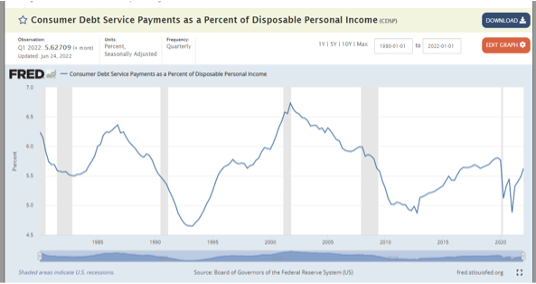
If this number begins to accelerate rapidly, I will reconsider my economic expectations.
Thanks to social media and a heavily slanted 24-hour news cycle, consumers are far more concerned about what’s going on in the economy than they probably should be right now. When we look at the University of Michigan Sentiment numbers, we see that consumers have the lowest expectations since Jimmy Carter and the Great Malaise.
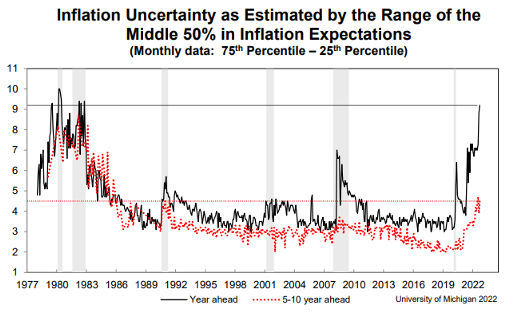
The dour sentiment is one of the biggest threats to my expectations of a mild to moderate recession. Consumers who are afraid to spend can be every bit as bad as consumers who are unable to spend.
The other significant sits in an office in the Kremlin plotting his next move. Although the Russians have been pushed around on the battlefield the past few months, Vladimir Putin does not appear to be done in Ukraine. On the contrary, he issued conscription orders for 300,000 additional troops to keep up the fight.
Anything that continues this conflict will put more pressure on the global supply chain and put upward pressure on energy prices.
For his part, Putin is determined to continue the conflict and once again warned the West that he is willing to use nuclear weapons if necessary to keep Western nations out of the fight. In addition, Deputy Chairman of the Security Council Dmitry Medvedev reminded Western leaders that Russia’s hypersonic missiles could quickly reach European and American cities.
How far Mr. Putin is willing to go in his quest is a question mark that will hang over the global economy and international financial markets until this conflict comes to an end.
While I do not expect a severe recession, I anticipate further weakness in the stock and bond markets for the next several months at least. Bond yields will rise as the Fed does more rate hikes to get inflation under control.
Investors have not had to deal with consistently rising rates for more than a decade. In some segments of the market, we have built castles in the sky supported by an illusion of a foundation based on low-interest rates lasting pretty much forever.
That illusion has been shattered at last, and we will see more selling pressure before all is said and done.
Our current portfolio is heavily weighted towards oil and gas, with little exposure to overheated segments of the stock market. Our only pure equity fund in SRH Total Return (STEW) consists of 40% Berkshire Hathaway with the balance invested in large-cap stocks J.P. Morgan (JPM) and Pfizer (PFE). The fund also has a heavy energy weighting with names like Enterprise Products (EPD) and NRG Energy (NRG).
It even has a big stake in the Cohen and Steers Infrastructure Fund, a closed-end fund that invests in oil and gas infrastructure assets.
I won’t lose a minute of sleep worrying about how this fund performs in the short run. If it goes down too much, we will just buy more of it.
Watching Jamie Dimon and other bankers square off with congressional leaders recently was a stark reminder of how badly managed our national energy policy has been and still is. When Representative Rashida Tlaib of Michigan asked if his bank had a policy of not funding new oil and gas projects, Jamie answered, “Absolutely not, and that would be the road to hell for America.”
Dimon later pointed out to that august body of dummies that oil and gas are an enormous part of the solution to CO2 emissions, saying: “We aren’t getting this one right. The world needs 100 million barrels effectively of oil and gas every day. And we need it for ten years. To do that, we need proper investing in the oil and gas complex. Investing in the oil and gas complex is good for reducing CO2. We’ve all seen, because of the high price of oil and gas, particularly for the rest of the world, you’ve seen everyone going back to coal.”
It is not just smaller nations burning more coal either. Larger developed countries have had to turn to coal to meet electricity demand on a cost-effective basis.
I find myself repeatedly having to remind folks that I am not against renewable energy. On the contrary, I am all in if I can buy renewable energy producers or infrastructure at the right price.
One of our energy funds, Kayne Anderson NextGen Energy and Infrastructure (KMF), is already buying next-generation energy assets as well as traditional fossil fuels infrastructure. That fund owns things like Brookfield Renewable Energy Partners (BEP), a billion collection of renewable energy assets, and Atlantica Sustainable Infrastructure (AY), a global renewable energy company. About 20% of the fund’s portfolio is now in renewable energy infrastructure.
So again, I am not opposed to renewable energy…but I have done the research instead of just listening to the politicians.
We cannot get to where they want to be in anything close to their suggested time frame.
The energy grid cannot handle extra demand from 100% electric vehicles.
We will have shortages of everything from rare earth metals to copper that slow down the transition.
I have talked about all of this before. We need more oil and gas for much longer than even the decade Mr. Dimon suggested.
Because of that, there will be a huge demand for oil and gas infrastructure for decades. In addition, the demand for liquified natural gas to solve Europe’s dependence on Russia will create a need for more LNG infrastructure.
Owners of fossil fuel infrastructure will collect tidal waves of cash for decades.
Buying these assets in a closed-end fund that is heavily discounted is bargain shopping at its finest.
GMO, the asset allocation-based investing firm run by Jeremey Grantham, recently released its newest seven-year asset class performance projection. Once again, very poor long-term performance is expected in both large and small stocks in the United States. U.S. bonds fare even worse than stocks in their forecast.
Once again, the leading performers are expected to be emerging market stocks and bonds.
I suspect that Mr. Grantham will be proven correct in this forecast. Thanks to our position in Morgan Stanley Emerging Mkts Domestic Debt (EDD), we have a little bit of emerging market debt in the portfolio.
I would like to have more, but as you can see in this chart from Finviz.com, the dollar is not quitting. With all the madness in Russia, a more robust economy, and higher interest rates than most of the world, the dollar is trading at close to 20-year highs.
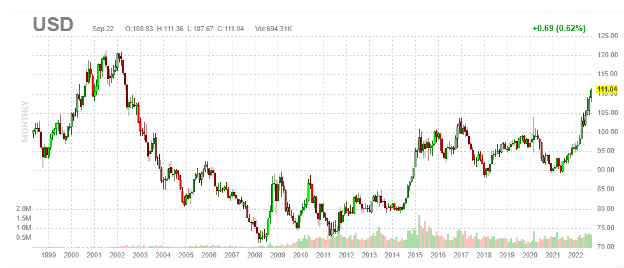
Until we get some meaningful slowing of the dollar’s rise against other currencies around the world, we have to move very slowly and pay very close attention to activist and closed-end fund specialists’ buying activity in this sector.
The opportunity will be there at some point, but that will not be today, unfortunately.
No one wants to be fully invested more than me, but as I have said repeatedly, we will put these trades on when the time is right and everything is lined up to give us the highest possible probability of profits.
If we jumped right in the pool with 20 or so funds back in May, you folks would not like me much right now as we would have significant losses.
If we jumped aggressively into the emerging markets debt funds instead of waiting until we saw large purchases by leading activists, we would also have pretty big losses.
I am watching, waiting, and tracking opportunities daily. When the time is right, and the factors are all lined up, we will move and move quickly to add heavily discounted funds to the portfolio.
In the meantime, if you didn’t catch Monday’s weekly video you can watch it here.
Tim Melvin
Editor
Underground Income
September 6, 2022 - 6:00 am
September 2022 Vol 1. Issue 4
I know a lot of people would like to end the Federal Reserve. Others want to audit the Fed.
Some think we should peg the dollar to the price of gold.
Years ago, the father of value investing, Benjamin Graham, wrote a book called World Commodities and World Currency, in which he proposed a currency backed by a basket of commodities. I actually think that one makes enormous sense and would support such an idea.
In truth, it does not matter what I, or anyone else, think about our monetary system.
We have a fiat system based on the full faith and credit of the United States. So does the rest of the world. Should we try to move a commodity-based currency while the rest of the world stays on fiat, we would be arbitraged into bankruptcy: the rest of the world would have our commodities, and we would have their paper.
One of the reasons that we left the gold standard in the first place was because in August of 1971, France sent warships to New York to collect its share of the gold. The country was concerned about the United States’ financial stability because of growing inflation from the Great Society program and the war in Vietnam. In addition, France suspected the United States did not have the gold reserves to back all the currency in circulation.
Shortly after that, Richard Nixon ended the convertibility of dollars to gold.
We have to work with the monetary system we have, not what we wished or imagined we should have.
Why do we even care about monetary policy?
It is simple, really. Fed policy makes markets move.
Back in the 1980s and 1990s, a fund manager named Marty Zweig was widely followed. He had built a solid track record as a growth stock investor but was best known for predicting the crash of 1987 two days before it happened on Wall Street Week with Louis Rukeyser.
The show has been off the air for years, but back then, it was must-see TV for all things Wall Street.
Marty Zweig had a very important trading rule that he followed. It was simple but effective: Don’t fight the Fed.
If the Fed is loosening and lowering rates, the odds are that stocks will go up.
If they are tightening, stocks will go down.
It is easy to understand when you realize that rising earnings make stocks go higher over time.
Earnings rise and fall based on economic activity. The availability of money and credit drives economic activity. And the Fed determines the availability of money and credit.
This chart from Yardeni Research clearly shows how correlated stocks have been with Central Bank activity:

As closed-end fund discount arbitrage investors, we deal with asset classes besides just stock—so we don’t have to consider just stocks, and maybe we don’t have to worry about the Fed as much, right?
Not exactly.
If the Fed raises rates, existing bond portfolios will decline in value. That’s governments, corporate, junk, municipalities, or any other type of bond. Higher rates make values fall.
Interest rates impact the valuation of real estate as well. Capitalization rates are the most important part of the commercial real estate equation. We find the cap rate of a property by taking operating income and dividing it by the cost of the building to give the rate of return.
The cap rate buyers are willing to pay will be tied to current interest rates, which the Federal Reserve heavily influences.
The actions of the Federal Reserve and other central banks around the world heavily influence what happens in all corners of the financial markets.
For that reason, I pay a lot of attention to and talk a lot about the Fed.
It has been a busy month since our last issue.
The biggest question dominating markets has continued to be: “Are we, or are we not, in a recession?”
While we have seen some pockets of economic weakness, the latest numbers released by the alphabet soup of agencies that make up the United States government would indicate that we are not:
- Consumer spending is still moving up, as are wages.
- The United States Philadelphia Fed Manufacturing Index rose in August.
- Unemployment claims fell again last week.
These things do not happen in a recession.
Take a look at the chart below of unemployment claims since 2020.
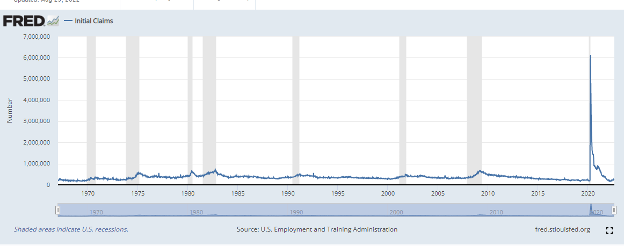
When we had the recession due to the internet bubble bursting, we saw more than half a million claims per week, on average.
During the great financial crisis, claims hit more than 650,000 on average for several weeks.
Claims last week were just 243,000, a number that reflects how strong the job market is right now.
Consumers are concerned, as we have seen from the consumer sentiment numbers from the University of Michigan.
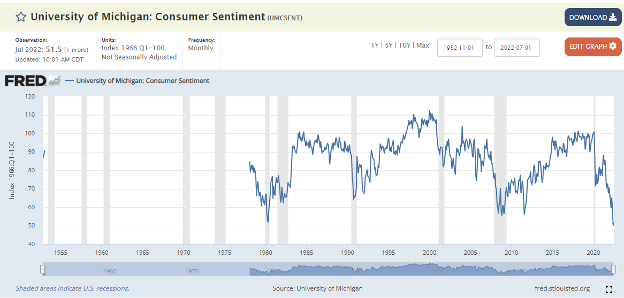
We haven’t seen numbers this low since the Carter Administration. I think the media has something to do with the excessive negative sentiment we are seeing now. We didn’t have internet, social media, or any of the other constant 24-7 news and near-news outlets screaming at us back then. In 1980 cable TV was still pretty much a novelty. Most of us got three channels and occasionally a fourth if you had a good UHF antenna on your set.
Keep in mind that in 1980, interest rates were in the double digits and unemployment rates were at 7.5% and climbing. People had excellent reasons to be in a negative frame of mind regarding the economy.
That’s not as true today.
While there are pockets of weakness right now, I find it difficult to call this a recession.
Don’t get me wrong. As I have said before, I think we are probably heading for one. Inflation numbers came in at the end of August, and the Federal Reserve’s favorite inflation indicator, the personal consumption expenditures price index (PPCE), showed a year-over-year rise of 6.3%. Much was made of the fact that this was lower than in June, but the core number excluding food and energy was slightly higher month over month.
A decrease in energy costs primarily drove the drop in total PCE. Much of that decline results from oil releases from the Strategic Petroleum Reserve, which will be ending soon.
Although many traders had hopes and dreams of the Fed pausing the pace of increases in response to some of those pockets of economic weakness, Fed officials went to great lengths last week to dash those hopes.
Esther George, the president of the Kansa City Federal Reserve Bank, said that she thought the Fed funds needed to be at 4% by the end of the year. (We are 2.33% as I write this, with a target range of 2.25-2.5%.)
James Bullard of the St. Louis Fed concurred with George and thinks the rates cut need to be front-loaded to show that the Fed is serious. Raphael Bostic of the Atlanta Fed also said during the week leading up to the Jackson Hole Fed gathering that he also thinks rates will need to elevate for some time to control inflation.
Then, last Friday, Fed chair Jerome Powell delivered the final blow in Jackson Hole. He made it clear that he expected the jobs market to weaken and the economy to lose some steam during the fight against inflation.
The Fed will not deviate from its current course. Rates will go higher by a considerable amount and stay there until inflation is under control and the Federal Open Market Committee is comfortable that inflation will remain at or below the 2% threshold.
That spooked traders, who started to get a clue that the Fed put they have relied on—many for their entire careers—has expired.
What does this mean for us as closed-end fund arbitrage traders?
Hopefully, it means opportunities are being created. Discount levels across the closed-end fund have been narrow for much of the year, but another dose of inflation drive interest rates fears could push discounts to much more attractive levels.
As you can see, the high-yield credit spreads indicator that I follow has once again started to move higher. Fear-based selling could push discounts to levels that attract the activists (and us) into select funds as enthusiastic buyers.
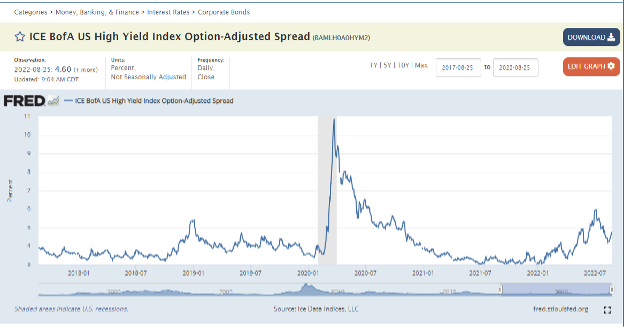
I did make an addition to the portfolio this week: Angel Oak Financial Strategies Income Term Trust (FINS) shares, one of my favorite fixed-income closed-end funds.
The fund deals with a segment of the fixed income market that is incredibly attractive, with strong yields and a very low-risk profile. The fund invests in debt issued by small regional and community banks, a niche sector dominated by institutions. You and I would never be able to access these investments without a firm like Angel Oak making a fund available.
The fund merged with another Angel Oak fund, Angel Oak Dynamic Financial Strategies Income Term Trust, a few weeks ago, and I have been waiting to see how it stabilized post-merger. The discount did not widen much at all, so I decided it was time to move in and make a purchase.
The merger was done to give the fund manager more capital to deploy now as Angel Oak sees massive opportunities in the community bank debt markets.
Interest rate moves do not heavily influence these markets. They tend to be bought and never sold, so you don’t see much paper coming into the market due to selling activity based on rate movements.
FINS focuses on high-quality credits. All the bonds are rated as investment grade or, in the case of smaller unrated bonds, are considered by Angel Oak fund managers to be the equivalent of investment grade.
If you are familiar with my work, you know that I have a passion for community bank stocks. Buying high-quality community bank stocks for less than book value is a wildly successful approach to equity investing, and I think it will be the same for community bank debt.
The capital levels in the banking industry are among the highest ever. Bank loan portfolios are in excellent shape.
While some investors expected bad news for the banking sector in the second quarter, all of the negativity was restricted to the largest banks. Community banks saw increased loan demand and deposit growth in the quarter. In addition, loan delinquencies and losses declined from already very low levels.
As you can see in this chart from the Federal Reserve, the expected slowdown in loan demand has not happened, by any stretch of the imagination:
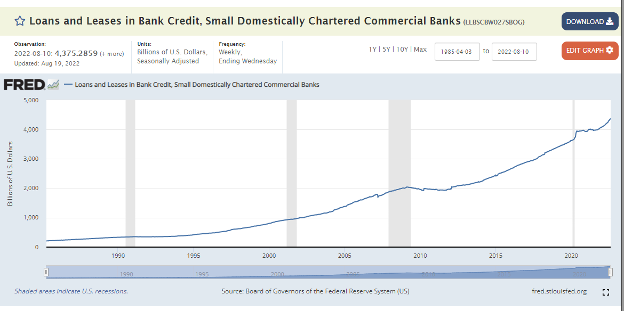
The industry is in better shape than it ever has been.
I expect to see a minuscule number of problem bonds show up in the portfolio. In fact, I will not be surprised if we never see any. I went through the portfolio and am familiar with pretty much all of the little banks in the portfolio. They all have high capital levels and ridiculously low nonperforming asset levels. So, barring an end of the world level event, none of the banks will ever default, in my opinion.
The average duration of the bonds held in the fund is just three years. As a result, we are collecting a payout of 9.2%, which is on par with riskier, longer-dated bonds than the ones we own in the fund.
The current discount to net asset value is 9.86% right now.
It is a term trust with a 2031 expiration date with a very attractive low-risk yield, so as riskier fixed income assets sell-off in response to Fed activity in the back half of the year, I would not be shocked to see this fund trade at a slight premium.
Neither would many closed-end activists and specialists, as several were buying aggressively in the second half of the year, according to SEC filings.
If the discount widened out because we entered a recession, I would consider doubling down and making FINS our biggest holding.
Energy remains the biggest position in the portfolio. We have three energy-specific funds, and our stock fund, SRH Total Return (STEW), has just increased our energy exposure to an even higher level.
Berkshire Hathaway, Warren Buffett’s investment vehicle, accounts for 40% of this fund. Mr. Buffett added billions of dollars worth of both Chevron (CVX) and Occidental Petroleum (OXY) to his portfolio during the first quarter of the year.
He already owns 20% of Occidental but has gotten permission from the regulators to increase that stake to 50% of the company. That means he hopes to add as much another billion to his stake in the company.
Berkshire also owns billion of Occidental preferred stock and has warrants to buy another 83.9 million common shares for .62 each. They obtained the warrants back in 2019 when they financed Occidental’s purchase of Anadarko.
Warren Buffett is a pretty smart guy. Given the wide range of businesses he owns at Berkshire, he has a pretty good grasp of what’s going on in the economy. He is not buying major oil companies because he thinks oil and gas are going down anytime soon.
Buffett owns a major utility company. He is well aware that decades of poor energy policy have led to a situation that creates very high energy prices.
I am very comfortable being overweight on carbon fuels right now. Demand is going to continue growing, and there is no new supply or refining capacity coming onto the market any time soon.
The U.S dollar is acting like it is going to slow down the rocket ship impersonation it has been doing all year. That should be fantastic news for our emerging markets debt fund, Morgan Stanley Emerging Markets Domestic Debt Fund (EDD).
I also have several other high-yielding foreign debt closed-end funds on my radar screen that I would love to add to our portfolio if the dollar continues to at least slow its rate of ascent.
That’s all for this month. Keep an eye out for our weekly mailbag videos every Monday and our Underground Income member meeting at 3:00 p.m. eastern on September 21. Hang on to this link to attend: https://us02web.zoom.us/j/84617385429
August 23, 2022 - 12:02 pm
One of my favorite closed-end funds recently went through a merger that increased liquidity and give the manager more cash to put into a lucrative section of the fixed income markets. Now that the merger has closed and it has been long enough that any disruption from selling assets from the fund they acquired, we can go ahead and buy shares of Angel Oak Financial Strategies Income Term Trust (FINS).
This fund invests in debt securities issued by regional and community banks. This is a specialized market usually available only to institutional investors. The discount to net asset value is 10.72, which is well above the historical average discount level. The yield is currently 9.09%.
I will have lots more detail for you on Monday’s Mailbag video and in the upcoming new issue, but for now, I want you to buy shares of Angel Oak Financial Strategies Income Term Trust (FINS) for $ 14.75 or less.
Use a limit order close to the current price to enter your position.
August 2, 2022 - 2:26 pm
August 2022 Vol. 1 Issue 3
The stock market always finds a way to do the thing that will confuse the most people.
The month of July, 2022, was a fantastic example. As the month began, we heard a lot of talk about how bad earnings would be this quarter. Inflationary pressures would eat into earnings, and investors would be dumping stocks. We have seen inflation pressures hit several companies. However, we have not seen a lot of stock dumping so far.
As we entered the last week of the month, the S&P 500 was up for the month, and the tech-heavy NASDAQ was also up, by an impressive 7%.
I have not been in the camp that thought the economy would fall off a cliff when the Federal Reserve started raising interest rates. My read on interest rate markets suggested that we would see the weakest point in the economic cycle occur in 2023. Consumers still have a lot of cash from the past two years.
They have also proven to be quite willing to use their credit cards. JP Morgan (JPM) and Wells Fargo (WFC) reported a 17% jump in credit card loans in the second quarter. American Express (AXP), which tends to have a more affluent clientele, said cardholders increased spending by more than 30% in the quarter.
The jobs market is still healthy. We are seeing some announcements of layoffs and hiring slowdowns, but the unemployment numbers are still well below historical norms, as you can see in the below chart from the St. Louis Federal Reserve.
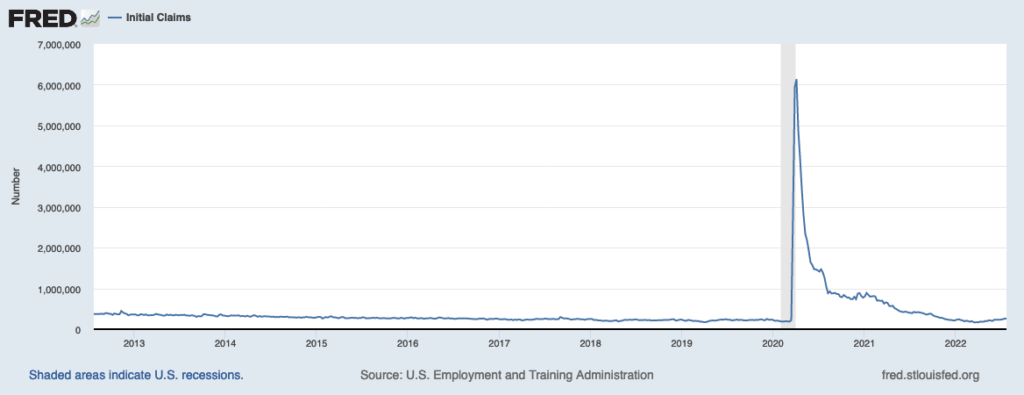
We will know more on the jobs front when we see the July Report on August 5. The average estimate is for job creation of about 240,000 jobs during the month, but the so-called experts are usually wrong on this number. Still, we do not usually see a recession occur when unemployment is low and spending is still reasonably strong.
The markets seem to be leaning on the idea that the Fed will raise rates just enough to beat back inflation and then immediately lower them to spur the economy and keep the party rolling along for stock prices.
Color me skeptical.
I find the chances of things playing out in that manner to be highly unlikely. I am very skeptical that the bottom is in for the stock market for several reasons. First, as the path of high-yield spreads shows, we have not seen enough true investor panic to mark the bottom of the move down.
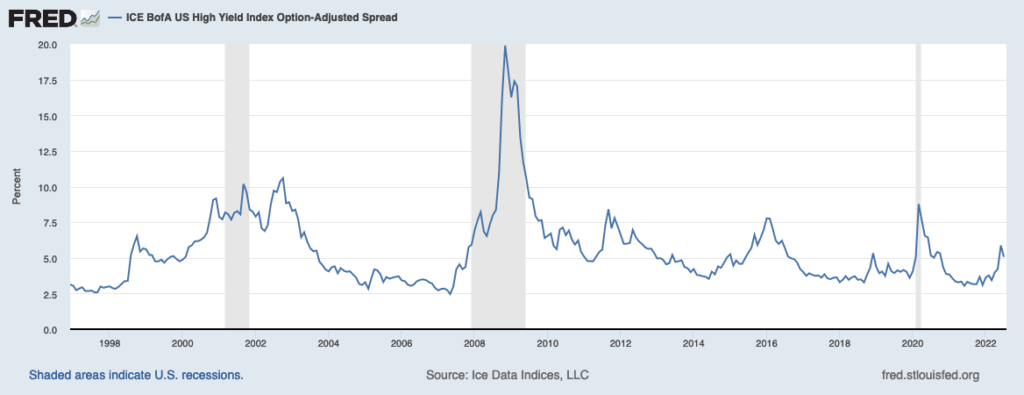
We do not see fear in the level of closed-end fund discounts either. The average discount in both equity and fixed income funds is far below where they have reached in past market declines. Valuations are also still above historical averages, with the S&P 500 trading at 20 times trailing 12-month earnings.
The Fed is probably going to have to go higher with rates than many “hopes-and-dreams” traders are expecting. It is highly unlikely that inflation can be beaten before we see a positive real yield (coupon-inflation rate) across the entire yield curve.
The more bullish of us think we’ll probably see more rate hikes. The shortest end of the curve, the Fed Funds rate, is currently trading at a real rate of negative 7% at the moment, so the Fed has more work to do. It took its first step down that path last Wednesday, announcing the second consecutive 75 basis-point hike in interest rates. The Federal Open Markets Committee also anticipates that ongoing increases in the target range will be required, as will a further reduction in the Fed’s balance sheet.
The language was very clear with the official statement noting that “The Committee is strongly committed to returning inflation to its two percent objective.”
Fed chair Jerome Powell said very little in the press conference that should give anyone any reason to think the Fed will stop raising rates even if unemployment does rise again. He was clear that he expected the economy to slow down and unemployment to rise before the tightening comes to an end.
As of this writing, it appears that stock traders are still in denial about what higher rates could mean for stock prices. I suppose that is not a surprise, seeing as most active market participants were in elementary school the last time we had inflation this high.
This issue has to go into edit and production about a week before you received it, so we will not be able to include all the week’s earnings news this time. About one-third of S&P 500 companies will report this week, including many of the big tech names.
What we have seen as of this writing is a mixed bag. Both Microsoft (MSFT) and Alphabet (GOOGL) had already reported before I submitted this issue, and the results were better than many traders had feared. After seeing Snapchat’s (SNAP) huge earnings miss earlier this month, there was fear that the big firms would also see huge revenue declines.
We still have a lot of earnings to see, with plenty of big tech on deck this week. By the time you get this issue, we will already have chatted about much of this news on our Monday call.
Personally, I hope we see a continued selloff in tech stocks. Tech-oriented closed-end funds have traded this year towards discount levels that will eventually attract activist attention. A full-blown tech blowout sell-off would create a fantastic opportunity for outsized gains for us here in Underground Income.
While much has been made of the fact that many commodities are trading off the 52-week high, that overlooks the fact that rents are skyrocketing. The current housing shortage took years to develop, and it will take years to fix. As a result, rents are likely to remain inflated.
Much has been made of the fact that “Dr. Copper” has recently traded off its 52-week highs. There may be rounds of copper profit-taking, but the truth is that the continued push toward renewable energy and electric cars will create long-term copper shortages that last for years, possibly even decades.
A recent report from S&P IQ found that copper shortages might abate in the second half of the 2030s if everything goes perfectly for the industry with expanded production, and if there are no major disasters or labor problems.
In the real world, regulatory problems, labor strikes, and natural disasters are inevitable, and so copper shortages will last beyond 2040.
Rising copper prices could make it even more difficult to get inflation under control.
Historically higher rates and high inflation levels have led to much lower price-to-earnings ratios for stocks. I see nothing unique about today’s world that should change that relationship.
I won’t be upset if I turn out to be wrong about this: we have an equity fund that will do very well if the markets move higher. I also would expect our energy and emerging markets funds to do well if the Goldilocks scenario for the economy and markets plays out as scripted.
I like what I see developing in the marketplace for BB-rated bonds. BB-rated bonds are at the top tier of the junk bond rankings. They tend to get lumped in with all other ratings below BBB, but in reality, BB-rated bonds are the sweet spot in corporate bonds.
Historically they have much lower default rates than bonds rated single B or lower, but you are not giving up too much in yield. Because of that, historically, they have offered better returns than junkier junk bonds.
They have also performed better than BBB bonds and investment grade bonds historically.
They are the sweet spot of the bond markets, and rates have been rising, as you see from the Fed’s chart.
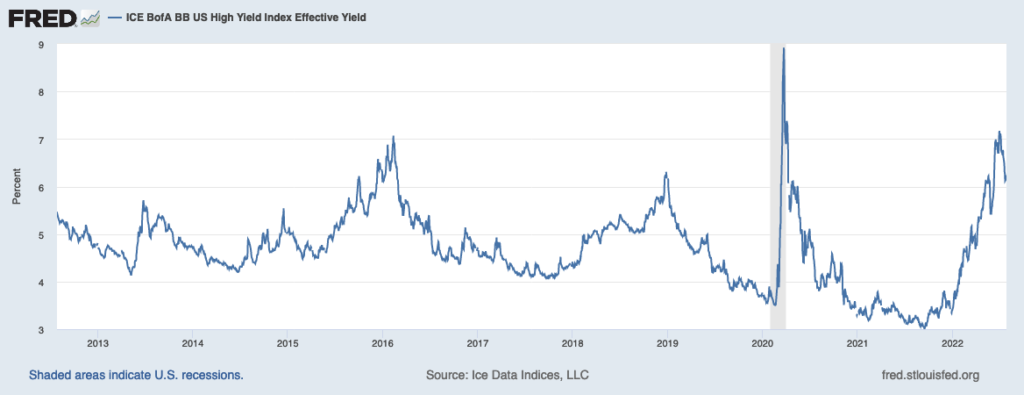
While BB is at the top tier of the “Junk” ranking, let’s be clear that these are not junk companies by any stretch of the imagination. These are not bonds issued by Shifting Sands of Vermont Insurance Company or Shady Nick’s Chicken Joint like you may find at the lowest end of the junk bond rankings.
In fact, some of the bonds issued by Goldman Sachs (GS), the investment bank that dominates Wall Street, are rated BB.
Energy Transfer (ET), one of my favorite MLPs, owns more than 20,000 miles of crude oil and natural gas pipelines. They also own gathering and processing facilities, storage systems, and terminal operations for shipping oil and gas. It is a collection of assets that generates hundreds of millions of dollars’ worth of free cash flow. Their bonds are also rated double-B.
Bonds from the Gap Stores (GPS) are also rated BB. And Citizens Financial Group (CFG), a bank with billion in assets and 900 branches in the Northeastern United States, is a BB credit. KB Homes (KB), Levi’s (LEVIS), and Occidental Petroleum (OXY) are all well-known companies that are also rated double-B.
I could go on, but I think you get the point. Although they are considered high-yield (or junk) bonds, these are fantastic companies that will have no problem making the interest and principal payments on the bonds they issue.
I have gone through the world of high-yield closed-end funds and made a list of all the funds that have mostly BB bonds in the portfolio. I am tracking these funds’ discount levels and shareholders list, carefully looking for an entry point.
It is not quite time yet, but it’s coming. I want to see how the bond markets, particularly the high yield markets, react to the Fed’s next rate hikes and commentary.
I keep hearing all the chatter that energy prices are coming down in the weeks ahead. Again, I could be wrong, but I just do not see it happening in a meaningful, lasting manner any time soon: We have discovered no massive new oil or natural gas supplies. No new refineries have been built in the United States. The major oil-producing nations have not decided they want to be friends with us in the past few months. There have been no new economic incentives created to encourage domestic production increases.
Demand destruction is not happening on anything like the levels I have heard tossed around by market commentators.
Pierre Andurand, the manager of one of the best energy-focused hedge funds in the world, recently said he thinks it is far more likely that we see surprise increases in demand than declines.
On top of everything else pushing energy prices higher, we are now seeing heat waves driving up electricity demand as we move into the dog days of summer. It is not just the United States either—both Europe and Asia are seeing elevated temperatures.
Thanks to the green movement and unrealistic fears of nuclear energy, we now see record levels of coal being burned to produce electricity worldwide. It is the only way to quickly generate enough power to replace all the natural gas and nuclear plants taken offline in Europe in the hopes that wind and solar would magically defy fundamental economic realities and replace the energy quickly and cheaply.
I have little doubt that, over time, renewable energies, including nuclear, will replace fossil fuels, but this is not that time.
We have a strong position in energy closed-end funds, and I think that will be true for some time. Even if we get drastic discount narrowing measures by one of our current funds, there is still a large universe of discount energy closed-end funds that could replace a fund sold to book profits.
The dollar continued to climb over the last month. We already have one emerging market fund in the portfolio, and I am looking for spots to add more. The dollar will probably keep moving higher against most major currencies, but I am starting to see the pace of the increase slow a bit in recent weeks.
Central banks worldwide are starting to join the United States in tightening credit conditions to fight inflation, which should slow the almighty greenback’s rise.
If the slowing continues, I will be looking to add to positions in emerging market debt with heavily discounted funds that activist investors own.
I am also looking for more developed market income funds with similar characteristics.
We will wait for the opportunity to develop further before jumping into positions. Remember: here at Underground Income, we do not force trades.
July 5, 2022 - 12:09 pm
With the markets pulling back sharply today I am going to go ahead and add another infrastructure Closed-End Fund to the Portfolio. This fund is currently trading at a 21% discount to the net asset value and the shareholder list looks a lot like an activist Hall of Fame roster.
I think it is just a matter of time before one of them decides to get aggressive and starts leaning on management to narrow the discount. At the same time, I remain very bullish on energy as the supply and demand picture is still out of alignment and will not change anytime soon.
I will have a lot more to say in next Monday’s video and the next issue of Underground Income but for now, I want you to buy shares of Cushing MLP & Infrastructure Total Return Fund (SRV) at prices up to $ 28.50.
The current yield on this fund is 6.31%.
July 1, 2022 - 10:23 am
July 2022 Vol. 1 Issue 2
This should be hitting your inbox on the Fourth of July. Hopefully, like, me, you are preparing for a long day of celebration with family and friends. We will be poolside with the grill lit and two grandkids and six dogs merrily running amok in the backyard.
I am always mindful of John Adam’s suggestion that Independence Day should be celebrated with “Pomp and Parade, with Shews, Games, Sports, Guns, Bells, Bonfires and Illuminations from one End of this Continent to the other.”
I will do my best today not to let down the founding father.

Are we ready for a recession?
We find ourselves in interesting economic times. Inflation is running very hot, and there are some signs that the economy is beginning to slow as a result. Sky-high prices at the pump and the cash register are taking a toll on everyone’s wallet right now.
When Federal Reserve Chair Jerome Powell recently said that the central bank would be nimble in response to incoming data as they strive to push back inflation, many observers suggested that meant that the Fed would slow the pace of interest rate increases.
It did not.
The next day, before the U.S. House of Representatives, Powell said the Fed’s commitment to fighting inflation was unconditional.
It has to be. Unemployment is low right now, and the economy has been recovering nicely from the pandemic shutdowns. We can handle a recession.
The banking system can handle a recession with ease. For example, all thirty banks that underwent stress testing recently passed the nightmare test scenario of10% unemployment, large DGP declines, and a massive drop in the value of stocks and real estate with flying colors.
The great thing about that is the Fed only tested the thirty largest banks. Community and regional banks are in even better shape than the big guys right now.
The banking system can handle a recession.
The Fed is trying to avoid sustained inflation or the dreaded combination of uncontrolled inflation and a weak economy, known as stagflation. Either of those would be much worse for the economy than a run-of-a-mill recession.
Rising rates and recession fears have weighed on stocks this past month. Many of the broader indexes are down the 20% (and more) required to meet the definition of a bear market. The S&P 500 was down over 20%, but the rally last week pushed prices back above the bear level. Currently, that index is just 18% off the 52- week high, but odds are it will get worse before it gets better.
Very few people working on Wall Street today have ever seen anything like the current conditions. Inflation has not been this high since the early days of the Reagan Administration. If you were a 25-year-old Wall Street newbie when Reagan was elected in 1980, you would be 67 today.
Most folks who stayed on Wall Street that long are so rich they do not need to worry about minor things like the economy or interest rates. Those who are not that rich are likely either long dead from stress or teaching finance at a small college in a peaceful setting.
The evidence that rates are going to continue to rise is compelling. Moreover, the folks in charge of interest rates have made it clear they will keep doing so.
For the last twelve years, we had been in a bull market built on the idea that low interest rates made corporations and assets more valuable. Now rates are rising, so these companies and assets will become less valuable.
The question is: what do we do now?
I rely heavily on high-yield credit spreads to navigate financial markets. I stole the idea from Dan Rasmussen at Verdad Advisors initially, ran my own tests to confirm his conclusions, and tweaked it a bit to fit my goals.
As you can see from this chart, we near a critical turning point in the markets anytime the difference between rates paid on high-yield bonds exceeds those paid on high-quality corporates by 7.5% or more.
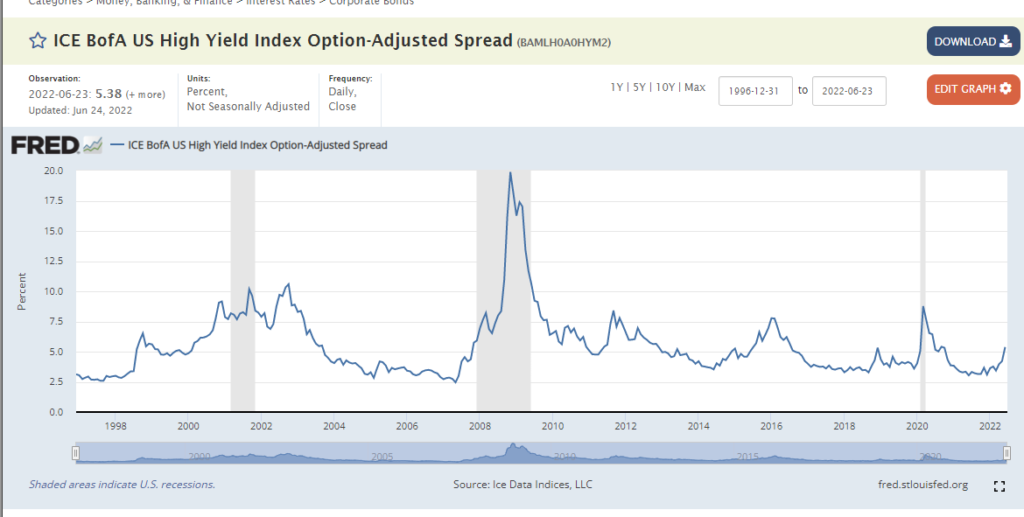
Right now, on this short-term version of the chart, we are at about 5.4%.
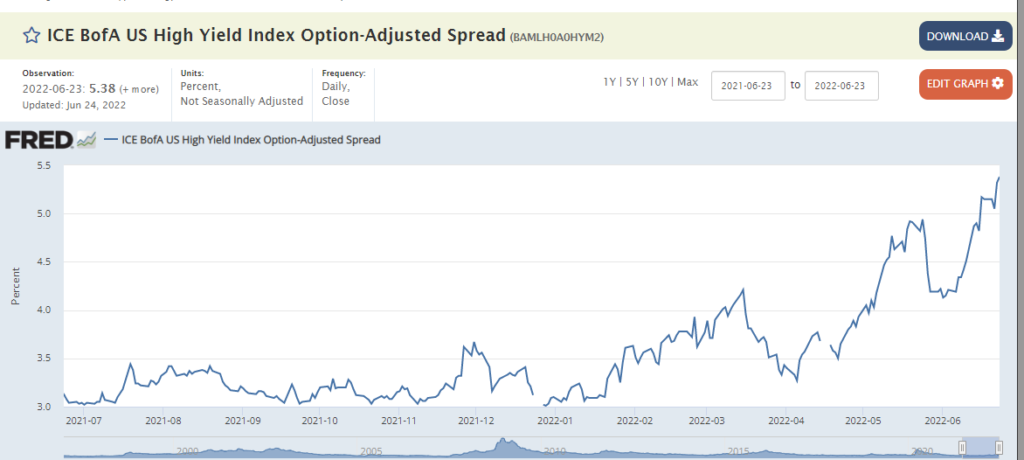
We will probably continue to see some of these bear market face-off rallies like last week, but consider how high valuations were when this sell-off started:
- The S&P 500 PE ratio was over 25.
- The market cap-to-GDP ratio, also known as the Buffet Indicator, was at an unprecedented 200%.
- The CAPE Ratio (10-year average earnings multiple) was 38, the second-highest reading ever. Only the peak of the internet bubble was higher.
I am not a perma-bear or doom and gloomer. When the credit spreads exceed 7.5%, I expect PE ratios and other valuation indicators to be much lower. At that time, I will be an aggressive and enthusiastic buyer of Closed-End Funds that own risk assets like stocks and real estate investment trusts (REITs).
That’s what I did in both 2002 and late 2008. I was a little less aggressive in March of 2020 because what I was initially hearing from friends in medicine and banking was more than a little horrifying. As stimulus-supported business and, more importantly, commercial real estate valuations, began to recover and we learned more about the virus, I got more aggressive.
Over the course of my career, I have learned to love the down.
We are not there yet. We will get there, but we are not there yet.
Underground Income Investments
With our first four funds, we have remained heavily tilted towards energy companies and assets.
While we saw some selling in oil and gas last week, oil and gas prices remain dramatically higher than over the last six months. The idea being floated by bears that demand will slow down as inflation takes a toll is amusing at best.
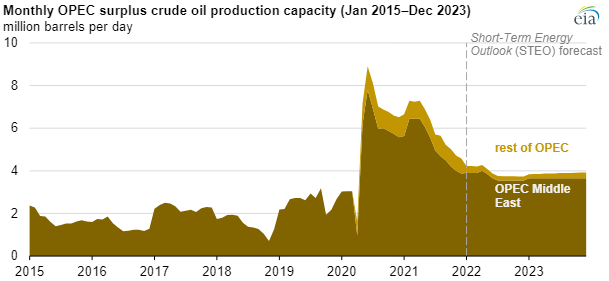
Supplies are falling. Demand is rising. The International Energy Agency thinks energy demand will increase by 3.6 million barrels of oil a day over the summer.
That is not a recipe for falling prices.
If we can find more energy-related closed-end funds that trade at significant discounts to net asset value and strong activists as a shareholder, I will not hesitate to pull the trigger.
Our position in the Morgan Stanley Emerging Markets Domestic Debt Fund (EDD) is more of a special situation. The most prominent closed-end fund activist in the U.S. has a 6%+ position. They have not gone activist yet, but if the discount does not begin to narrow from current levels, I think they will.
Yields on emerging market government bonds are well above rates in the United States, Europe, and Japan. However, we could see them begin to decline over time as resource-rich companies start to see some economic benefits from inflation driving up the value of natural resources, which could lead to gains and potentially some market-driven discount reduction as well.
If the Fed fails to contain inflation or makes the idiotic decision (they are government officials, after all) to pause their inflation-fighting efforts, we could see a sharp sell-off in the dollar that would also be good for this fund’s share price.
Until market forces drive the price higher or shareholders go active, I am quite content to collect my 8.5% dividend.
Given my concerns about the general stock market, should we consider dumping SRH Total Return Fund (STEW) or maybe holding off purchasing it?
Absolutely not.
I would suggest reinvesting the dividends to dollar-cost averaging into the fund. This fund owns some of the greatest companies in America, and not only are they undervalued, but you can also buy them at an additional discount thanks to the closed-end fund’s structure.
Consider what the fund owns. First, 42% of the fund is in Berkshire Hathaway. Berkshire was the first stock I suggested buying in 2020, as they have an incredibly strong balance sheet, many of their businesses are inflation-proof, and some even benefit from inflation.
Warren Buffet himself will tell you there is no such thing as a buy-at-any-price company, but this one is pretty close.
Berkshire owns a lot of traditional energy assets, and it’s also a leader in renewables. BHE Renewables owns and operates solar, wind, hydro, and geothermal projects all over the country.
Higher interest rates will be very good news for Berkshire’s massive insurance operations.
If prices drop far enough, fast enough, Fruit of the Loom could see a surge in demand.
Berkshire Home Services and Clayton Homes will both benefit from the housing shortage that has developed in the United States.
You get the idea. Berkshire Hathaway has a lot of cash on the books and produces enormous cash flow, plus the company owns many great businesses… and we are buying them at a discount to these businesses’ already discounted market value.
The third-largest position in STEW is J.P. Morgan (JPM)—8% of the fund’s money is invested in this banking leader. Jamie Dimon is the very best of the big banks’ CEOs. He understands the challenges and opportunities the economy faces at any given point in time.
The bank has a fortress balance sheet. It passed the stress tests with flying colors, and the Fed has signed off on a massive return of capital totaling .5 billion.
I am pretty sure every dollar in the U.S. economy will flow through JP Morgan at some point in time.
STEW also has large positions in:
- Yum Brands (YUM), the company that owns KFC, Pizza Hut, and Taco Bell. We would have to have a full-blown depression before these companies get too badly hurt. If anything, a mere recession would just increase levels of alcohol use…which would result in a spike in late-night Taco Bell delivery orders!
- Product Partner (EPD), which owns massive amounts of energy assets, including pipelines, storage tanks, marine terminals, a trucking fleet, and anything else needed to move oil and gas from point A to point B.
- Cisco (CSCO), which makes the equipment that makes the internet work. Cisco will also play a huge role in cybersecurity, one of the fastest-growing industries in the foreseeable future. With the stock trading at 12 times earnings, I don’t feel the need to worry about owning the stock through this fund.
I consider STEW to be a Fortress Fund. It allows us to own world-class companies and assets at bargain prices—on top of the bargain prices the fund manager likes to pay for stocks, we are getting an additional 17% discount.
Prices may come under attack in bear markets, but the companies will still be standing when markets recover.
All in all, our portfolio is well-positioned ot handle the current inflationary environment. There will be inevitable ups and downs in the marketplace. Still, we can be quite content collecting high levels of dividends until the action of activists or natural reversion of the market reduces the discount, at which time we will book our gains in the funds we own so far.
There is also an excellent chance that all four of these funds see appreciation in the assets they own, and that’s our third way of making money with activist arbitrage closed-end fund investing.
We did not see much activist activity in June month, and until that changes, do not expect to see a flurry of activity in the Underground Income portfolio. I will not force a trade or bend the strict rules I use for my closed-end fund strategy to the point of breaking so that we have activity in the portfolio.
When the opportunity is available, we will attack. Until then, we grind with special situations like energy, great companies, and emerging market debt at a discount.
A few closing notes:
- The recording of our most recently monthly live session is posted on the website. You can watch it here.
- The next monthly live session will be on Wednesday, July 20 at 3:00 p.m. eastern. No registration necessary, just show up at that time using this link: https://us02web.zoom.us/j/84617385429
- Be sure to catch the Weekly Video Mailbag. They come out every Monday afternoon.
- If you ever have a question just send it to me here.
- And if you’re a Dividend Hunter reader be sure to check out the interview I just did with Tim Pleahn in the July issue here.
Have a Happy Fourth, everyone.
Tim Melvin
Editor
Underground Income
June 10, 2022 - 2:01 pm
The bottom is falling out of the market so we are going to do some buying. We are going to add shares of Morgan Stanley Emerging Markets Domestic Debt Fund (EDD) to the portfolio today. A large activist has accumulated a position of more than 6%. They have not expressed any intentions yet but with the fund trading at a 14% discount to net asset value. I expect to see that happen sooner rather than later.
here are also two other large shareholders who have been known to take activist stands at times.
The fund is currently yielding 8.15%.
I will have more specifics for you on Monday’s call and of course a full writeup in the next issue.
For now, I want you to buy shares of Morgan Stanley Emerging Markets Domestic Debt Fund (EDD) use a buy limit of $ 4.70.
June 3, 2022 - 6:37 pm
Our next – and first – monthly live session will be on June 17th at 3:00 p.m. eastern. Just use this link a minute or two beforehand to join us: https://us02web.zoom.us/j/84617385429
June 3, 2022 - 11:38 am
June 2022 Vol. 1 Issue 1
Welcome to the first issue of Underground Income.
This is a service I have wanted to launch for a long time. Investing in closed-end funds for income and capital appreciation is a strategy that is not one most investors use, simply because they do not know it exists. No one’s broker is telling them how to buy closed-end funds and collect high levels of income while waiting for the underlying assets to move up in price and the discount relative to the asset value to narrow.
Most pundits do not talk about this strategy because it is not a swinging-for-the-fences-every-time-you’re-up-to-bat approach to investing. The all-time leader in runs in baseball history is Rickey Henderson. He was not a home run hitter, but he got on base a lot and made the best of each opportunity. Similarly, the key to making huge profits in closed-end funds is hitting singles and doubles—just getting on base.
That’s the reason Underground Income teaches subscribers one of the best ways to be a successful investor. Every time take a position, there will be three opportunities to make money from the investment. Most of the time, we will have an activist involved in the position pushing management to do all the things necessary to narrow the discount to the net asset value (the company’s total assets minus its liabilities) of the particular fund.
That’s not to say we won’t hit home runs. On the contrary, we will, on occasion, hit the long ball. This usually happens when a market has been selling off, and we are able to buy closed-end funds at massive discounts. This is actually what led to my initial foray into the world of closed-end funds. The high-yield bond markets sold off in the aftermath of the whole Michael Milken/Drexel Burnham implosion. As a result, closed-end high-yield funds that invested in junk bonds traded at massive discounts to their net asset value.
The stock and bond markets recovered quickly after the 1989 decline, and junk bonds recovered quickly. Those previously discounted closed-end funds paid off with dramatic returns for those who had been bold enough to jump in when the funds were trading at discounts of 20% or more to the net asset value of the bonds they owned.
The same opportunity has been available with every significant disruption in the stock and bond markets. For example, in the internet bubble burst of 200-2003, there were significant opportunities in both stock and bond closed-end funds.
During the Great Financial Crisis, I vividly recall sitting in the New York office of one of the most successful risk arbitrage traders and telling him about heavily discounted closed-end funds that traded in convertible bonds. He loved the idea and quickly built a position that paid off with massive gains over the next few years, as markets recovered.
During that time period, closed-end funds that invested in real estate investment trusts traded at massive discounts to NAV of 25% and more. They quickly rebounded, and investors who stepped in when it looked like the world was ending earned huge gains.
As the coronavirus pandemic sent markets reeling in 2020, I wrote a piece that suggested buying two of the oldest closed-end funds in existence, Central Securities (CET) and General American Investors (GAM). At the time, Central Securities, fists listed in 1929, owned the bluest of blue-chip stocks, including companies like JP Morgan (JPM), Cisco (CSCO), and Caterpillar (CAT)… and was trading at a discount of 17%.
General American opened in 1927, two years before Central Securities. On April 4, 2020, when I recommended the fund, the portfolio included market leaders like Alphabet (GOOG), Microsoft (MSFT), and Berkshire Hathaway (BRK-A), and the discount to net asset value was also 17%.
Both funds recovered quickly when the Federal Reserve and the U.S. Congress stepped up to backstop and stimulate the American economy. As a result, investors who took the plunge when things looked bleak had an opportunity to double their money in a relatively short time.
Over the course of our Underground Income journey, there will be huge market disruptions that create the opportunity to hit home runs. I will be ready to jump in and find the best way to get big short-term wins in the portfolio. (In fact, if inflation has its way, this could happen sooner rather than later.)
Most of the time, we will be looking for closed-end funds that trade at discounts to the value of the securities they own, where an activist is working to force fund management into taking steps to narrow the discount. Many of these funds will be paying high levels of income and have potential for their stocks and bonds they own to move higher in price.
The idea behind Underground Income is to collect cash and sell when the discount narrows. There will be three ways to make money every time we enter a position. Sometimes that will be the financial equivalent of a base hit or a double. We will not be swinging for the fences every time up, but instead, we will be looking to make money each time without striking out too often.
When the opportunity to hit home runs is available, we will take them. When the opportunity to make market-beating returns in a less spectacular fashion is available, we will take that as well. After all, as Yogi Berra—who hit 328 home runs during his career—once said: “You don’t have to swing hard to hit a home run. If you got the timing, it’ll go.”
We have launched Underground Income during a period of high volatility and uncertainty in the markets. The Federal Reserve under Jerome Powell made the dangerous decision to let inflation run hot after a long period that was well below the Fed’s two-percent mandate. The idea was that after being so low for so long, we could have “average inflation” of around 2% if we let it run hot for a while to boost the economy.
This was a bad idea when Richard Nixon convinced then-Fed chair Arthur Burns to let inflation loose to promote growth in the early 1970s, and it has been a bad idea this time as well—especially because the Fed totally underestimated the demand surge we would see as COVID-19 transmission began to slow. The global economy surged forward all at once, and the supply chain has been stretched, in some cases to its breaking point. As a result, prices for almost everything have surged higher, and we are experiencing shortages in some essential materials and products. Think about how the current semiconductor shortage, for example, is crushing some industries like automobiles and consumer electronics.
The Fed has now begun raising rates, and they will have to continue to do so for an extended period of time.
In the past, when the Fed tried to raise rates and the markets declined, the central bank backpedaled and quickly bought rates back down. This has happened several times since the end of the Great Financial Crisis. For a long time, the Fed has acted almost like a protective put option to prevent investors from suffering significant losses.
That is not going to happen this time around. The Fed put has expired.
Jerome Powell and other Federal Reserve Open Market Committee members have made it clear that bringing inflation back under the 2% limit is the only thing that matters. If the rate increases continue to cause weakness in the stock market, the Fed will not respond to that movement.
While some have suggested that inflation is peaking already and the Fed will probably not have to raise rates as far as initially thought, I am not yet prepared to join that sentiment.
The big problem with this inflationary cycle is going to be energy. Decades of bad policy have led to a chronic supply and demand imbalance in oil and gas. In the global rush to go green, we have ignored all the evidence that makes it clear that we will still be using oil and gas as a major fuel source for decades to come. All the talk of 100% renewable or 100% electric vehicles by 2035 is a pipe dream.
There are insurmountable roadblocks for the green revolution to succeed so quickly. Both renewable energy and EVs require massive quantities of certain rare earth metals. What China does not have within its borders they have locked up in long-term contracts—and I don’t think they are going to share.
For example, a lot of copper is required for alternative energy technology, and there are not enough copper mines inside our borders to meet the green movement’s needs. And that means we’ll be competing with China and other nations for the needed resources.
We have made considerable investments in renewable energy while doing our level best to discourage new oil and gas production. The result is a shortage that will keep energy prices at elevated levels for a long time. Suppose we started granting incentives to oil and gas exploration and production companies to invest in new production right now. In that case, that investment still won’t pay off in a meaningful manner for several years.
And as of this writing, we are not even thinking about providing these incentives to increase oil and gas production.
In fact, the exact opposite is happening. Oil and gas executives see no need to increase production. By keeping production at its current output level, they are maximizing cash flows. That cash is being used to buy back massive amounts of stock and pay dividends to shareholders.
The Biden administration and green energy advocates may hate oil and gas companies, but right now, their shareholders love them.
The surge in demand for oil and gas due to the reopening of the global economy, combined with these suppressed production levels, has created pricing issues in energy.
Right now, the biggest problem is the looming diesel shortage.
There is almost nothing on any shelf in any store that got there without diesel. Diesel is used by most trains and long-haul trucks, as well as many last-mile delivery vehicles.
The shortage is partially because of the demand surge. And of course, it doesn’t help that jet fuel comes from the same part of the barrel as diesel, and exploding demand for travel has happened at the same time the demand from consumers for just about everything roared from zero to 100.
There is also a refining issue here in the United States. The last refinery built in the United States was a small condensate splitter in Channelview, Texas, capable of processing just 35,000 barrels a day. It does not refine any diesel.
The last large refinery built in the U.S. was completed in 1976.
Since COVID, 13 refineries in the United States have shut down, significantly cut operations, or switched to other petroleum products. That took about 7% of our refining capacity offline, just as demand exploded.
Industry executives are not willing to invest in new capacity, given the massive regulatory measures and enormous costs they will face. They get a bigger bang for their buck by buying back stock and paying dividends.
If diesel stays in short supply, prices will continue to rise…which would make the price of everything in every store continue to climb.
That will make it very difficult for the Fed to get inflation under control.
The prospect of high inflation is finally spooking the consumers who handled pandemic lockdowns without missing a beat. To put it kindly, earnings reports from leading retailers like Wal-Mart (WMT) and Target (TGT) were a disaster. Both retailers lowered their revenue and earnings guidance for the rest of the year because consumers have hoarded cash to spend on fuel and food.
Retailers are getting hit on all fronts because in addition to reluctant consumers, they are also seeing costs rise faster than they can raise prices.
None of the short-to-mid-term economic outlooks are all that great. Unfortunately, there is not much you and I can do about what’s going on in the economy. Fortunately, we can at least turn to the closed-end fund strategy to provide us with opportunity to earn more than inflation can take.
Our first three Underground Income picks are uniquely suited to accomplish precisely that task.
Kayne Anderson NextGen Energy and Infrastructure CEF (KMF)
The Kayne Anderson NextGen Energy and Infrastructure CEF (KMF) is investing in today’s oil and gas infrastructure and is also looking toward the future, when renewables will be a bigger part of the industry.
Now, based on my remarks above about underinvesting in oil and gas, you might think I am anti-renewable energy.
Actually, I am a huge fan of renewable energy—I’m just not a fan of politicians lying to us about renewable energy.
The Kayne Anderson NextGen Fund is invested in an enormous amount of oil and gas infrastructure. The fund owns interests in thousands of miles of pipelines. Every share we buy of this fund makes us an owner of countless square feet of storage facilities. In addition, we own train and truck terminals to move oil and gas around North America.
We also own:
- Liquified Natural Gas (LNG) facilities and pipelines. Many of these facilities are going to play a huge role in shipping LNG to Europe to help them move away from buying Russian oil and gas
- Power plants located all over the world that produce energy using traditional energy sources such as coal, natural gas, and nuclear power
- Solar fields, wind farms, hydropower plants, and other renewable energy sources around the world
With this investment, you can profit from today’s energy needs as well as continued spending to develop more renewable power sources.
And best of all, you can buy all these assets at an 18% discount from the current market price.
Energy-focused closed-end funds have seen a good deal of activist activity since the beginning of the pandemic. This fund has amongst its shareholders known activist investors, including Saba Capital, which has been the most aggressive closed-end fund activist for the past several years.
None of KMF’s shareholders have taken a large enough position to have to file with the Securities and Exchange Commission yet. None of them have announced activist intentions yet, but if the discount stays this large, I expect at least one of them to take a more aggressive stance with the fund’s board.
While we are waiting for either the board or the activists to push steps to reduce the discount, we are enjoying a yield of 7.7%. Moreover, although the fund owns MLPs, the magic of closed-end fund accounting does away with the need for complicated tax returns, and dividend income is reported on a 1099.
Management did directly address the discount in their report at the end of the first quarter, saying: “While we will continue to assess all options to narrow the stock price to NAV discount, we will continue to focus on providing attractive risk-adjusted returns while maintaining conservative balance sheet leverage and ample liquidity in the portfolio. We expect that our consistent performance, along with a substantial return of cash to shareholders through quarterly distributions, will be recognized by the market over time.”
We also should see asset prices improving as energy is one of the few areas that will benefit from inflationary pressures.
Adams Natural Resources Fund (PEO)
Adams Natural Resources Fund (PEO) has been around since 1929, so it has seen changes in the energy market over time. I added this fund to our first picks because it gives us exposure to integrated oil companies and refiners at a 16% discount to the stock’s market value. The fund has significant positions in market leaders like Exxon (XOM) and Chevron (CVX).
With a dividend yield of 2%, this is not a higher-yielding fund, but with refining margins expected to deliver massive profits to major oil companies this year, the gains from the stocks the fund holds should help us fight off continued inflationary pressures.
SRH Total Return Fund (STEW)
I saved the best for last. The recently renamed SRH Total Return Fund (STEW) (formerly Boulder Growth & Income Fund, Inc.) is one of my favorite closed-end funds, and I think it will be one of yours as well.
Right now, a share of Berkshire Hathaway costs about 5,000. Even the B shares sell for more than 300 bucks. But more than 42% of STEW is invested in Berkshire Hathaway’s A and B shares, and we can buy STEW for less than per share. This allows us to participate in everything that Berkshire Hathaway owns, from See’s Candy all the way up to Burlington Northern Railroad and Berkshire Hathaway Energy.
Yes, I know Warren Buffett is getting older, but he is not dead yet. All of the possible successors have worked with him for a long time and have been trained and taught by both Warren and Berkshire’s vice chair, Charlie Munger. For now, Warren is still working—and still looking for bargains. This year, he has taken advantage of weak markets to accumulate huge positions in Citigroup (C ) and Occidental Petroleum(OXY).
STEW’s original founder was a man named Stewart Horejsi. After reading John Train’s excellent book, The Money Masters, in 1980, Stewart began buying Berkshire Hathaway stock for as little as 5 per share. Soon, he was putting all the profits he earned at his welding supply store into Berkshire Hathaway.
The first time Stewart went to the Berkshire Annual meeting, he was one of a dozen people sitting around in folding chairs talking about stocks. Over the years, he kept buying and became one of the Berkshire Billionaires.
Stewart took everything he learned from being associated with Warren Buffett and began what was then Boulder Growth and Income Funds. He and his heirs still own more than 40% of the rechristened fund.
In March, at the age of 84, Stewart stepped down as the fund’s manager, and the fund was renamed. His assistant portfolio managers, who had been with him for years, are taking over the helm and managing the money invested in STEW in the same manner he has over the years.
The 58% or so of the fund that is not directly invested in Berkshire Hathaway shows the same investment approach, based on good businesses at reasonable prices that Buffett has used since he got too big to be a deep value, special situation player. The fund has significant positions in Wells Fargo (WFC) and JP Morgan (JPM), so you have exposure to the U.S. banking system. Banks are another industry group that should respond very well to higher interest rates.
The fund also has large stakes in old-line tech companies, including Cisco (CSCO) and Intel (INTC). I am a big fan of the Intel position because its decision to build semiconductor foundries in Arizona and Ohio is a total game-changer for the semiconductor supply chain and will potentially create thousands of high-paying jobs in the United States.
The fund STEW has a position in real estate investment trusts (REITs), focusing on triple-net lease properties and industrial properties. I am a big fan of both of these sectors, which held up very well during the worst of the pandemic.
Industrial REITs are primarily warehouse and shipping centers. Triple-net leases are usually retail locations rented to single tenants like Walgreens (WAB), fast-food restaurants, and convenience stores. A considerable percentage of triple-net locations were deemed essential during the pandemic lockdowns.
Best of all, the fund is trading at a 17% discount to the value of the stocks and bonds it owns. It is like buying Berkshire Hathaway wholesale, while everyone else is paying retail.
There are several activist investors in the fund, but with the Horejsi family owning such a big stake, any attempt at activism is doomed to failure. The big question is: now that Stewart is not running the fund, what will the heirs want to see happen to his shares that are being held in trust for them? Would they vote with an activist to liquidate the fund, or push for the securities to be distributed?
Time will tell. In the meantime, we own a fund with a current 3.72% distribution yield and a long track record of outperforming its peers thanks to its enormous position in Berkshire Hathaway and other high-quality stocks.
All three of our first closed-end funds in the Underground Income portfolio should respond favorably to inflation, deliver market-beating returns, and protect your cash from the wild volatility we have seen this year.
I hope you’ve enjoyed this inaugural issue of Underground Income. There are more fantastic investment recommendations to come.
In the meantime I want share a few things with you:
Underground Income is published on the third of every month. In the event the third falls on a weekend or a holiday the newsletter will be published on the next business day. I’ll email a link to it to you when it’s ready.
Unlike some other newsletters, buy and sell notices are sent independent of the monthly newsletter. That means if I think we need to get into a stock then you’ll receive an email right then. Conversely, if a stock’s done what we need it to do and it’s time to take profits, I’ll send you an email. So make sure you’re getting emails from us.
Our monthly live webinar will be held on the third Wednesday of every month at 3:00 p.m. eastern. Here’s the link to use: https://us02web.zoom.us/j/84617385429. Just copy and paste it into your browser and book mark it. The replay is posted the next day here. This month however our first live webinar will be on Friday, June 17th.
The weekly video update comes out on Mondays in the early afternoon. You can find it on the website here, or just wait for the email with the link to arrive. In it I’ll give you updates on our holdings, any strategy changes with the market, and I’ll answer your questions, which leads me to…
Do you have a question? Send it to me. Use my handy mailbag form to submit your question. I look through all of them prior to each weekly video and respond to readers. You access it here.
That’s it. Take a moment to check out the latest mailbag video and even the welcome video I recorded shortly before we launched. Then be sure to join me and the rest of the Underground Income community on the 17th.
Tim Melvin
Editor
Underground Income
May 17, 2022 - 10:30 pm
The first issue will be posted on Friday, June 3rd.

